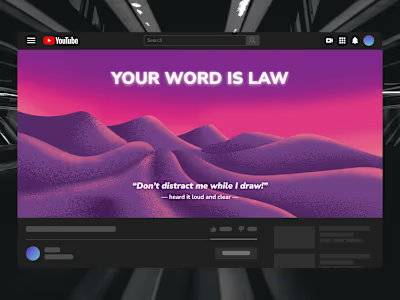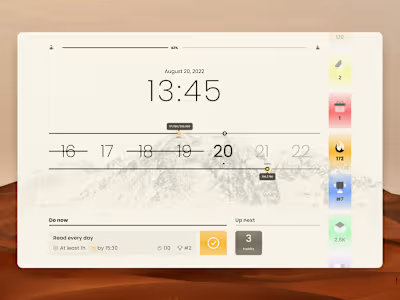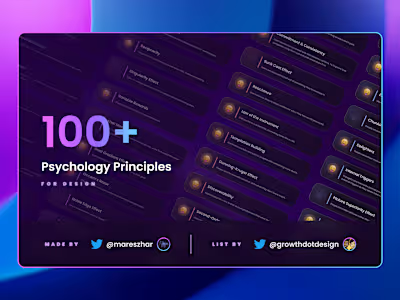Verse: Sing Your Way to Language Fluency

1. Working hard does not guarantee success
I once met a devoted language learner.
He had a 2,000-day Duolingo streak. Knew over 2,000 kanji. Studied Japanese for hours every day.
Yet, he couldn't do much in Japanese.
He couldn't write. He couldn't read. He couldn't speak.
That dedicated learner? It was me.
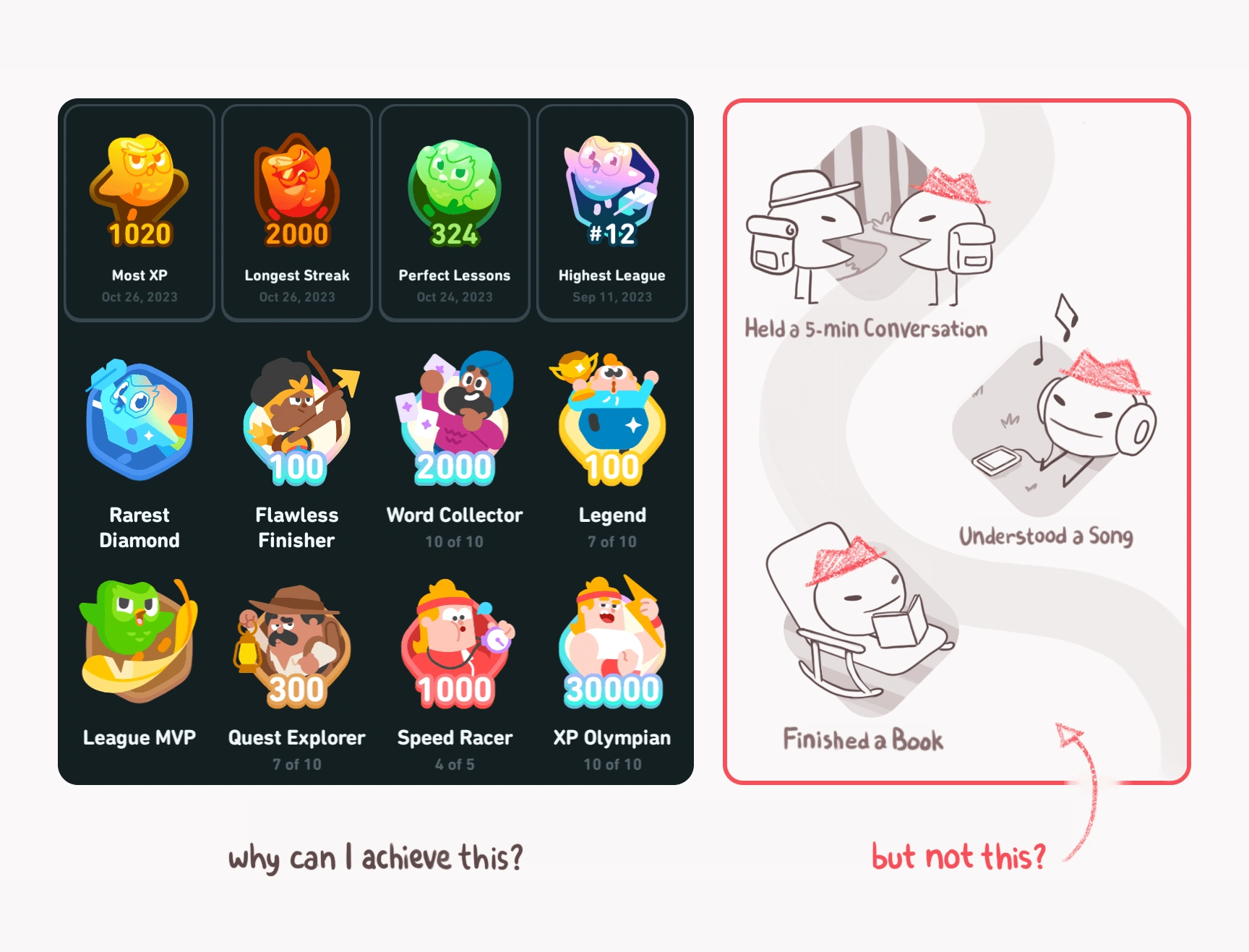
(after acing all of Duolingo and WaniKani, I could barely do anything with Japanese in real life)
What went wrong?
Why do so many language learners, like myself, spend years studying a language without ever acquiring it?
Lack of consistency and effort explain many failures. But, as my story illustrates, dedication without the right approach is doomed as well.
What, then, is the best way to learn?
I had to know, so I dove deep into the science of language acquisition. I deconstructed every learning method, resource, and app.
I set out to find a solution that never fails to help language learners achieve their goals.
Today, I want to share the answers I found with you.
2. Existing solutions aren't juicy enough
Languages have juice.
The juice is all the movies, songs, books, people, and opportunities those who speak it unlock.
The juice is the reason you learn a language in the first place.
But, there is no convenient way to learn the juicy stuff in a language.
We want to be able to speak, read, listen, and write, but existing solutions don't make us do any of that.

(most solutions for learning languages don't expose you to the juicy stuff at all)
When I embarked on this project, I didn't intend to create a great product for learning languages.
I just wanted to find one.
I tried one hundred of the world's most popular language-learning solutions.
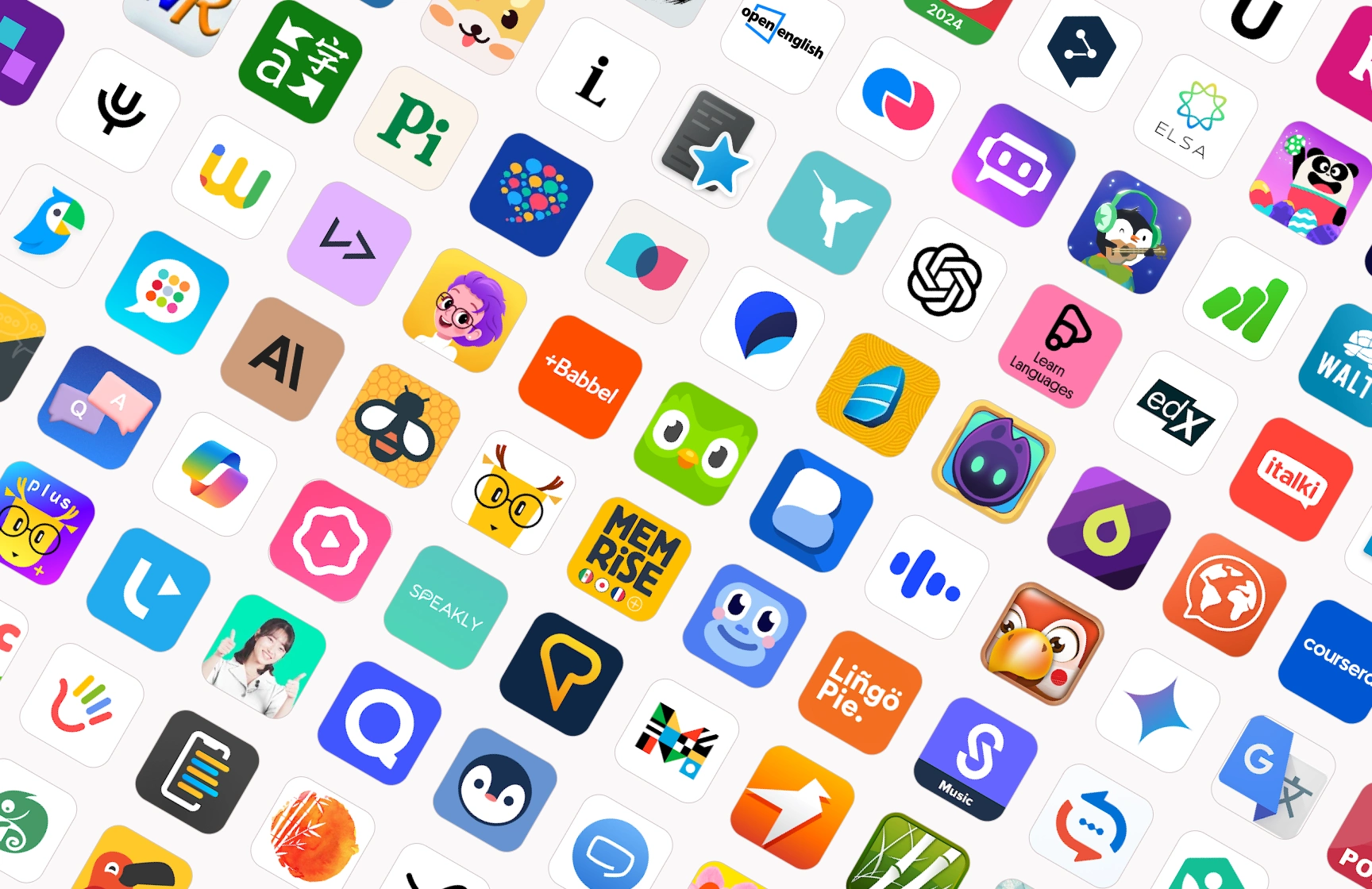
(some of the products I reviewed)
But none of them was complete.
Learning a language is a cycle with 3 phases:

However, none of the 5 most common types of solutions cover the learning cycle in full.

(lesson-based solutions (whether via apps or physical institutes) are the most common by far)
Most striking to me is the widespread neglect of the "applying" component of learning.
While language institutes occasionally make students write short essays or practice conversations with a partner, the most popular language learning tools never challenge students to output words and sentences of their own.
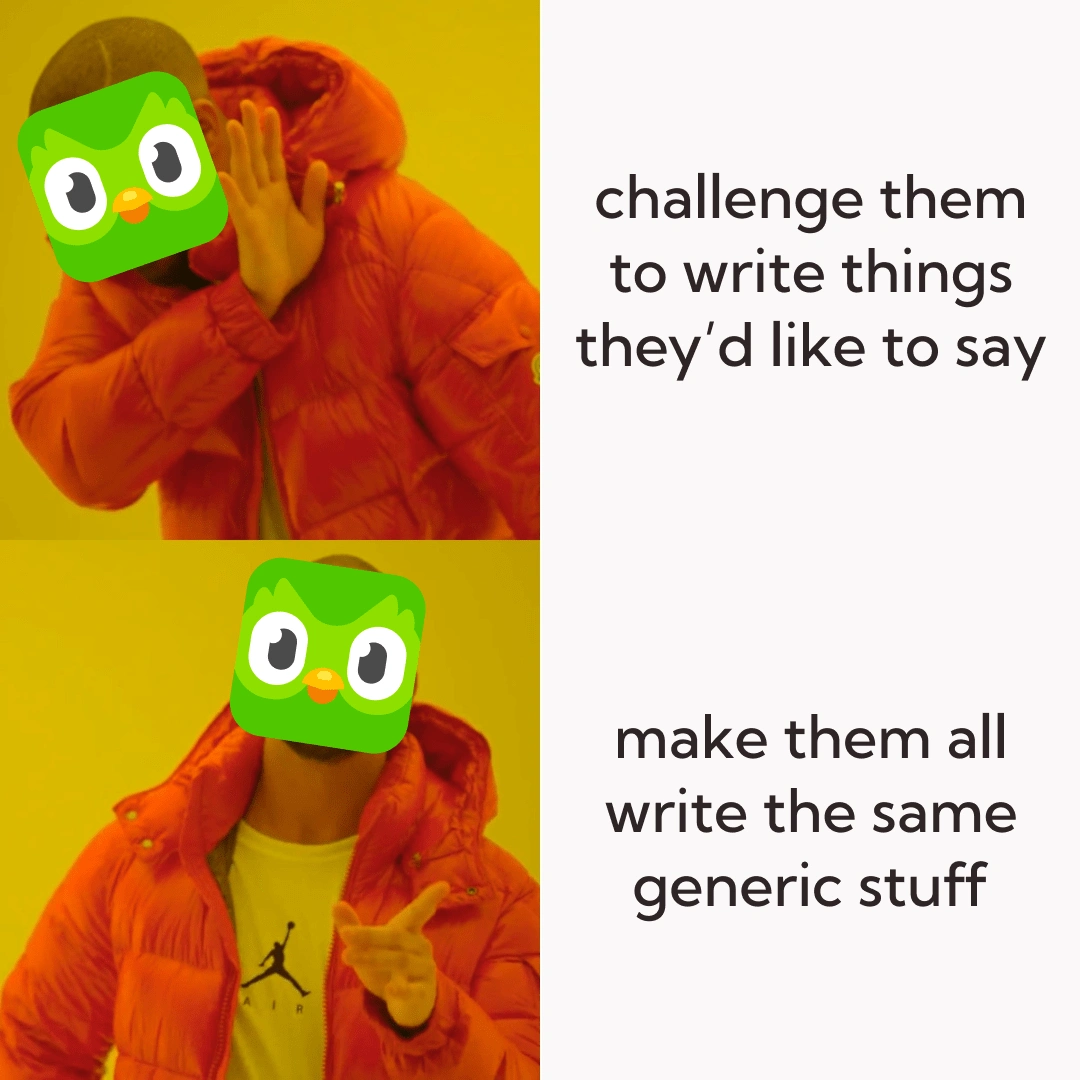
(this is basically all apps, sadly)
Similarly, although most solutions have some "reviewing" component, exercises are so heavily assisted they're almost useless.
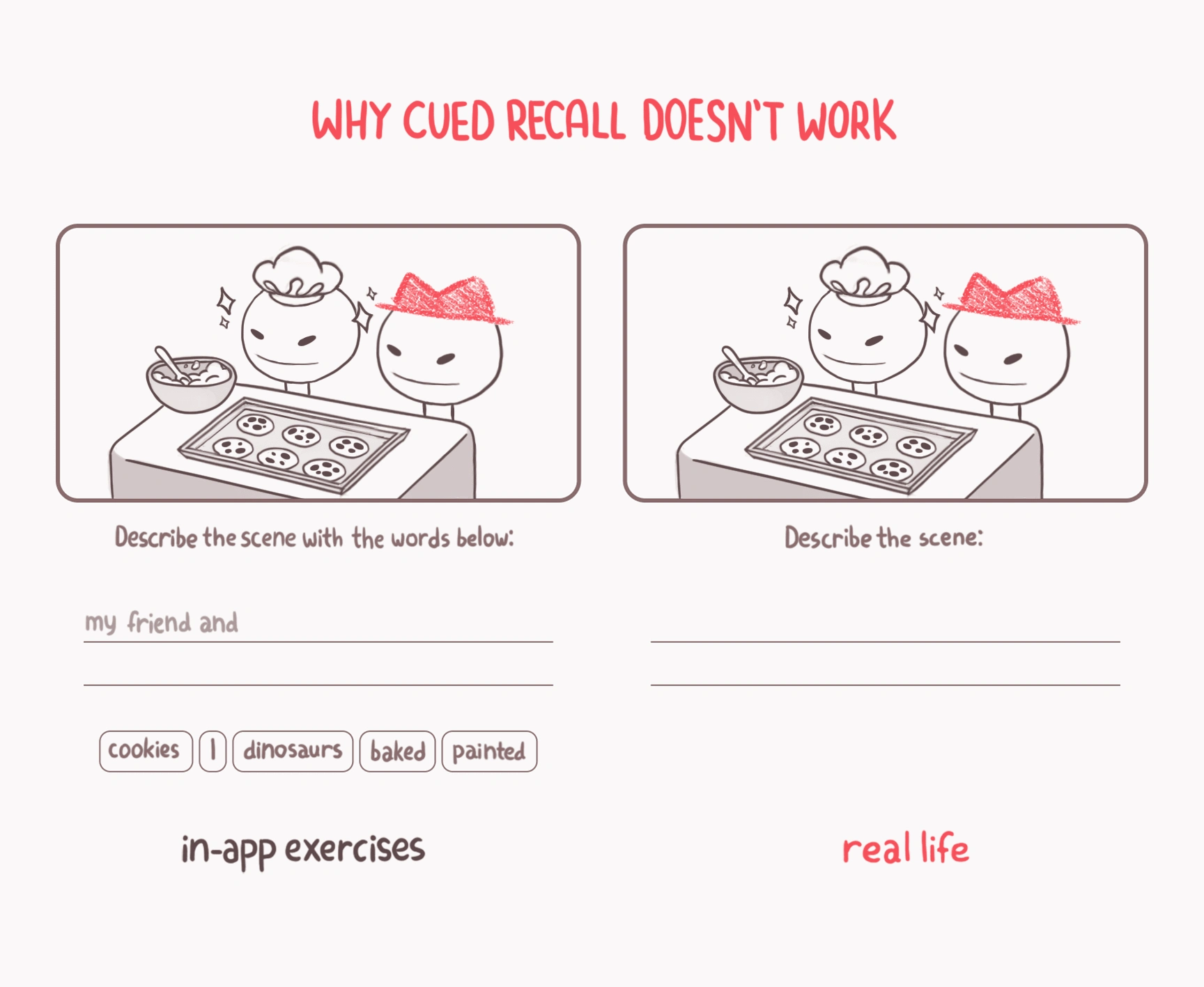
(bringing a few relevant words to mind from all the vocabulary you know is half the challenge)
Having easy exercises is not bad.
But the key to effective difficulty progressions lies in gradually reducing assistance, not simply giving students longer sentences.

(most solutions never stop giving cues, like word pools or other hints)
Last, although most solution types have features to help students understand the learning material, they're often incredibly limited.
Only chatbots excel at earnestly answering any questions one may have. With such responsiveness and versatility, they're probably the best language-learning solution today.
Still, chatbots fail where others don't, lacking any mechanisms for tracking users' familiarity with specific words, unable to help them refresh their memory at optimal times.
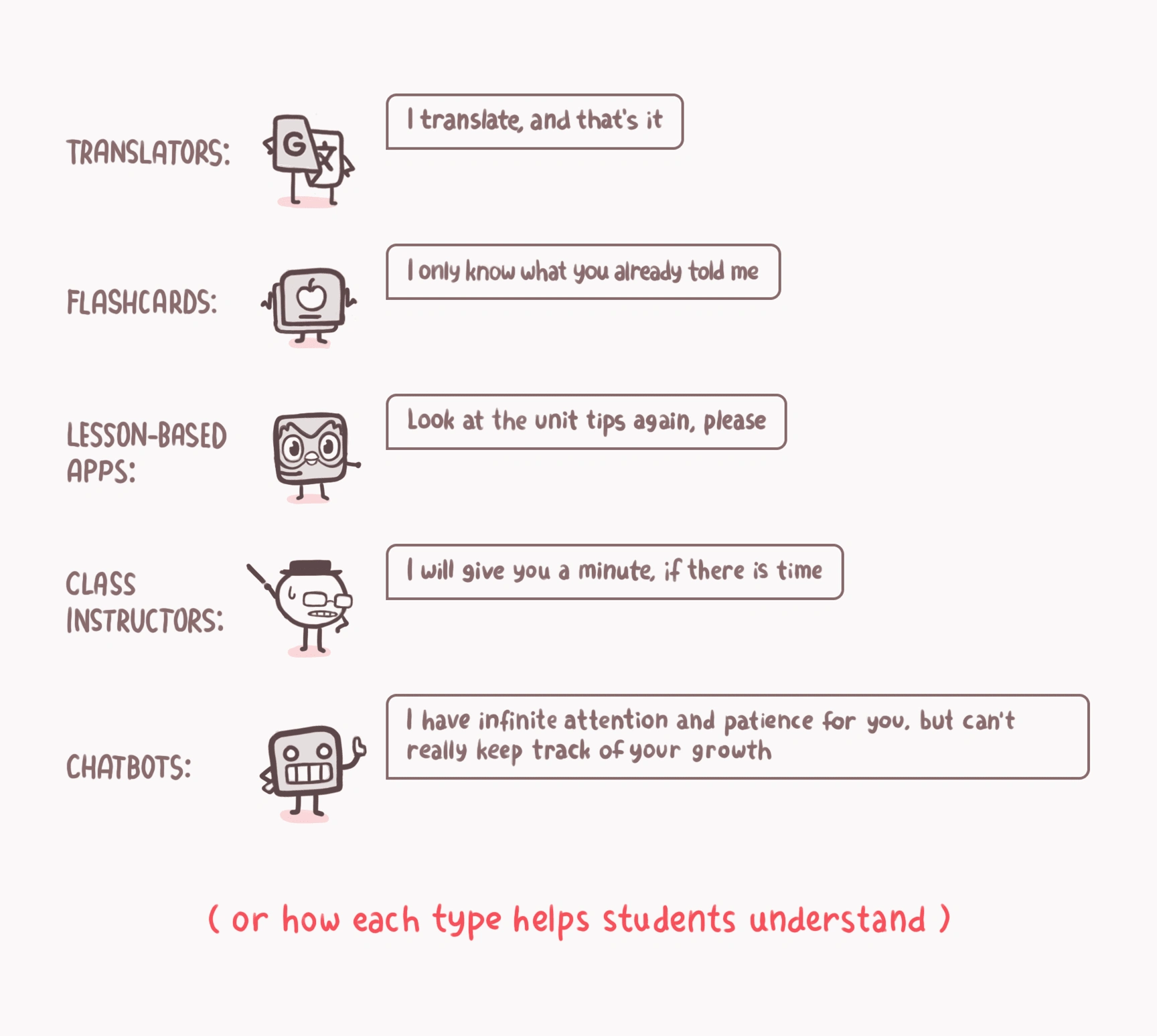
But, even if there were a solution that took full care of all 3 phases of the learning cycle, it still would be incomplete without the juice.
Or how enticing does this sound?

It's crazy, isn't it? We learn languages to listen, speak, write, and read juicy stuff. Yet, most solutions never get us to practice doing exactly that.
We're learning how to swim without ever dipping our feet in water.
No wonder, when we are thrown into the sea (like when we suddenly have to maintain a conversation or understand native content), we drown!
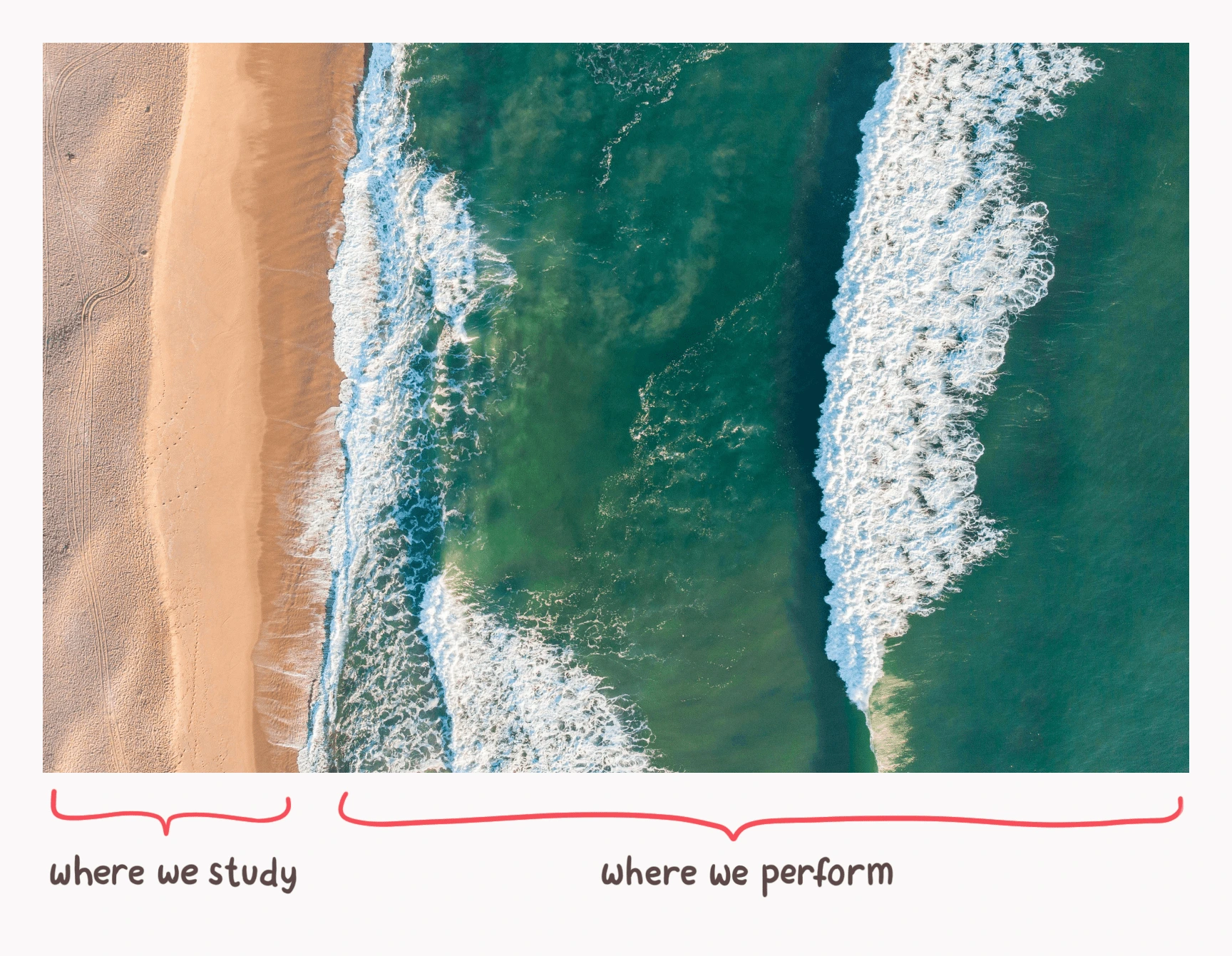
We need a juice-based approach to learning. Or as it's most commonly known: Immersion.
To learn through immersion, you can start in shallow waters first. Then, go deeper as your confidence increases. But you're always learning how to swim in water (and that's why it works!)

Now, you might be wondering, aren't there any immersion-based solutions for learning languages?
There are.
Some are prohibitively expensive or implausible for most (like moving to a country that speaks the language you're trying to learn, or going on a month-long fancy bootcamp-like retreat.)
The rest (the software-based ones), suffer from the same learning cycle lacks as their non-juicy counterparts:
No applying component.
Overly assisted reviewing exercises.
Poor features for understanding the content one is learning.
And more.
It's not that immersion-based apps can't be good for all 3 phases of the learning cycle. It's just that existing ones aren't.
And so, my search for a great solution for learning the juicy stuff in a language returned 404.
It was only then that, empty-handed and longing for something I wished existed, I decided to design my own.
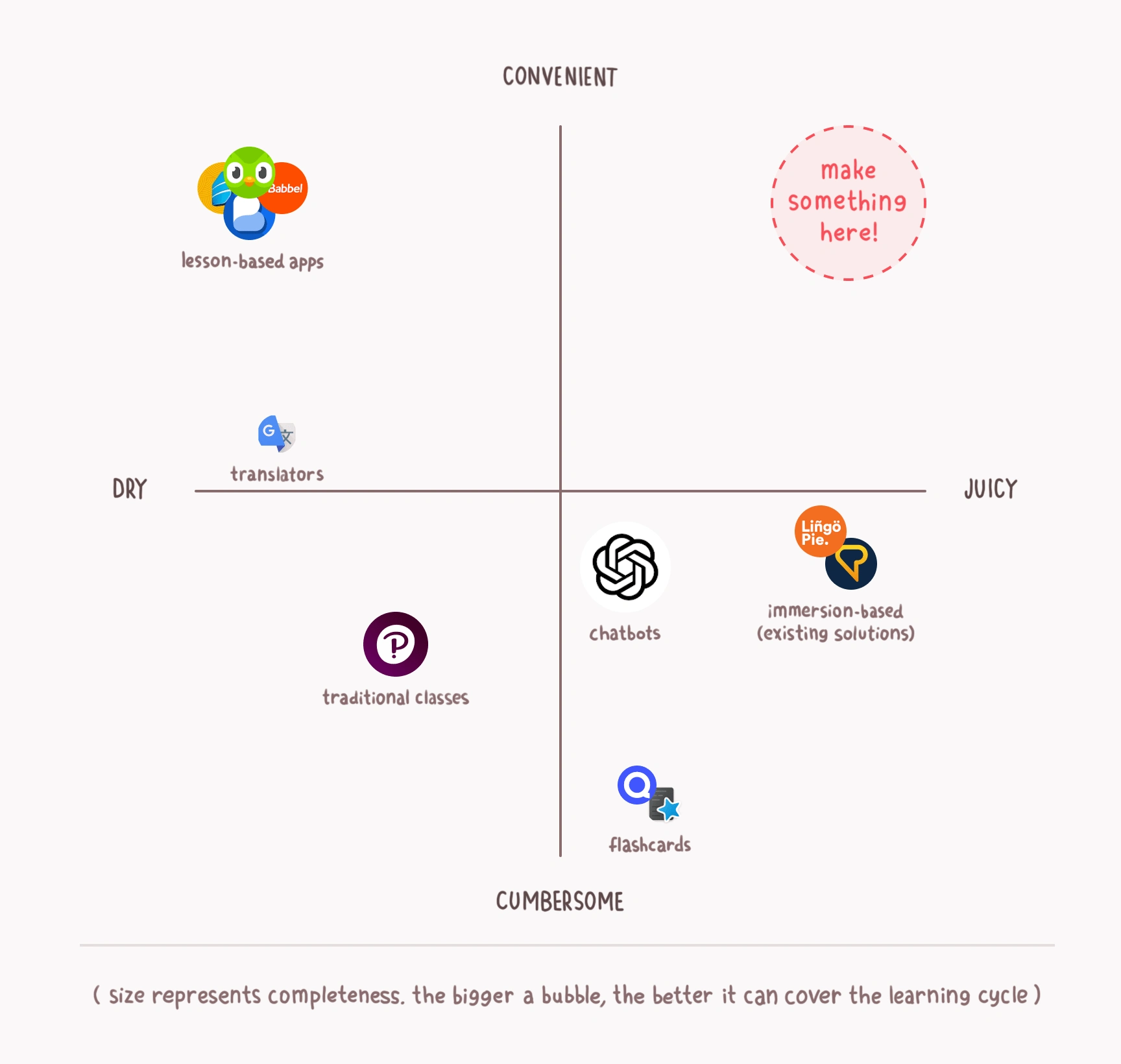
3. We need a more complete (and juicier) tool
In essence, my new goal was to create a convenient juice-based solution that took elegant care of all 3 phases of learning.
To guide my design, I strived to imbue it with these 5 qualities:
🌎 Practical:
Real-world content from day 1. You learn with the materials you’d want to understand or consume anyway.
🚄 Efficient:
Minimal and fluid design that's there when you need it, and not when you don’t. Shortcuts and workflows help you fly through your study sessions.
💪 Effective:
Zero exercises that don’t work or do little to challenge you. Strong emphasis on realistic application of the things you learn until you own them.
🤩 Motivating:
Get a clear sense of progress towards the goals you set. Every small step counts, so sessions always end with a summary of what you achieved.
🧩 Flexible:
Smart defaults offer a great experience out-of-the-box, but there's ample support for customization. A modular architecture makes it easy to add features.
4. When the task is huge, start small
The juice is diverse. It spans all sorts of content types (eg: podcasts, vlogs, articles, etc.), and interactions (chats, video calls, impromptu conversations, etc.)
Each juicy thing comes with its own set of challenges and technical implications.
To keep things simple in the beginning, I decided to focus on a single type of juice: songs.
Why songs?
Songs are bite-sized. Compared to books, movies, or podcasts, it's much easier and quicker to learn a song. That could help engage and motivate an early user base.
Repetitive rhythms and melodies make songs very memorable. As a result, it's easier to recall examples of particular words and expressions in context.
Delivering a rich catalog of songs is simple. It could be done through either YouTube embeds or integrations with popular music streaming platforms, like Spotify.
Starting with songs does not require any initially strong network effects to succeed. Other juice forms, like conversations, may require larger user bases to take off.
Songs offer excellent exposure to diverse voices and native pronunciation examples. For other media, like books or articles, adding or finding natural narrations can be expensive.
But, since the end goal is to build a complete juice-based solution, I kept all other juice types in mind throughout my design.
The solution I will present here focuses on songs, but I designed it in such a way that adding other juice types later won't require a whole refactoring.
New juice types can be seamlessly added as the platform evolves, and they will both nicely fit in as well as benefit from the existing features.
5. If you want to create great products, service people who inspire greatness
The product I made is not for everyone. And, it doesn't try to appeal to everyone either.
It's not your typical "feel good about yourself for studying 5 minutes a day" offer. Those create the illusion of progress but take you nowhere.
Learning a language takes time and consistent effort.
The solution I made is intended to give a powerful boost to those willing to put in the work.
Though it's oriented to people who already have strong internal motivation, I've been careful to design a fun, motivating experience that helps those users keep an eye on their goals and maintain the intensity of their drive.
After all, everybody needs a break sometimes. And, everybody can benefit from an extra push.
6. Answer the questions that come to mind, then you will understand
Here's a mysterious line in a language you (probably?) don't speak.

Let's say you dream of being able to create and interpret lines in that language on your own.
To start, you could check the meaning, in context, of every word you don't understand.
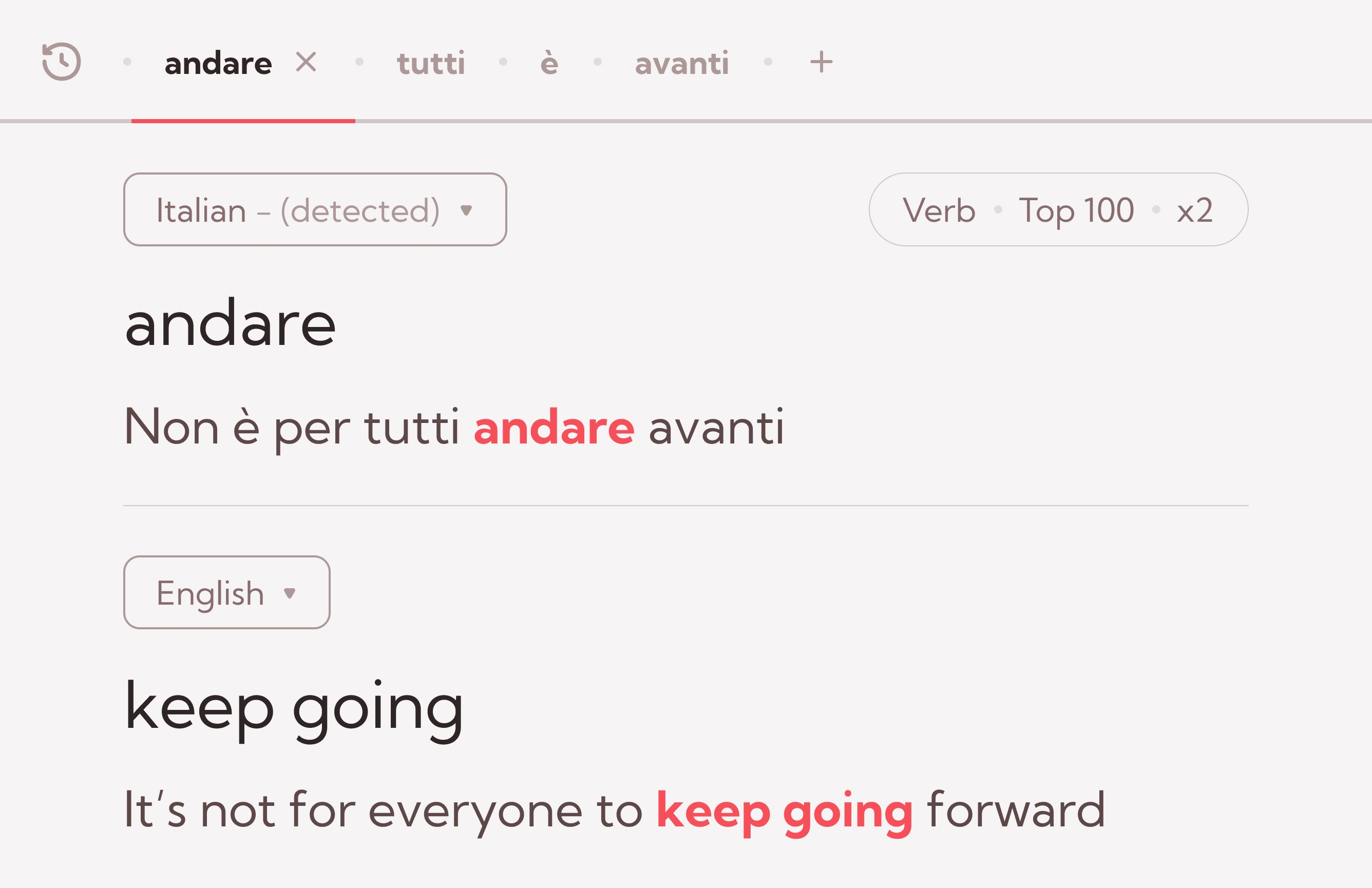
If you don't want to miss any nuance, you could also ask an AI (that knows where that line appears) for a more detailed explanation.
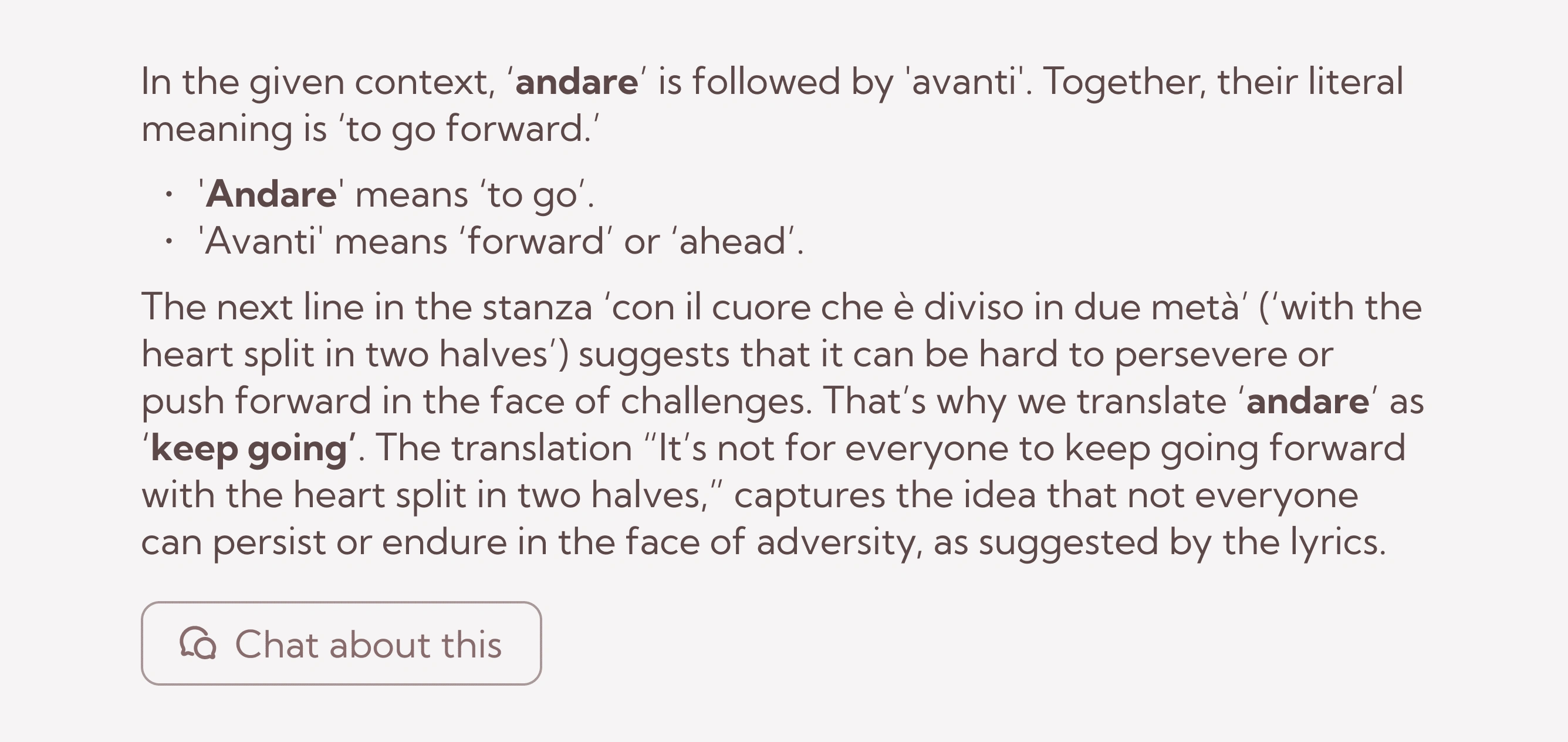
That might be enough in most cases. But, if you wanted, you could go deeper.
You could, for example, ask an AI about the differences and similarities between that word in the language you're learning, and its counterpart in a language you speak.
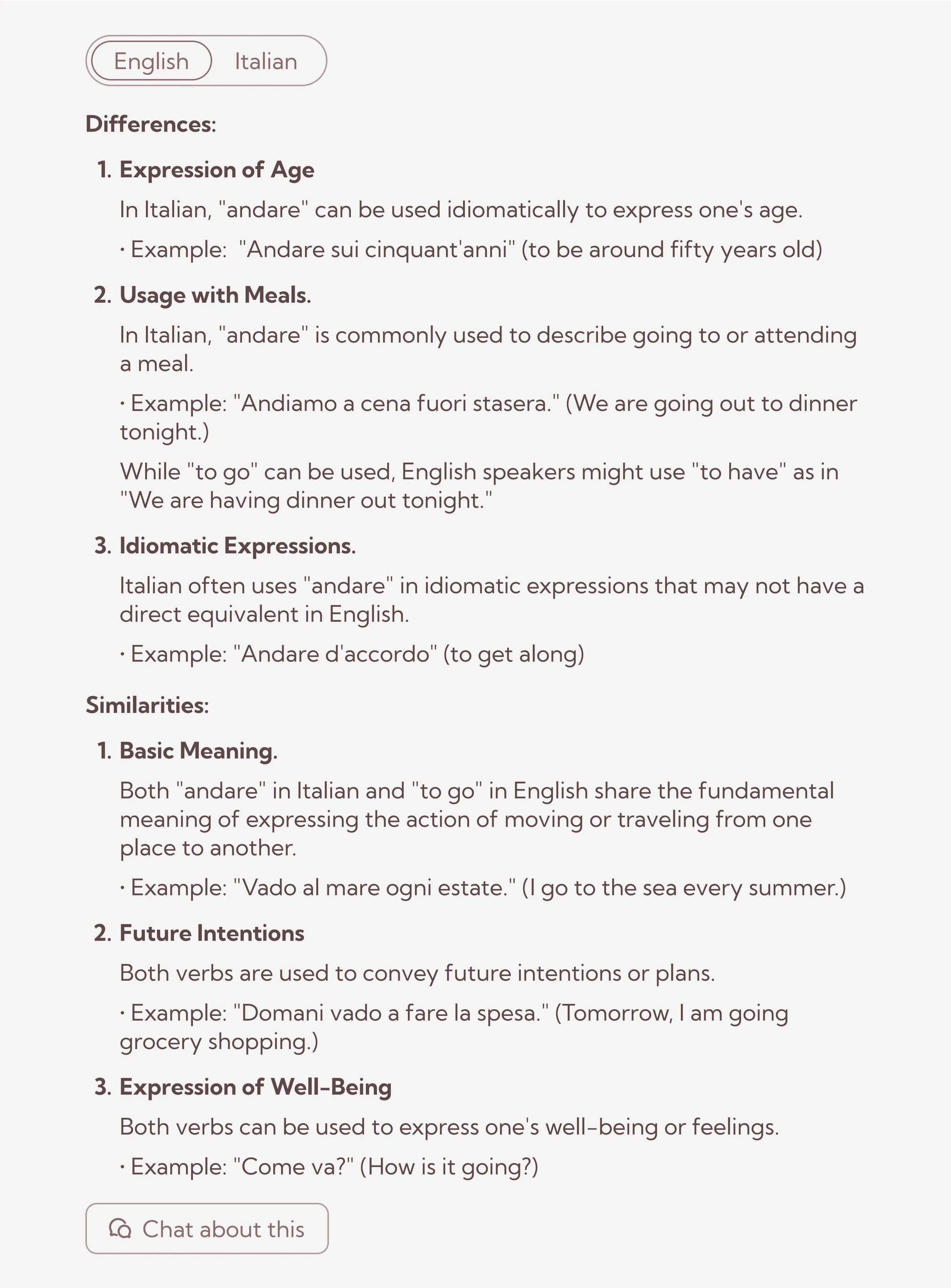
(you can easily check the breakdown in your native language, or in the language you're learning!)
If you were feeling curious, you could also check the original dictionary definitions for that word, along with other cool stuff, like synonyms, antonyms, and usage examples.
In most cases, you would have to translate those definitions to your native language first and consult many dictionary types, like a thesaurus, to get all of the above. But not here!
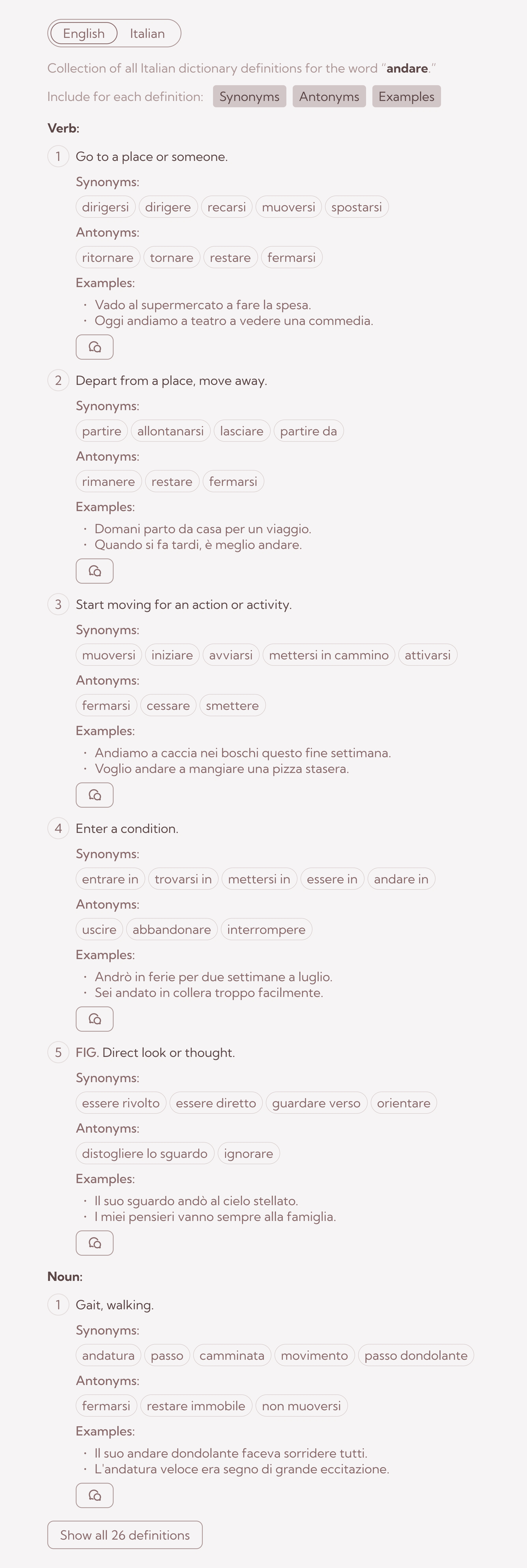
(don't want to see, say, antonyms? just use the filter buttons to get a view that's as clean/rich as you need!)
Now, you may be familiar with the meanings of a word in English, but might not know which words capture those same meanings in a new language.
Wouldn't it be handy to have a list with all those "closest alternatives"?
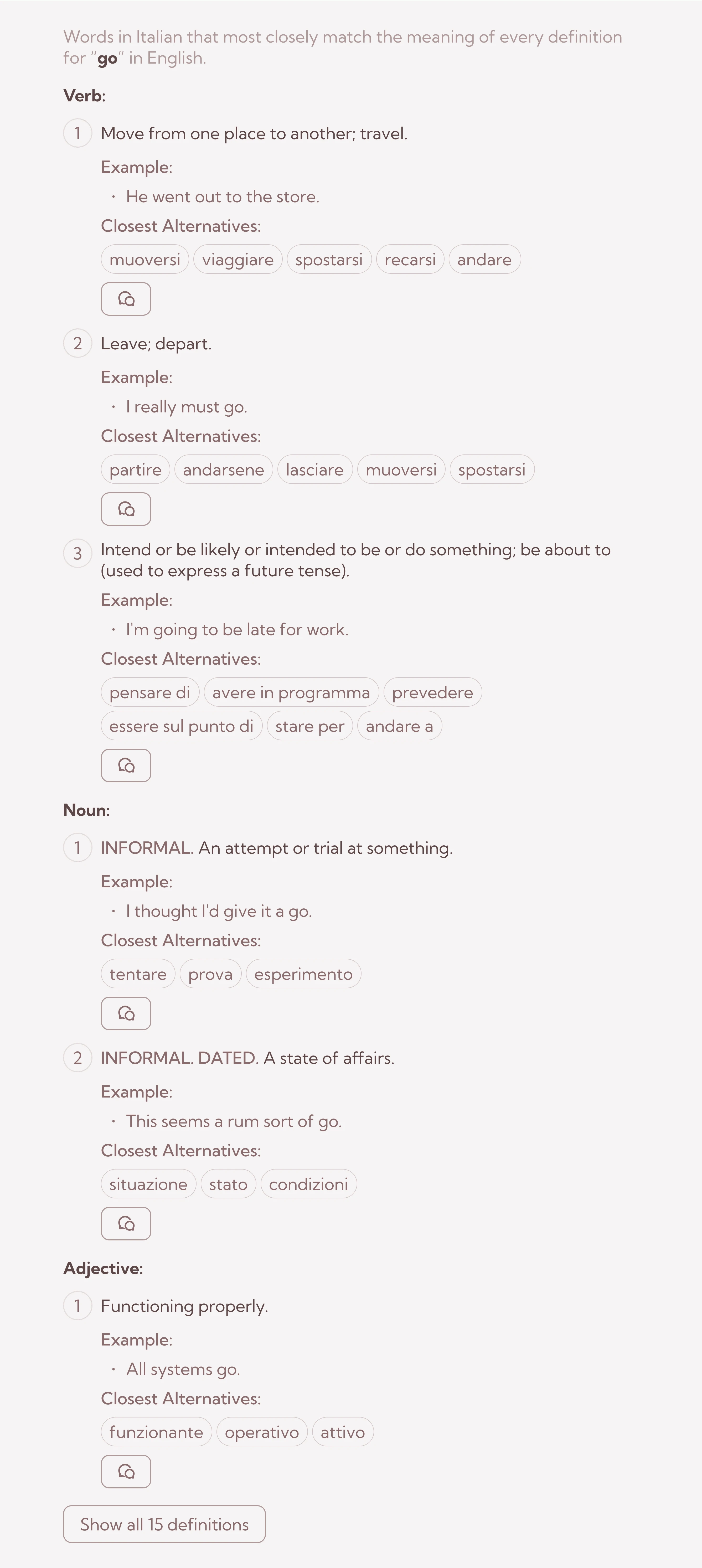
While we are at it, a word "A" in a new language could, in theory, be translated as many possible words ("X", "Y", "Z") in our language. But, that doesn't mean it's the most natural translation for all of those.
To see what the most natural translations are, it'd be nice to have a frequency-sorted list, where "A" is listed first if it's the most natural, or later if it isn't.
Like this:
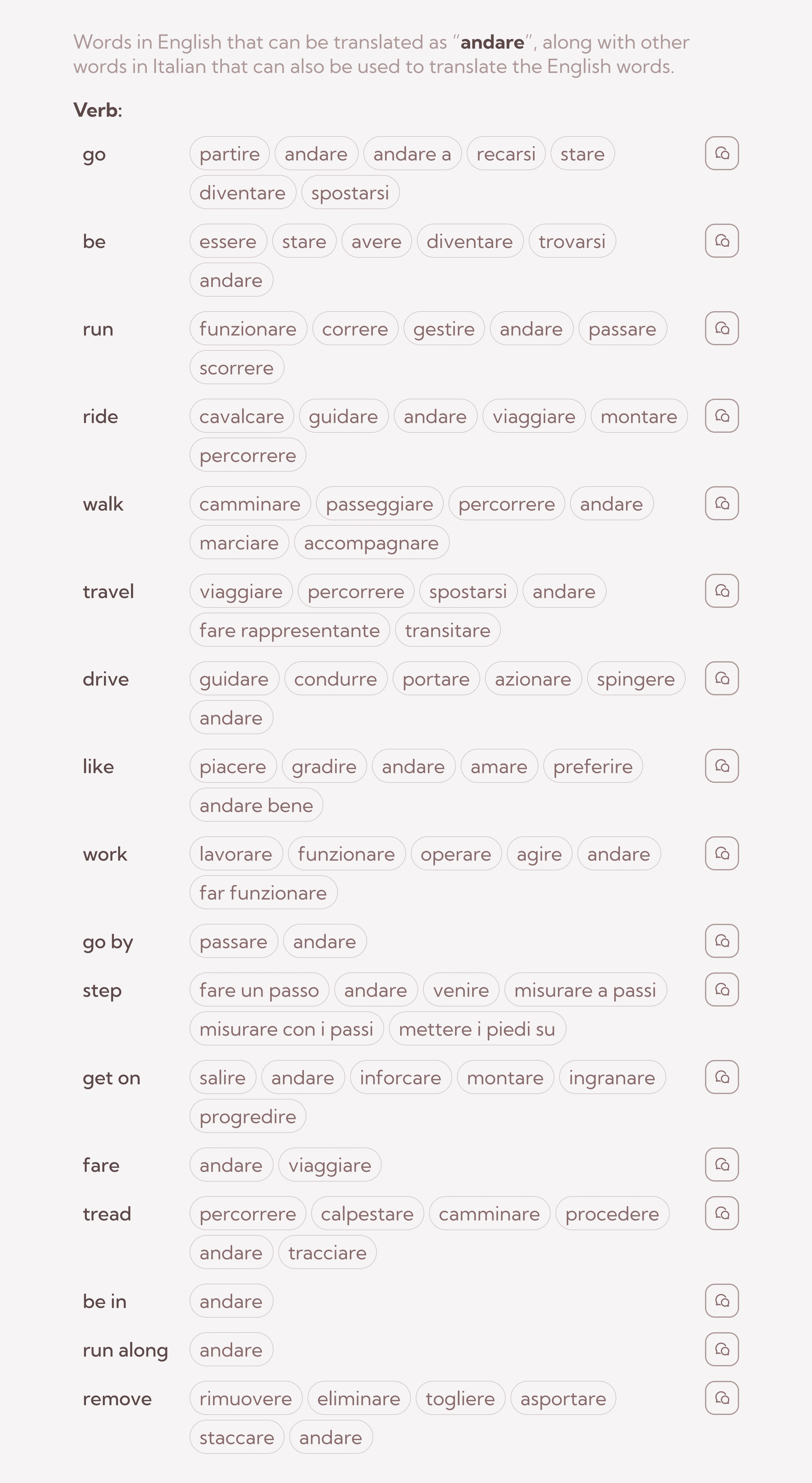
(this makes it easy to see "andare" isn't always the most natural translation)
Wow! With so much information, we'd better have a place to note down any realizations we had that we wish to remember.
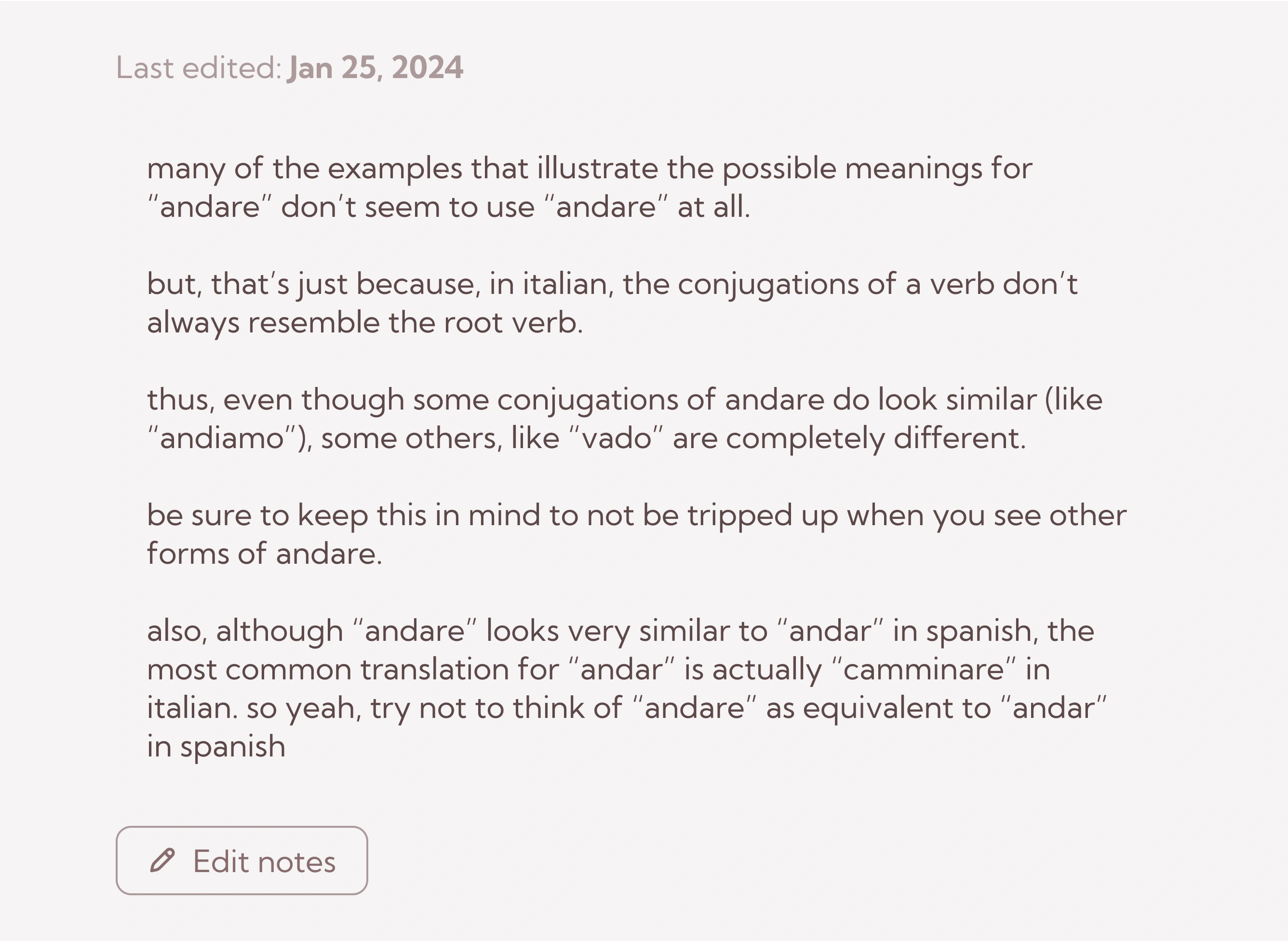
By now, if you were trying to achieve all of this with existent tooling, you'd have:
A very long conversation with your preferred chatbot (with a lot of prompting!)
Or about a dozen tabs open (with lots of different dictionaries, translators, and searches)
In contrast, with Verse (the app I designed), students never have to switch contexts nor waste time asking for frequently needed details.
But, they don't have to go through all the sections I showed you either.
I put them all into an accordion, so they can easily expand just the sections they need.
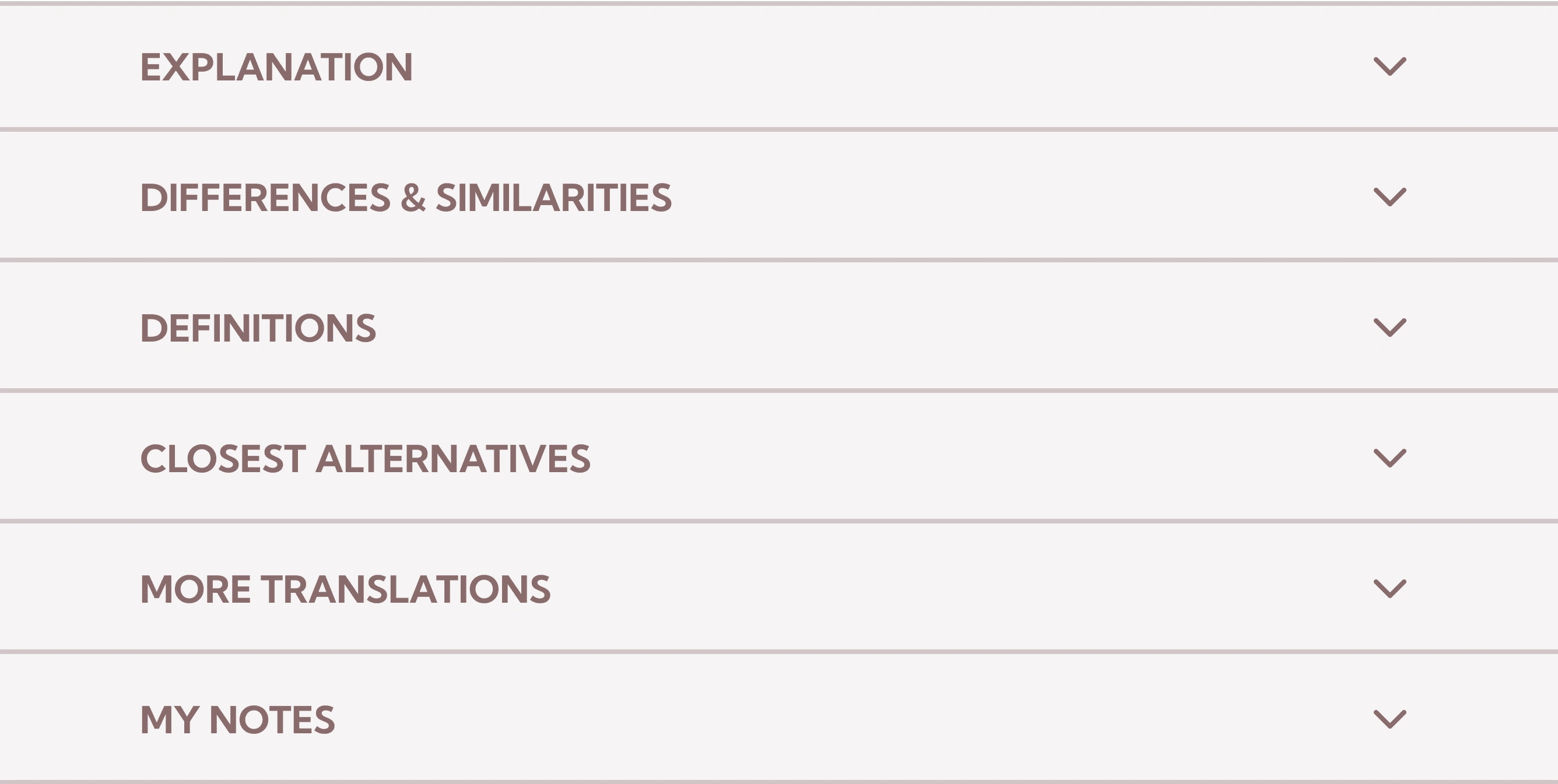
This architecture is also very flexible.
As the app develops, new sections can be seamlessly added to the stack.

Similarly, sections could be smartly included or not based on whether students are translating a single word, or a phrase, or even based on the content's language.
For example, if a translated word is in Japanese, there could be a section that shows students the meanings and readings of each kanji in the word.
Other sections could teach their "radicals" (a kanji's components), and the stroke order typically used to write them.

This pattern is so powerful there could even be a section for users to add their own.

Let's say, for example, that I am a lyricist and want to get exposure to words that rhyme with the words I translate. In that "custom section", I could enter a prompt like: "List 5 words in {{ the language I am learning }} that rhyme with {{ translated word }}."
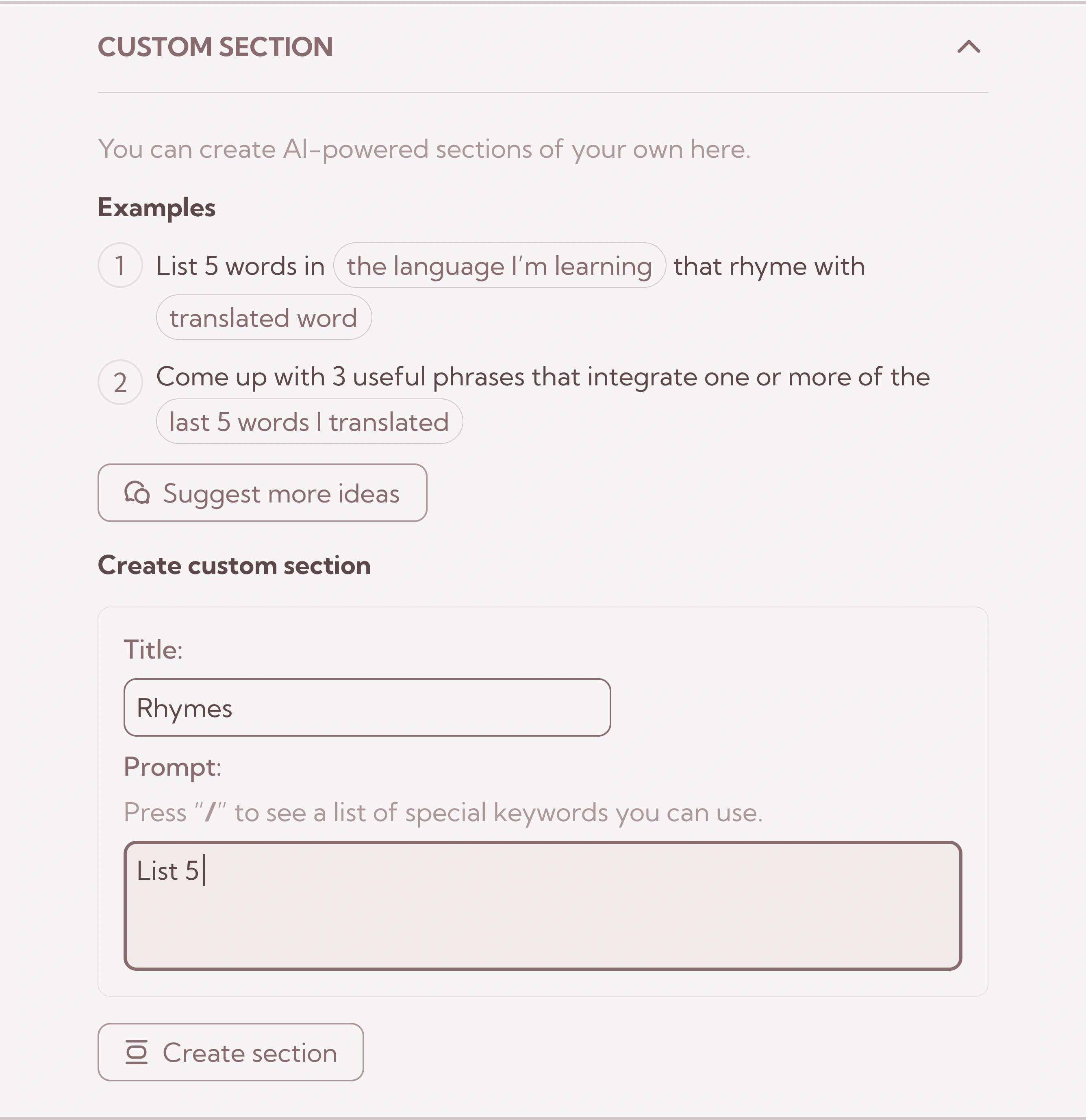
(users can press "/" to see available keywords, and easily enter them)
Then, the app would create a new section for me that does exactly that.
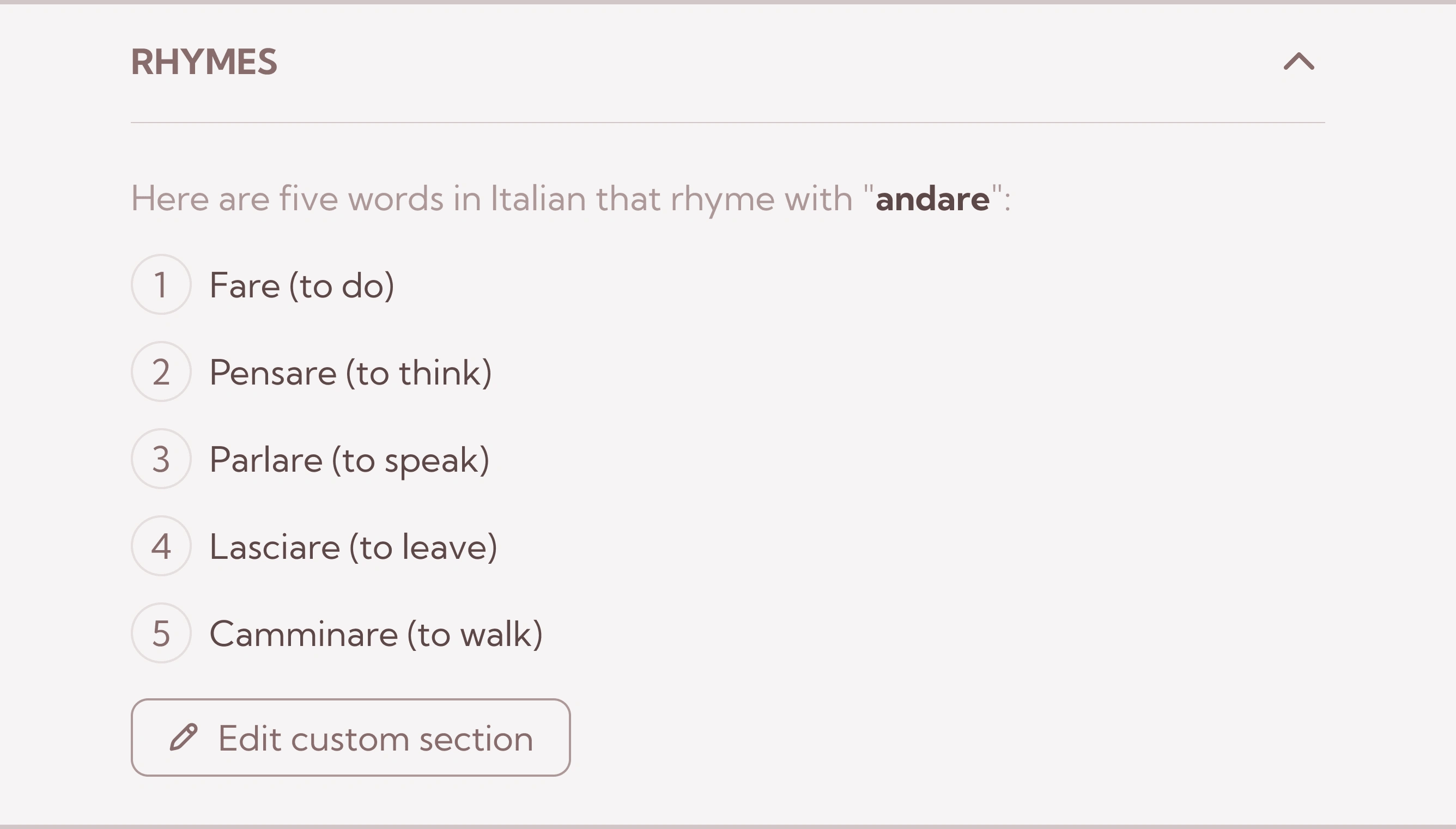
Of course, not all the sections I showed you can be reproduced with AI prompting alone.
Still, support for custom sections can solve many use cases, sparing students the need to repeat themselves for things they typically want to know.
Finally, if they wanted, they could save a word to review and practice it later.

(the level indicator to the left lets students check or update their familiarity with a word)
And where do all these sections live?
Right next to the content you're trying to understand!

(simply highlight the words or phrases you don't understand to translate them)
What you just saw is a key layout pattern in Verse:

The workbench area has the stuff you're studying. And, the modules pane has modules that augment what you can do with the stuff in the workbench.
What are modules?
A module is a set of sections or features with related functionality.
For example, the sections we explored earlier make up what I call the "Translations" module:
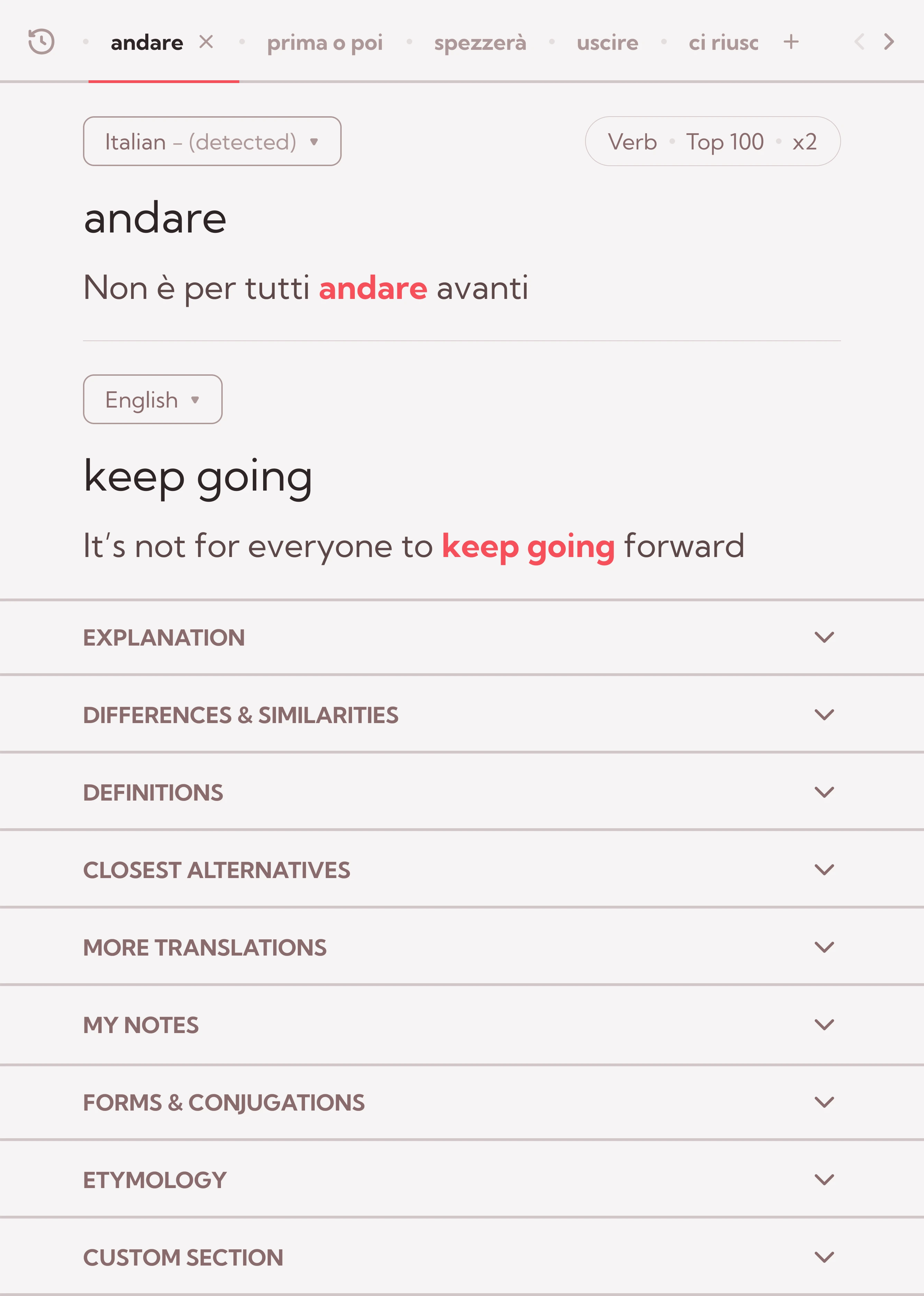
(the "Translations" module, with all its sections collapsed)
But, there are other modules too.
Like the "Ask AI" module, where you can chat with an AI that has access to:
The material you're currently studying.
And every detail about your journey with Verse (like how fluent you are in a language, which words you know, which words you're studying, which words you struggle with, etc.)
The Ask AI module is perfect for clearing up any doubts the Translations module didn't cover.
Like the Translations module, Ask AI also supports module-level tabs, which means you can have multiple conversations open without having to create or switch between new browser tabs.
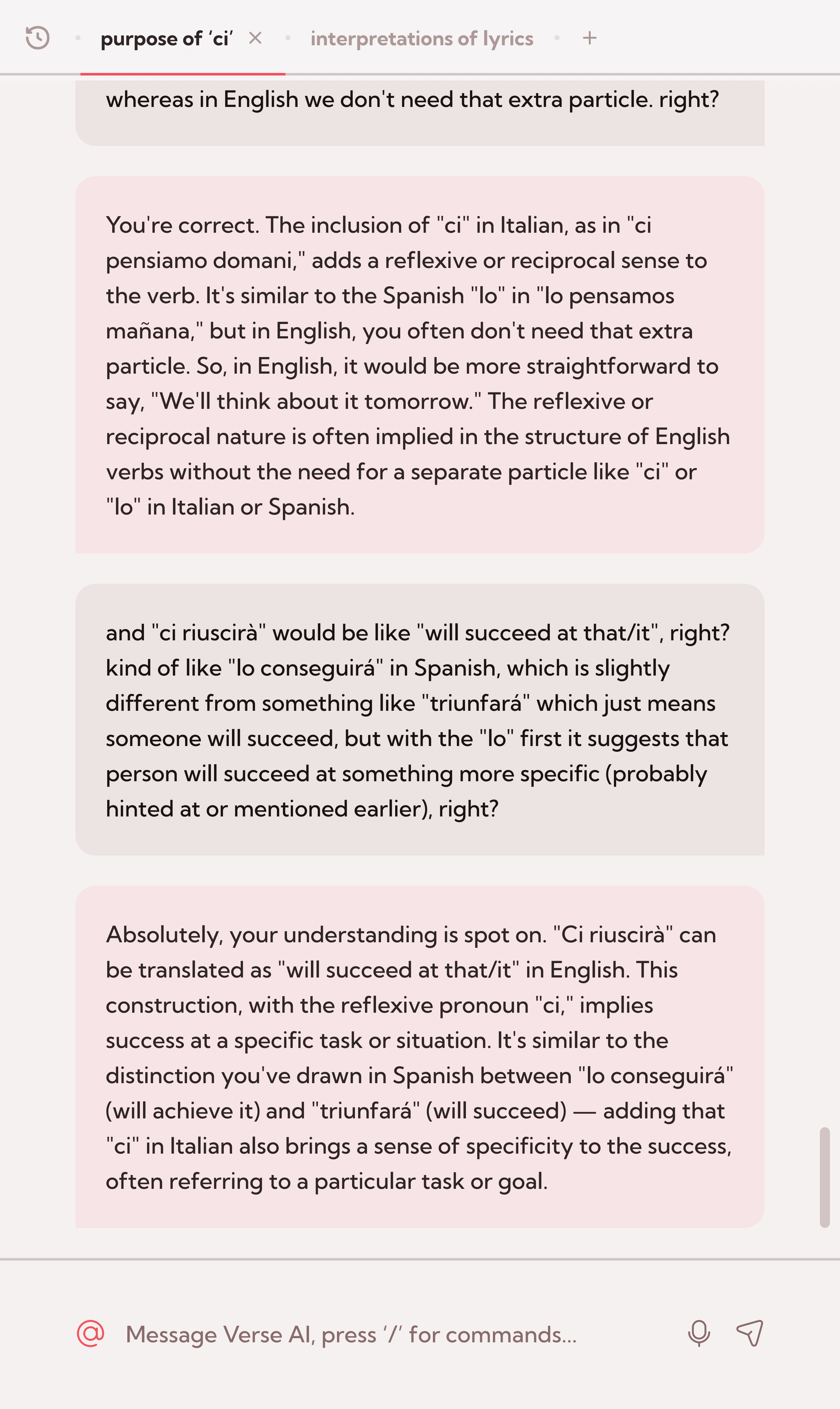
(with the icon in the top left corner, users can also manage their chat history, or jump back into any previous chat)
If you have an eye for detail, you might have noticed that several of the sections in the Translations module had a "Chat about this" button.
That means students can easily jump into a conversation where, behind the scenes, the AI is instructed to pay closer attention to that section, so it can help students with any questions they may have about it.
Also, upon pressing the "Chat about this" button, Verse will automatically pin the corresponding section. That way, users can see it and their chat in the same view.
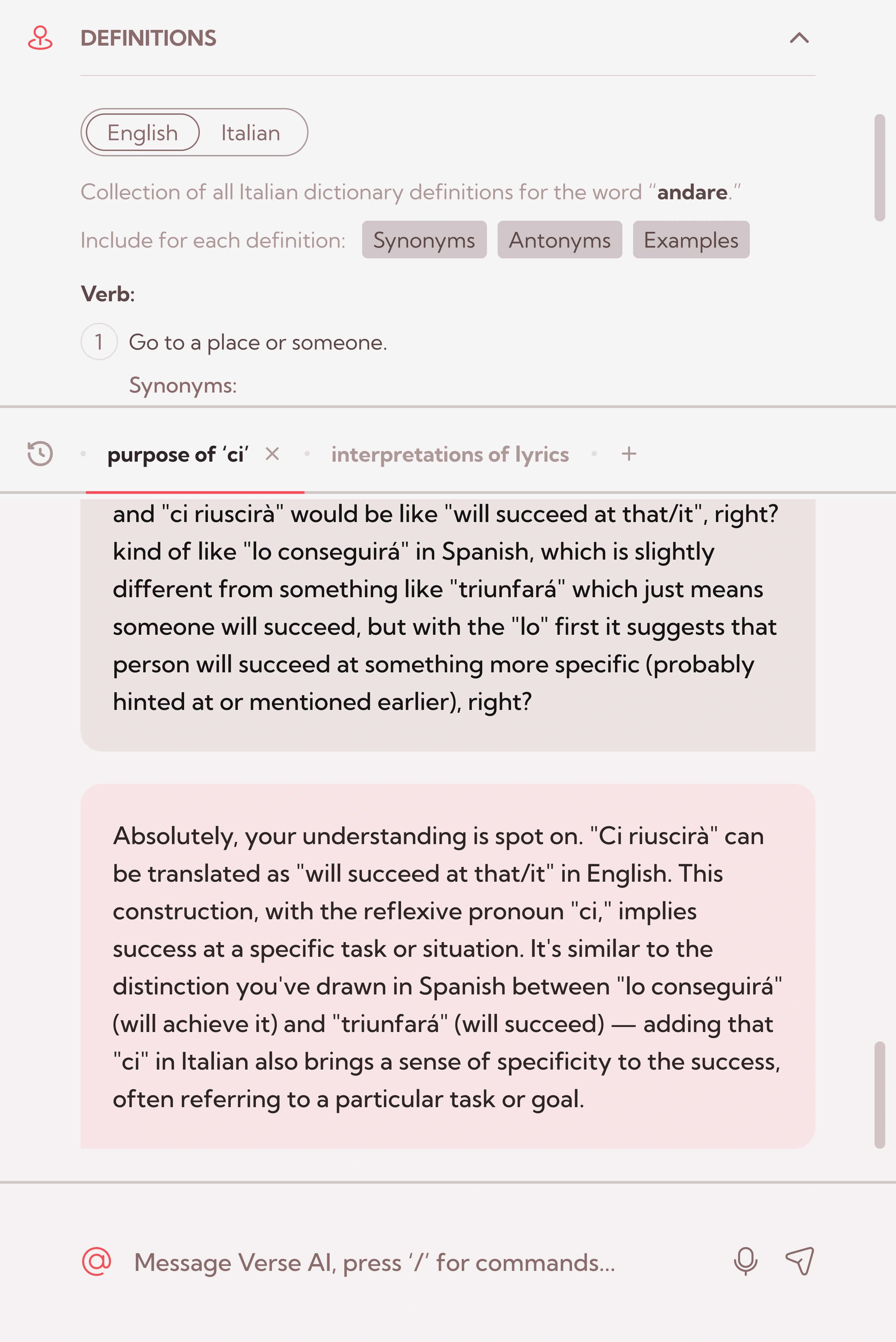
(pinning a section enables users to look at it without leaving the Ask AI module)
Another powerful module is the "Preferences" module.
The preferences module is the heart of versatility in Verse. It's packed with great defaults, but users can modify them to make Verse truly theirs.
The Preferences module is also grouped by sections, some of which let students customize the behavior of other modules too!
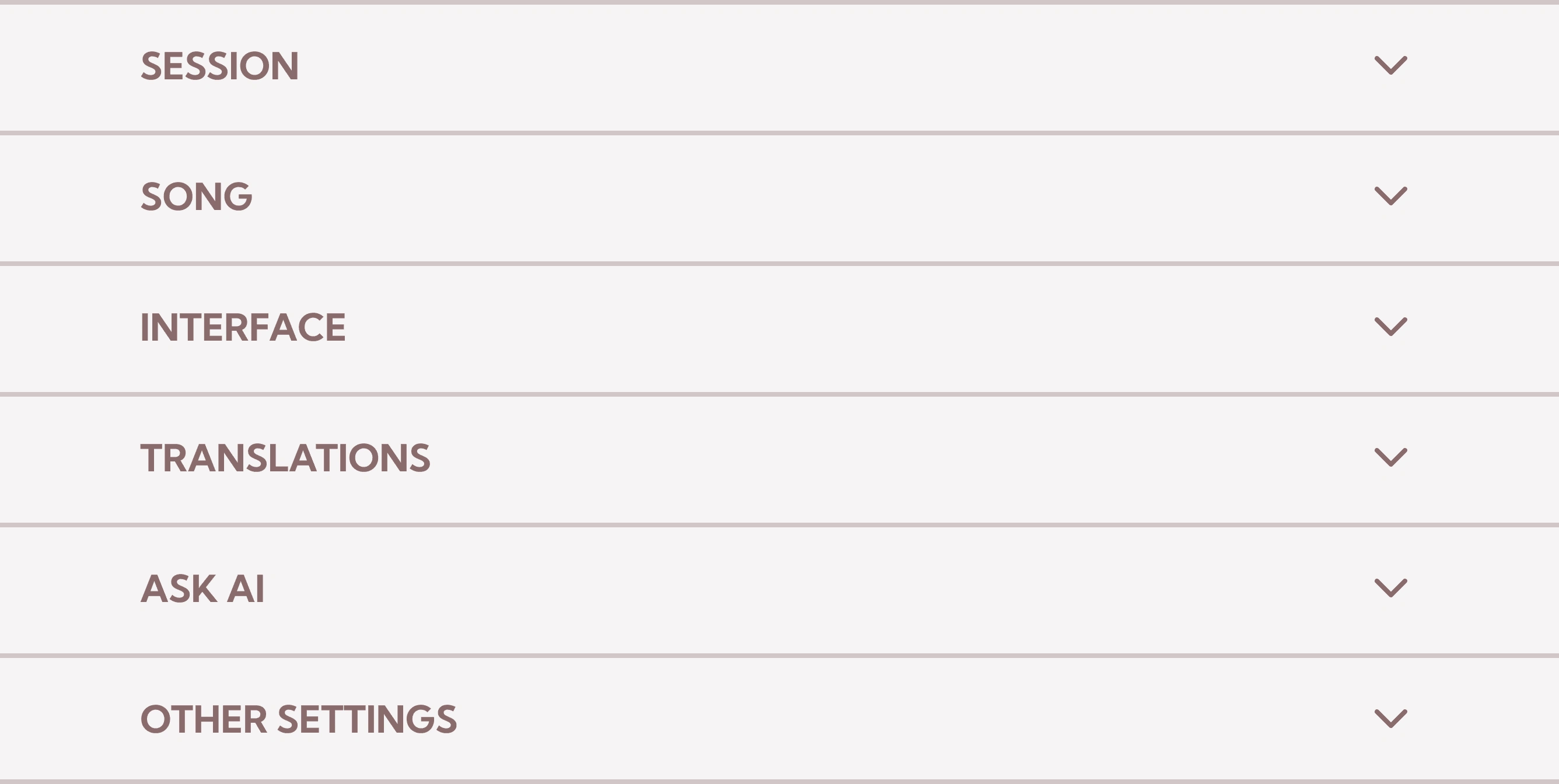
Let's look at the Song section, for example.
Options range from simple things, like choosing whether to automatically reveal translated captions for every line in the song, to more sophisticated ones, like showing ruby text (reading aids) only above logographic characters one isn't yet familiar with.
And, of course, there's also a comprehensive list of customizable keyboard shortcuts for power users. Keyboard shortcuts cover so many actions that it's possible to use Verse entirely mouse-free!

(semantically-related shortcuts also match to close-together areas of the keyboard!)
As I said, students can also configure other modules from the Preferences module.
They could, for example, choose which sections to include in the Translations module, which order they should appear in, and even which of them should automatically expand whenever they translate something!

(the mapping for the shortcuts here is also designed to fit in nicely with all other shortcuts)
And, of course, the Ask AI module is customizable as well.

(the '@' keyword is a powerful instrument when chatting with Verse AI)
The best part?
The Ask AI module also sits right next to the material you're studying.
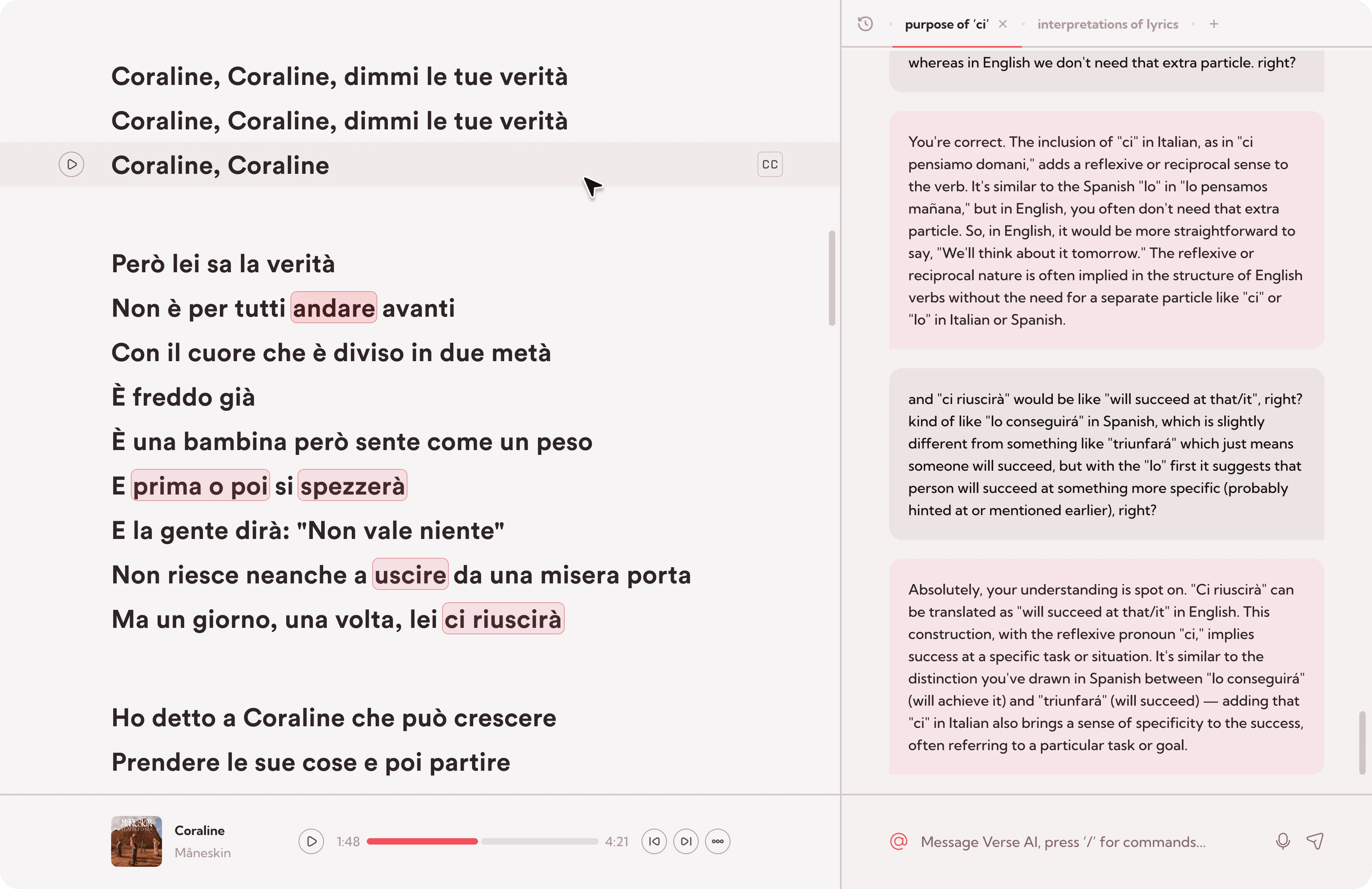
And so does the Preferences module.
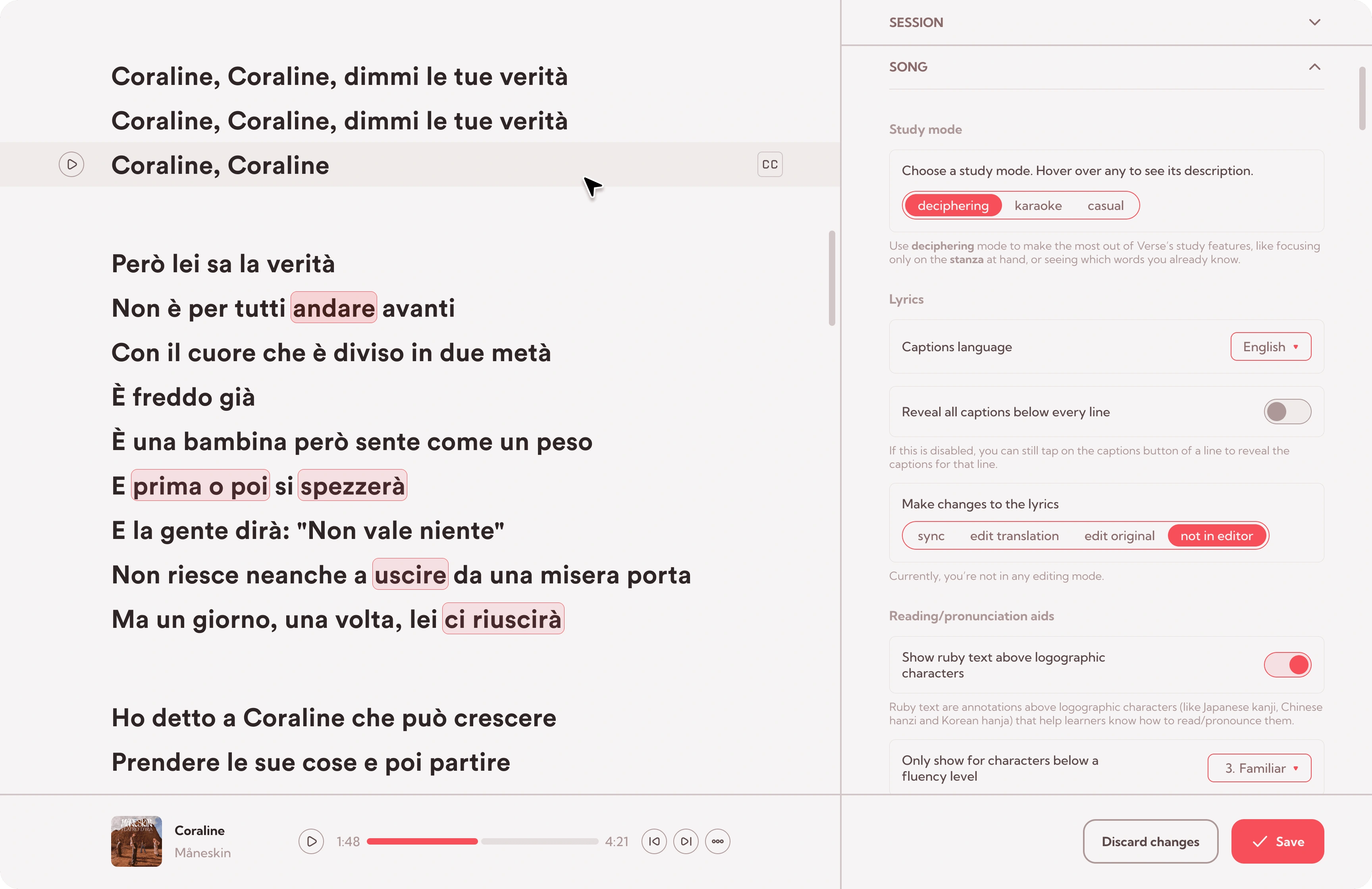
This is all possible thanks to a convenient navigation area that sits at the top of the modules pane. With it, users can easily go to any module they want, and all modules can show up right beside the working context without cluttering the UI.

I hope these captures gave you a better idea of the power and flexibility of the modules pane. Depending on the content or activity, different modules could be available (as we will see later).
Also, as the platform evolves, more modules could be added, like a "Speaking" module, where users could record themselves saying a line out loud, and then compare their pronunciation to either previous attempts or the official song audio for that line.
Having explored the modules pane, let's now step back for a moment and look at the workbench again.
Here's what a line from a song's lyrics looks like:

Hovering a line reveals buttons to play the song's audio for that line, or toggle captions for it.

(any of these actions can also be triggered with keyboard shortcuts)
Enabling captions reveals the meaning of the line, and copies the line's text to a new tab in the Translations module, in case students want to analyze it further.

Alternatively, if students want to check the meaning of a single word or phrase, they can highlight text to open any custom selection in the Translations module.

The purpose of all this translating and analyzing is for students to "decipher" a line.
Deciphering means that you not only understand a line's meaning but also have a rough idea of the role each word in the original line plays in creating that meaning.
When you watch a movie with subtitles, for example, your goal is not to decipher. You just want to get the meaning of the dialogue, and that's it.
When you're studying a language, on the other hand, and wish to eventually be able to create or understand lines on your own, your first goal is to decipher.
Now, Verse is designed to help students progress steadily toward their goals. And, a key part of that comes from showing them (clearly and often!) how every small step they take brings them closer to a bigger milestone.
In the case of songs, a "step" could be deciphering all the lines in a stanza, and a "milestone" deciphering a whole song!
When they feel ready, users can register a "step" with the button that appears when hovering in the blank space between two stanzas.
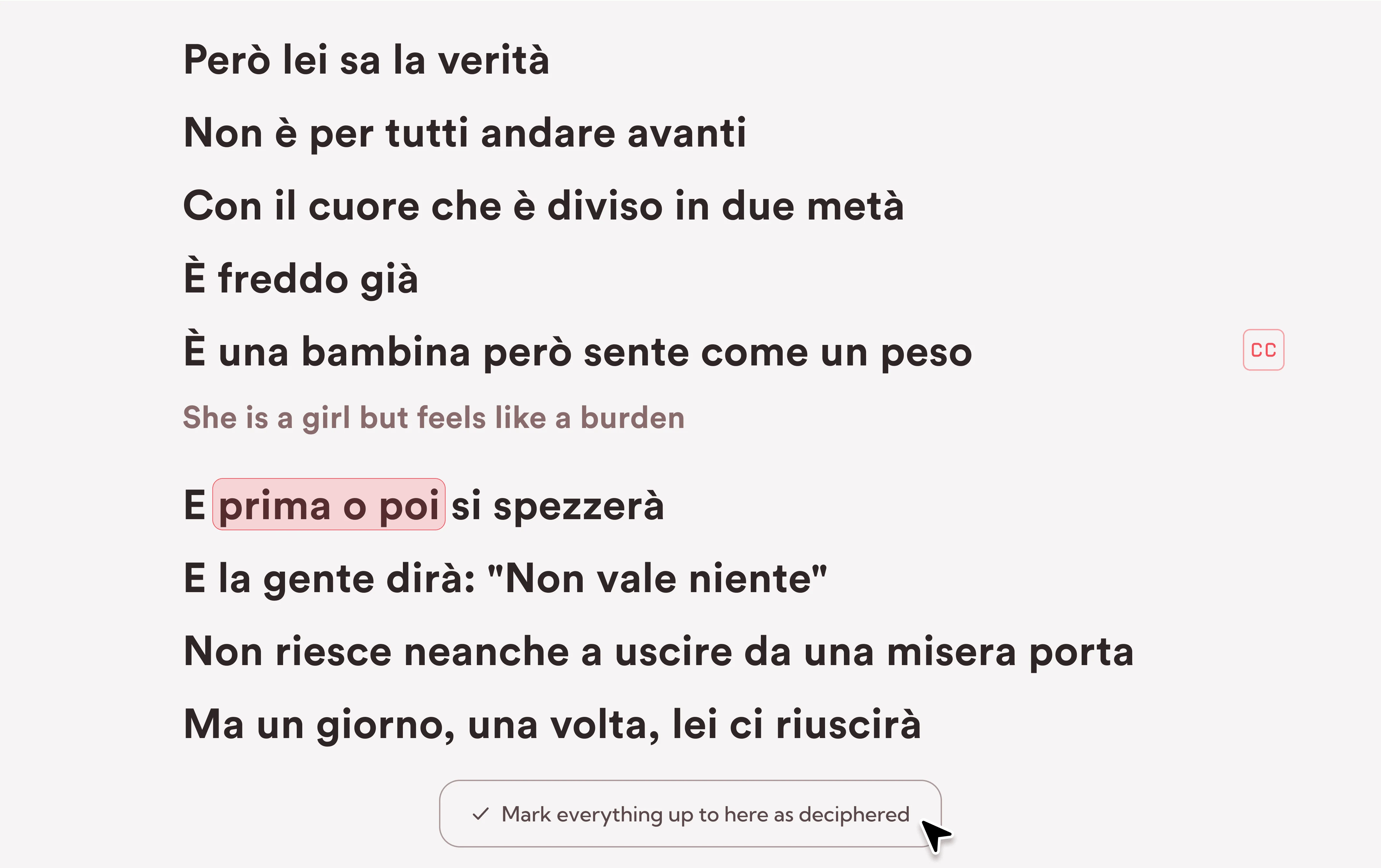
To keep users focused on the current step and reduce both distractions as well as cognitive load, Verse automatically deemphasizes deciphered and upcoming stanzas.
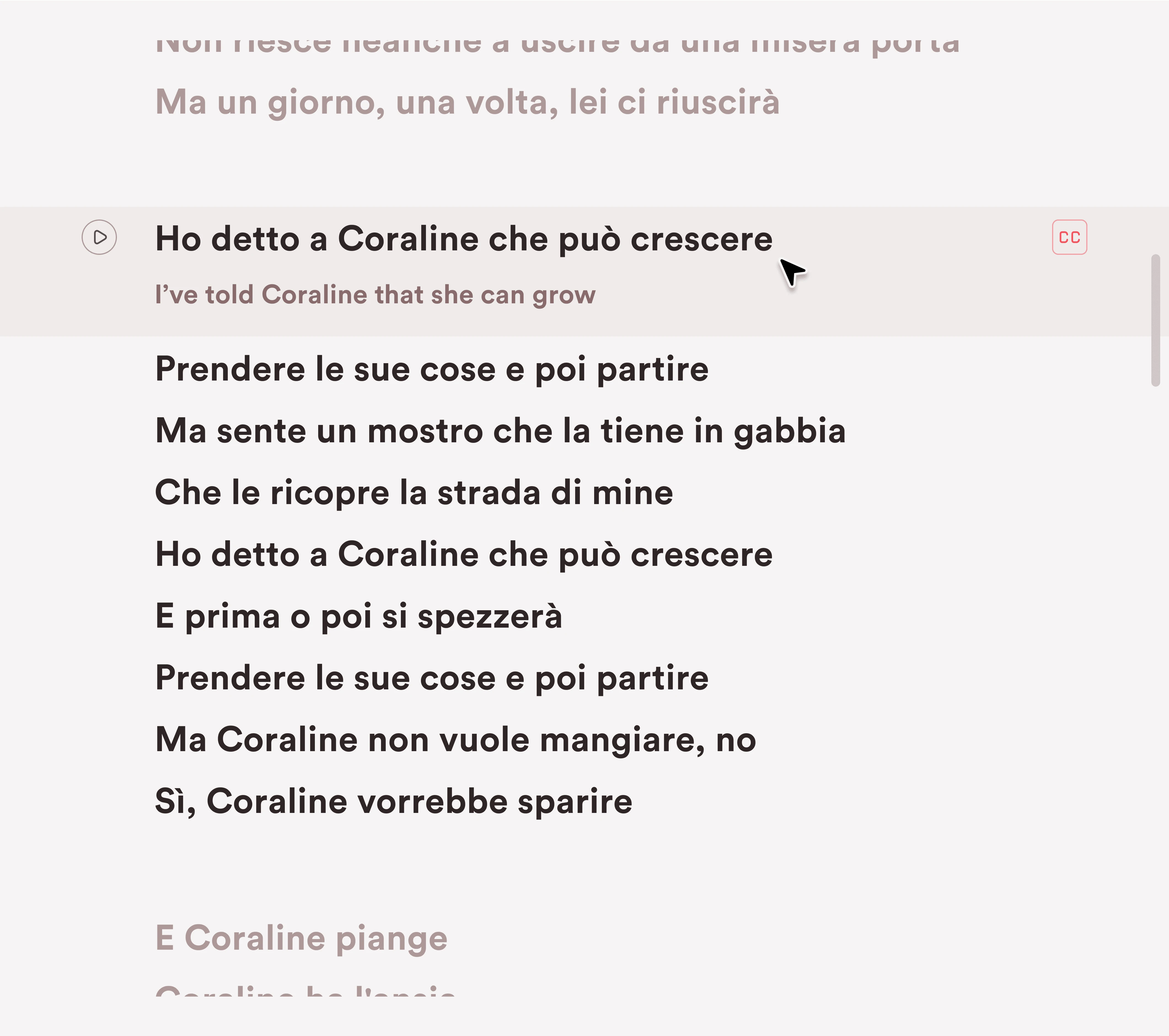
(though this can be adjusted in the Preferences module if a user wants to)
Finally, Verse uses 3 main indicators to give users the clear and frequent feedback they need to keep track of how they're doing, and how far they've come.
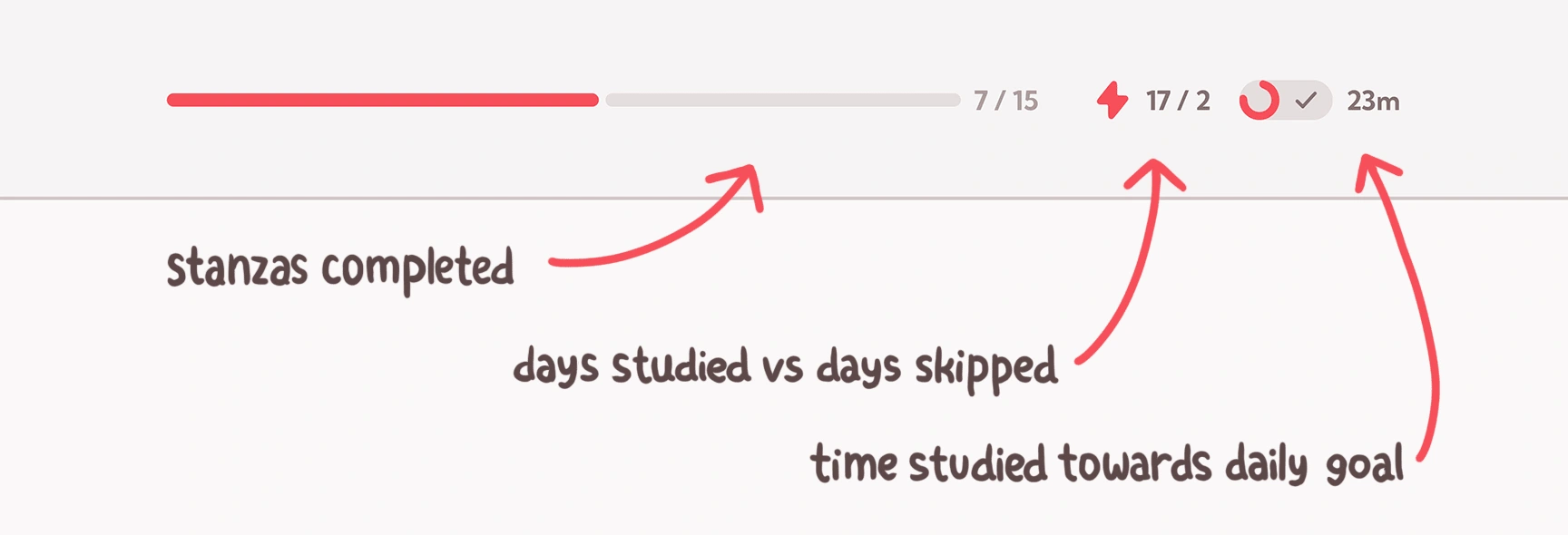
Let's take a closer look at why I decided to use these metrics.
First, "stanzas completed".
A stanza is what I call a "unit of progress". Units of progress can vary across different types of juice, or based on a student's level.
Stanzas make sense for songs. But if a student were trying to decipher a book, for example, we could measure their progress in paragraphs, pages, or even chapters.
The key is that making one or a few units of progress every day is a very achievable goal.
An advanced student could, for example, finish several pages of a book in the language they're learning in a single study session. On the other hand, a beginner might need a long time to decipher just a couple of paragraphs.
That's why this "unit of progress" is customizable.
The goal of small, achievable units of progress is that every student can see and feel they've made tangible progress whenever they complete a study session.
By keeping track of student progress in a unit they have more immediate influence over at their current level, Verse can help keep them motivated.
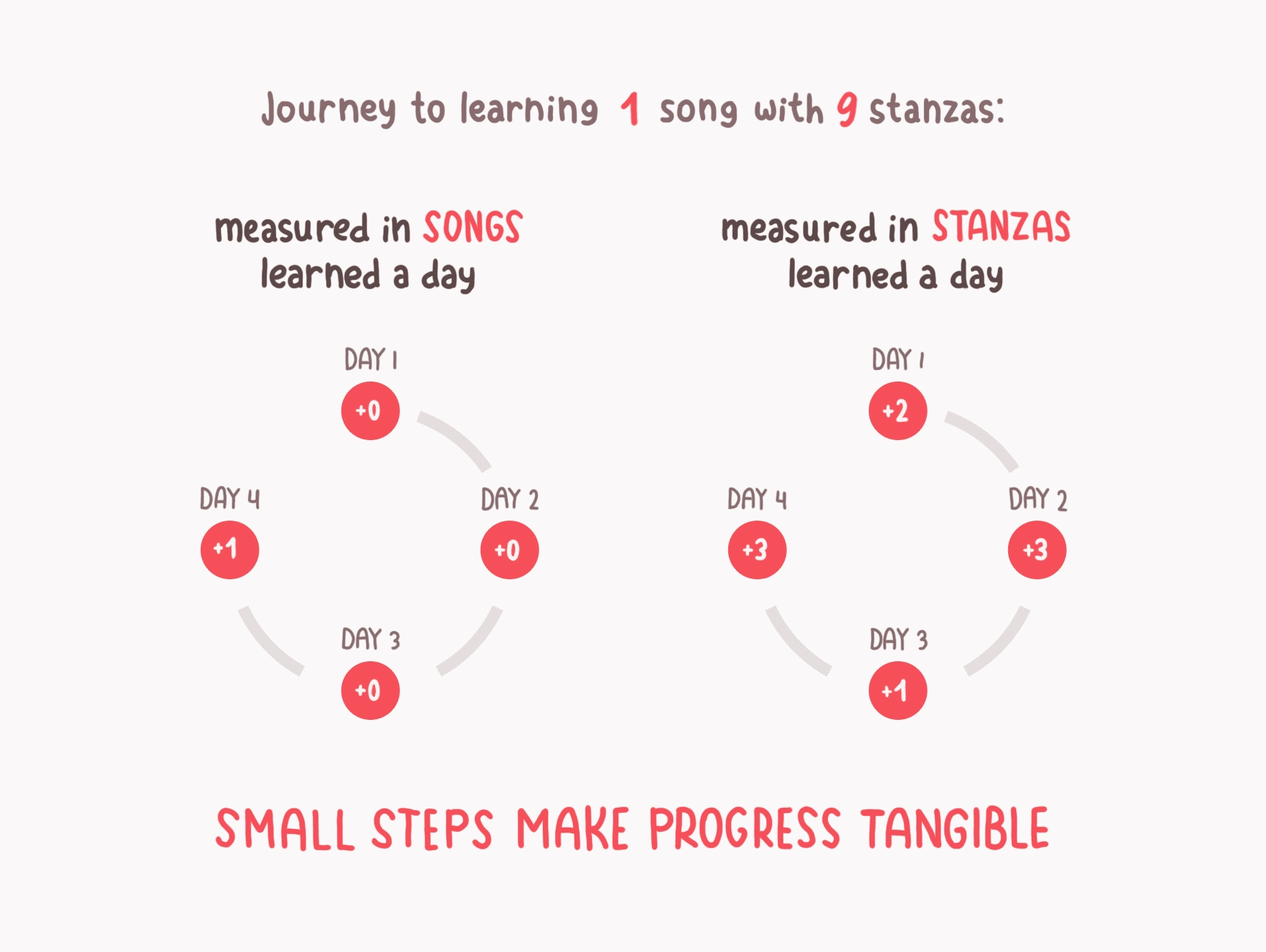
Second, we have "days studied vs days skipped".
I chose that as the main metric of long-term consistency instead of the typical "streak" for two reasons:
Streaks are powerful motivators until they aren't. Miss a day and, if you had a long streak that is now gone, you're likely to never come back.
The density of consistency matters much more than any single record.
Here's what I mean by point number two:
Let's say you study on weekdays and rest on weekends for 1 year. Your longest streak will be 5 days, but you will have studied 260 days in total.
Now, compare that to someone who studies 130 days in a row, misses one, loses motivation, and never comes back.
Their streak was 26 times larger than yours, but they studied half the days in total.
A metric like "days studied vs days skipped" shows students a more realistic picture of consistency, and motivates them to keep on piling up "studied days" while trying to keep "days skipped" in check.
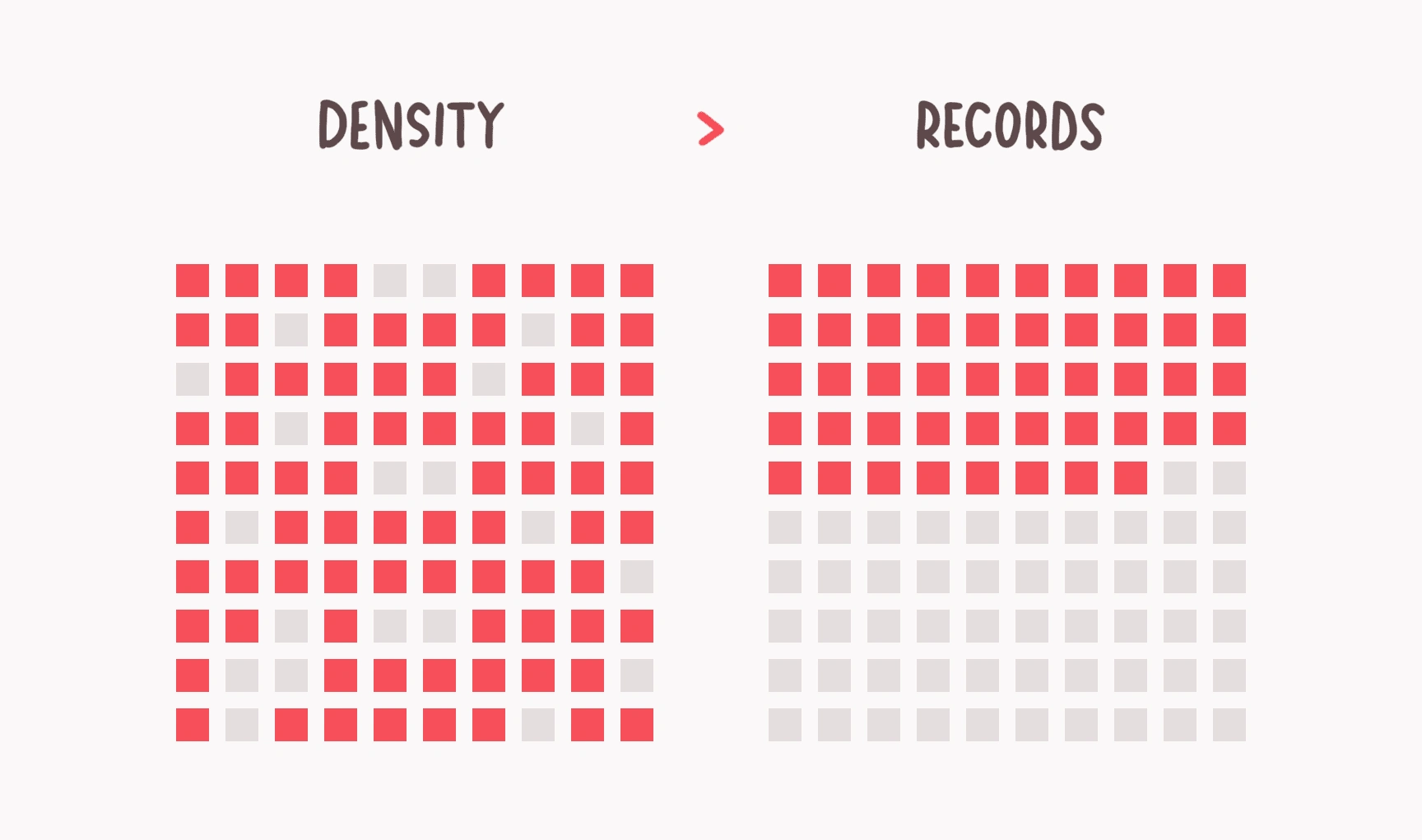
Third, "time studied today" is the final key progress metric.
It's there for two reasons:
There are good and bad days in life.
I want users to walk away with a sense of completion after they have done their part for the day.
To explain point 1, sometimes, it may take you one hour to decipher 3 stanzas. On a better day or with an easier song, that same hour could be enough to decipher 6.
We can't always control the results of our work. That's why what matters most is that we put in the time to achieve something, and do our best with it.
To explain point 2, I don't want students to burn out by going overboard with their studies on a day. They're free to do so if they want, but I wanted my solution to help them keep a healthy balance.
So, in Verse, students set a daily study-time goal. Verse then includes a timer indicator that shows how much of that time they've been studying. When their goal is reached, it plays a sound.
Students can then sign off with a toggle to see a summary of what they achieved that day and leave the app in peace of mind.

(wrapping up every visit on a serene, positive note is central to Verse)
Putting it all together, this is what everything we've seen so far looks like!

And here are the Preferences module options related to this new Session area we've just explored.
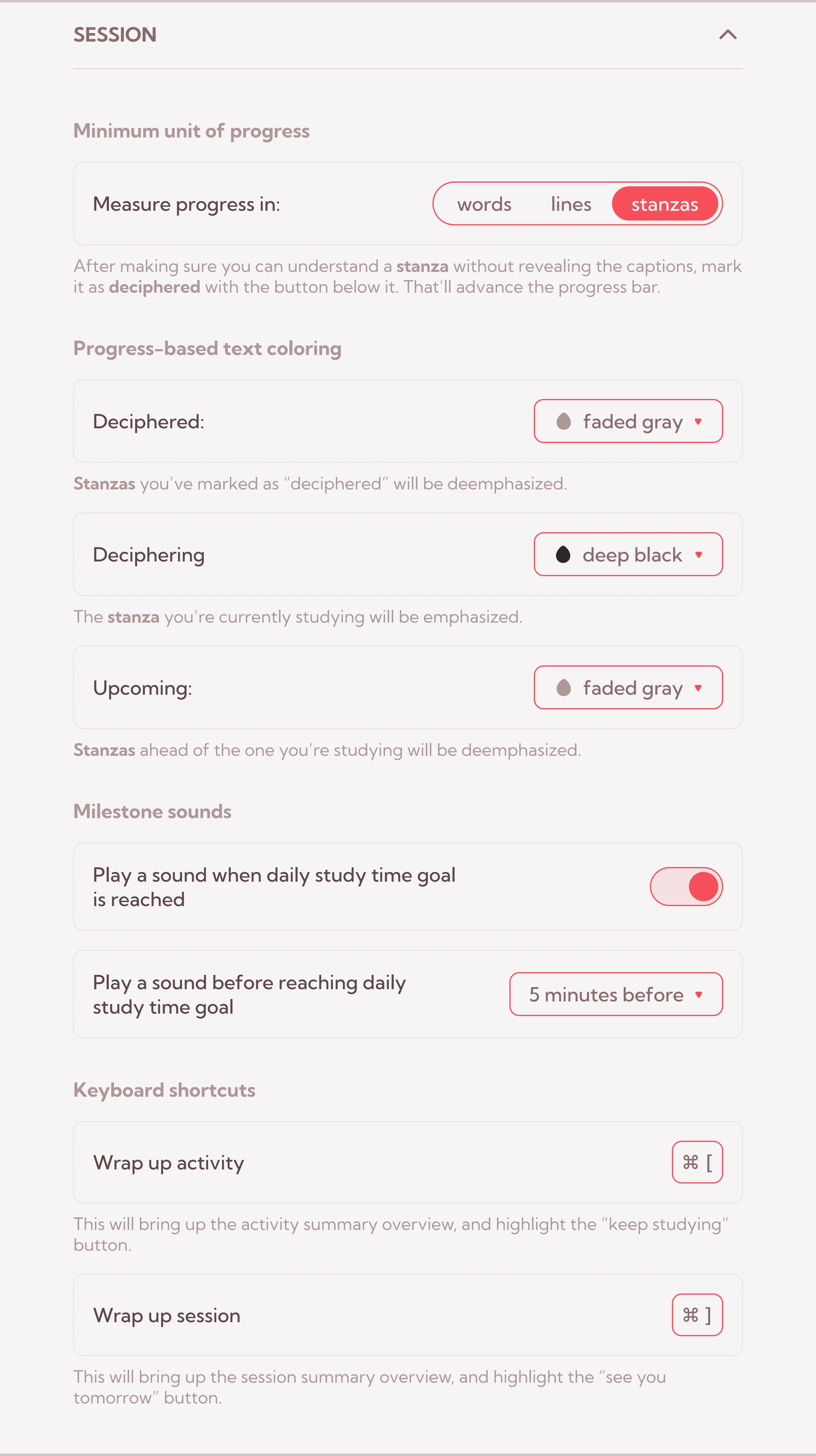
To keep things as tidy and minimal as when we first started to explore the UI, many areas of Verse's layout can be automatically hidden and only revealed when the mouse is brought near their respective edges.

Phew, that was a long ride!
What we've seen so far is how Verse helps students with phase 1 in the learning cycle: Understanding.
As you may recall, my goal was to design a complete solution that covered all 3 phases.
What I've shown you so far covers most of Verse's core structure. So, it'll be much quicker to show you the rest.
On to the next two!
7. Repeat not to forget; apply not to repeat
With time, we forget everything we don't use.
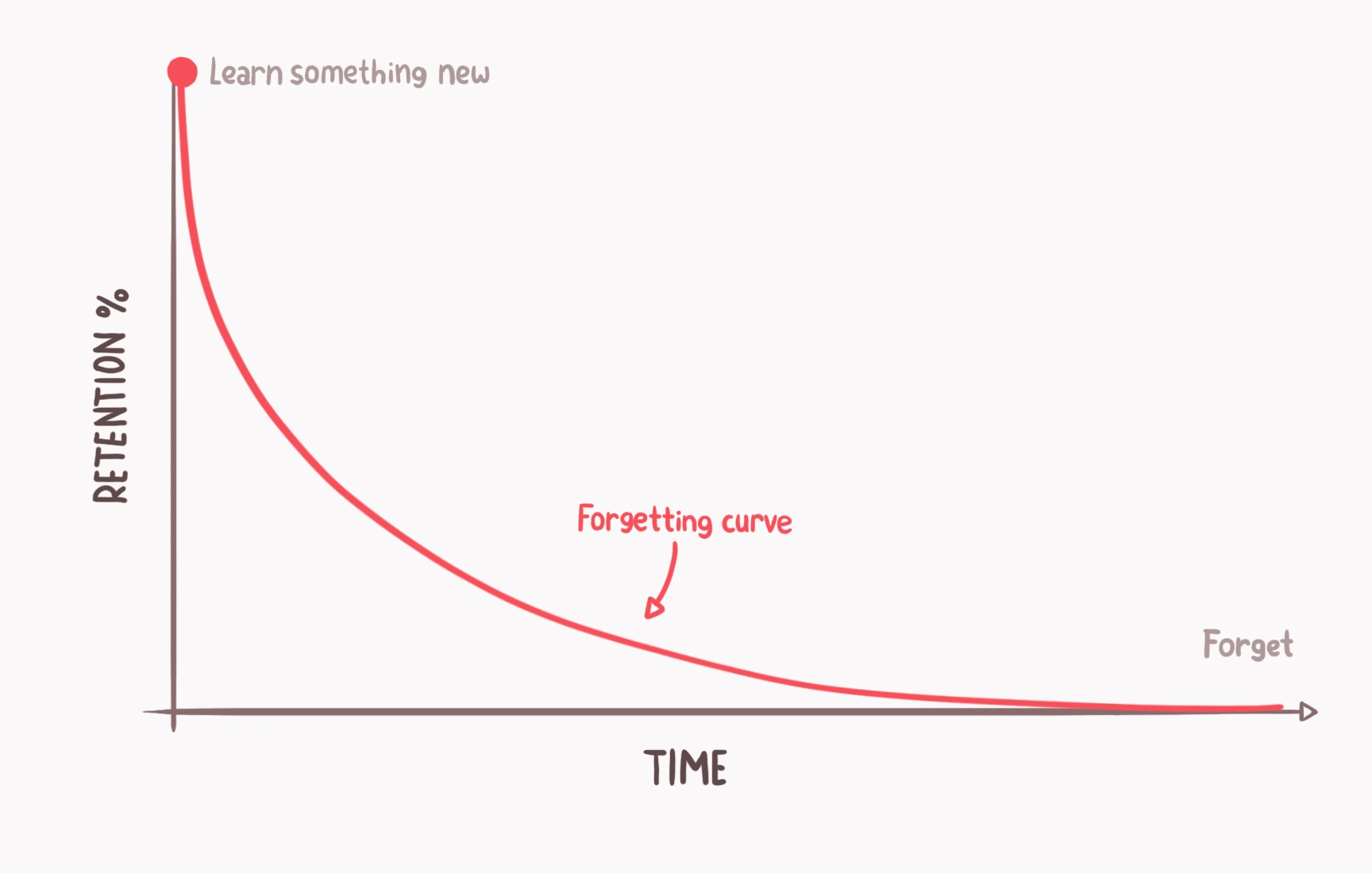
To strengthen retention, we can deliberately review what we learn.
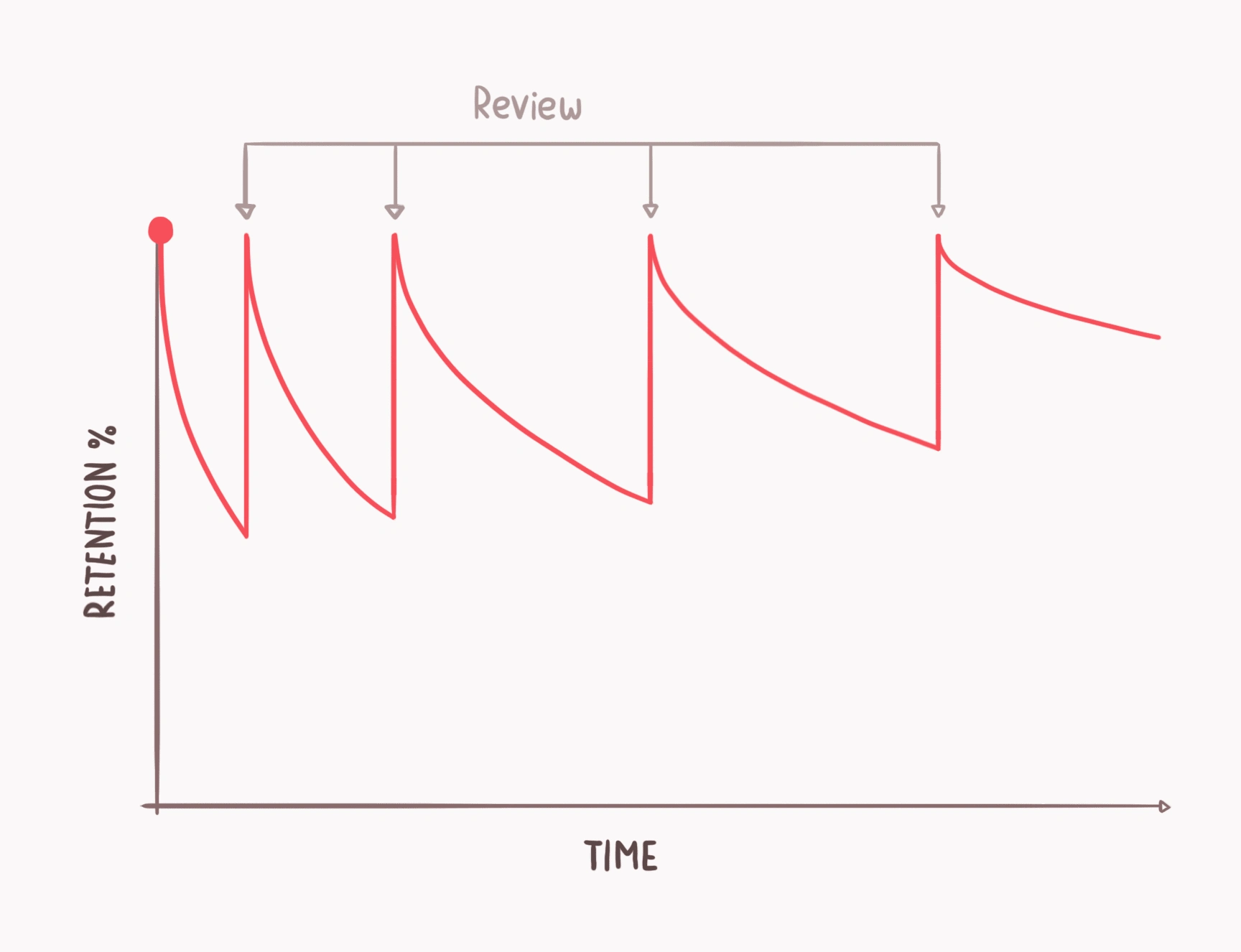
If done systematically, the forgetting curve eventually flattens out, and we forget more slowly. In other words, we retain what we learn for longer.
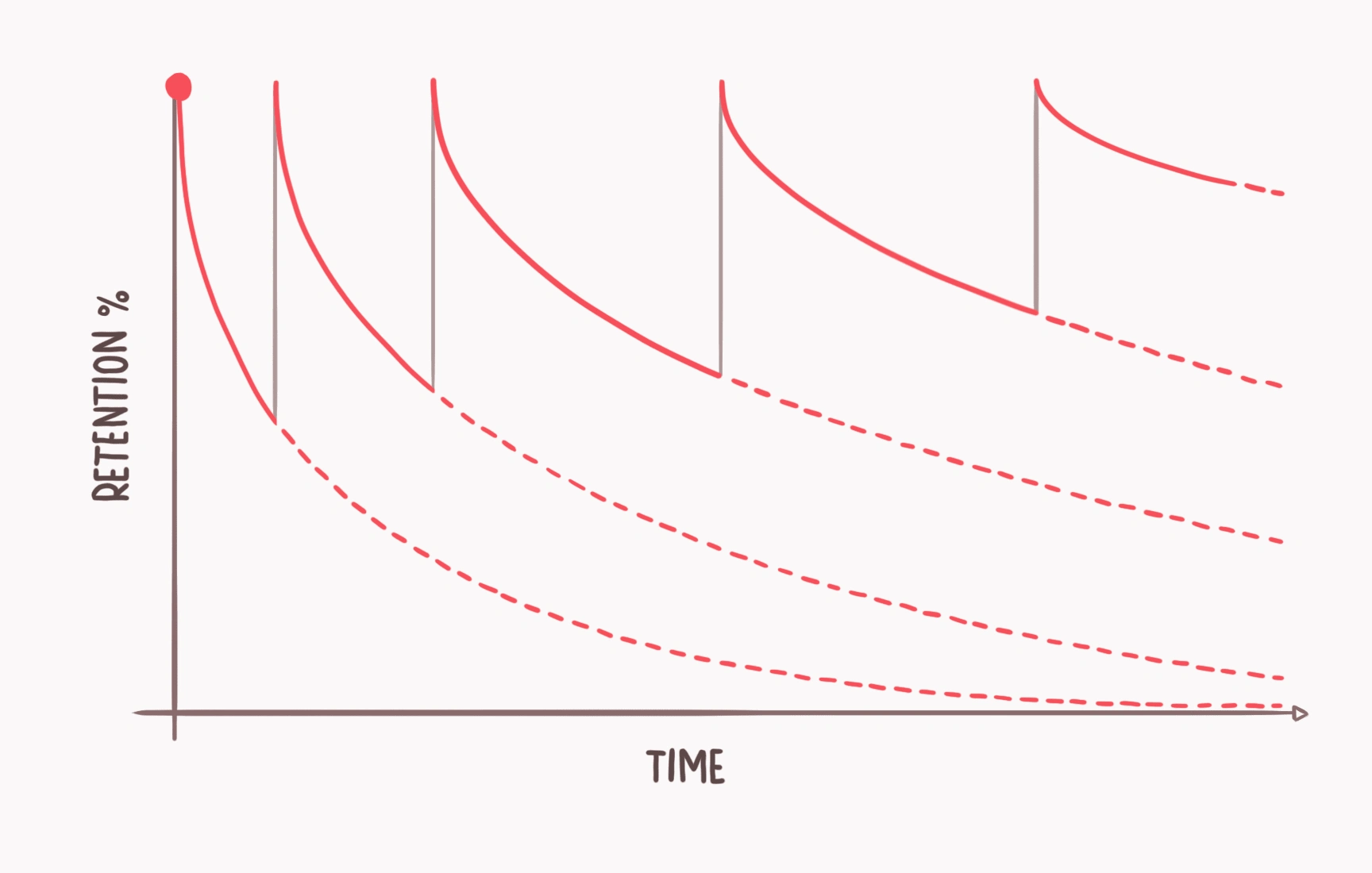
That's the idea behind spaced repetition systems (SRS).
You put new knowledge in a box, and then the system challenges you to recall pieces of that knowledge at the most optimal times to strengthen your memory.
If you succeed at the challenge, the SRS will move that knowledge into another box, which you will have to review after a longer while than last time. And, if you miss, it will reset it to an easier box.
After several level-ups, a piece of knowledge eventually "graduates", and you don't have to review it again: You've acquired it for the long run.

(the review interval above is just an example. SRS algorithms can vary, but the general concept stays the same)
This system works, and it's often integrated into many language-learning solutions.
However, spaced repetition has a huge flaw: The more you use it, the worse it becomes.
The thing is, the rate at which you put new knowledge into the starter box is typically much faster than the rate at which you graduate old knowledge.
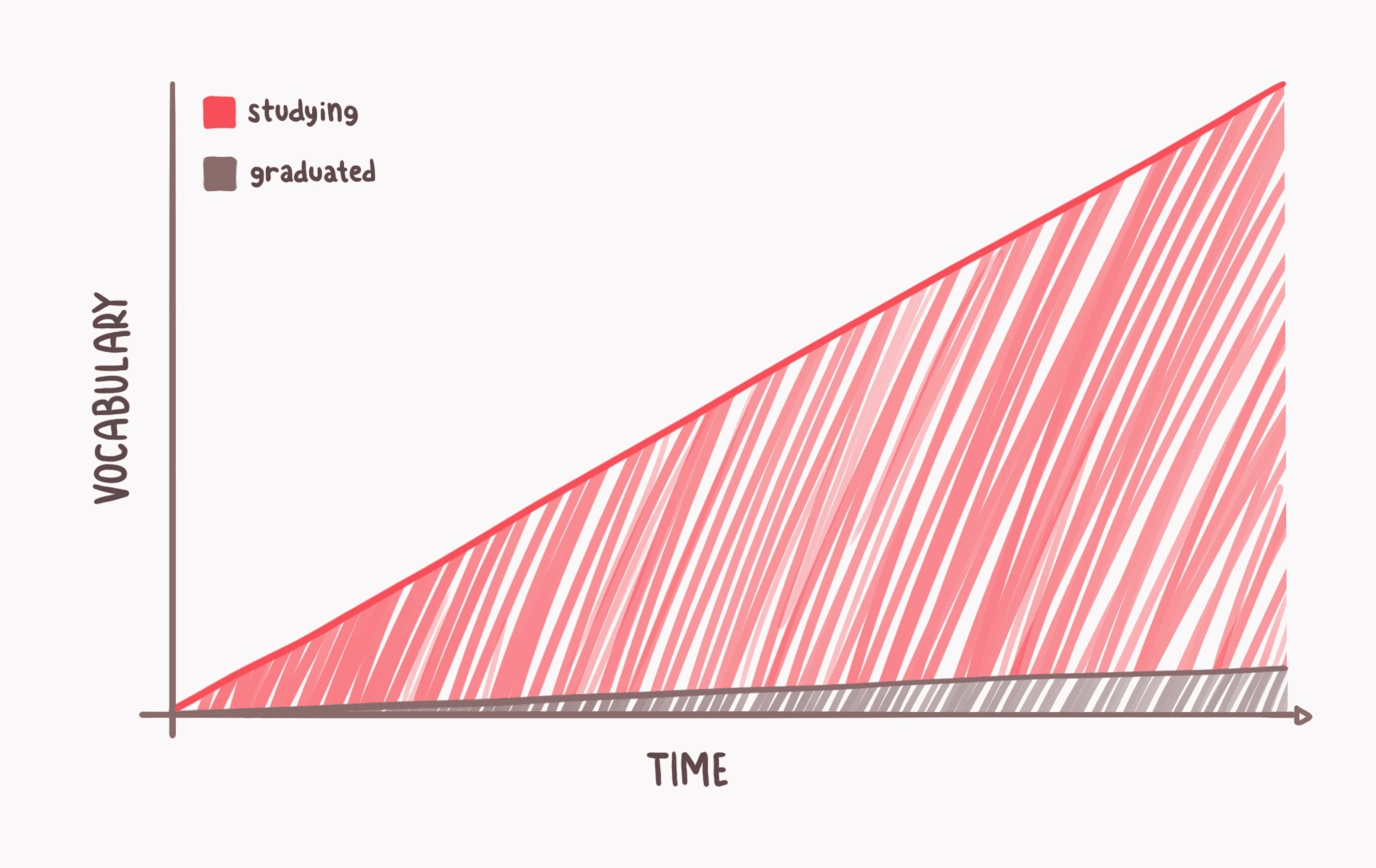
As a result, reviews quickly pile up. Not before long, you have to sit through longer and longer review sessions just to keep up.
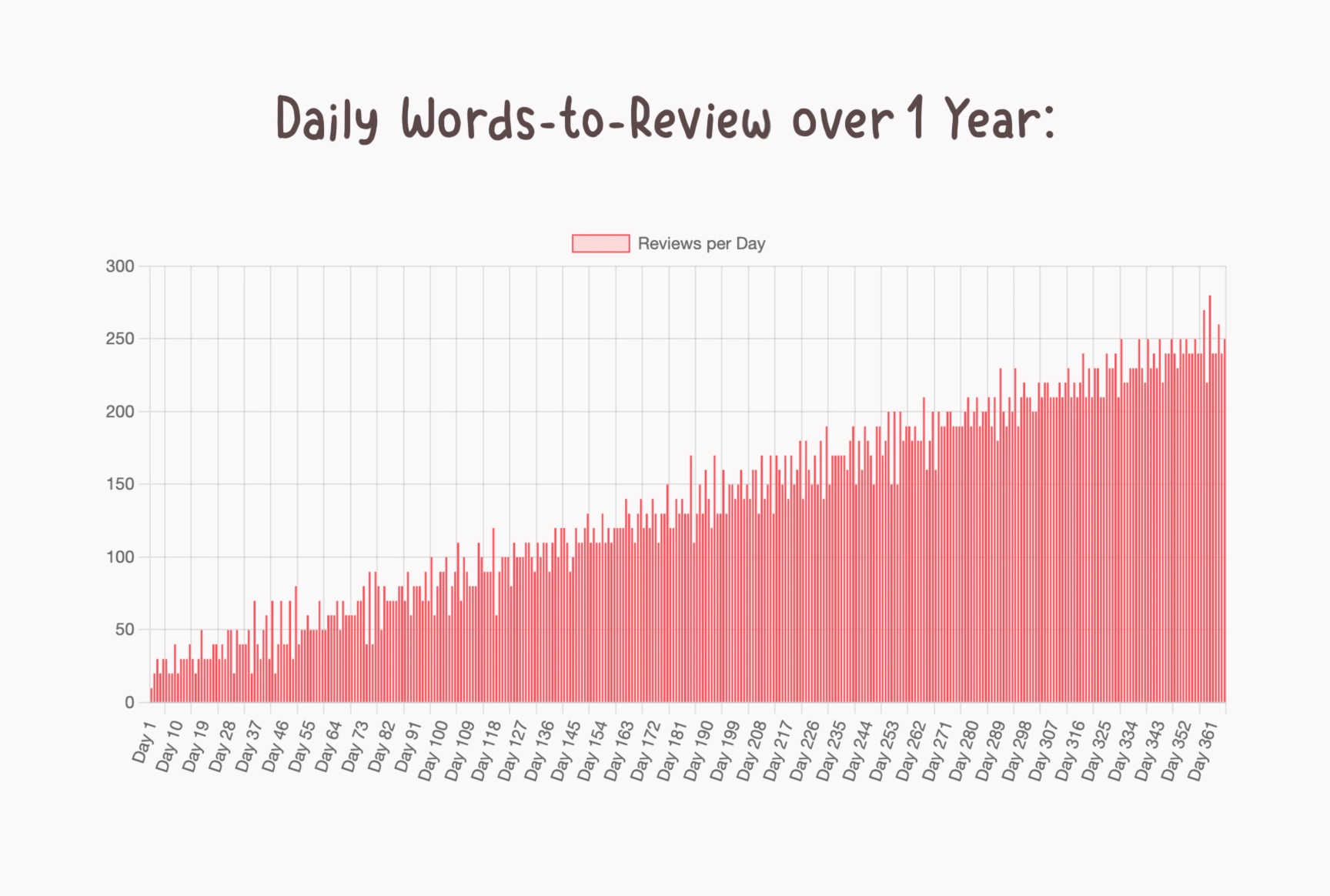
(if you learn 10 words a day, in just a few months you'll have to review more than 200 words a day)
To solve that problem, we need something that flattens the forgetting curve faster. Something that reduces the number of reviews we need to graduate old knowledge.
That's where applying comes in!
Applying what we learn as soon as possible significantly improves both understanding and recall.
Why?
Because you can't apply what you don't understand, and you can't understand what you don't remember.
In other words, applying forces us to fill in the gaps in our understanding and memory before we can produce something of our own.
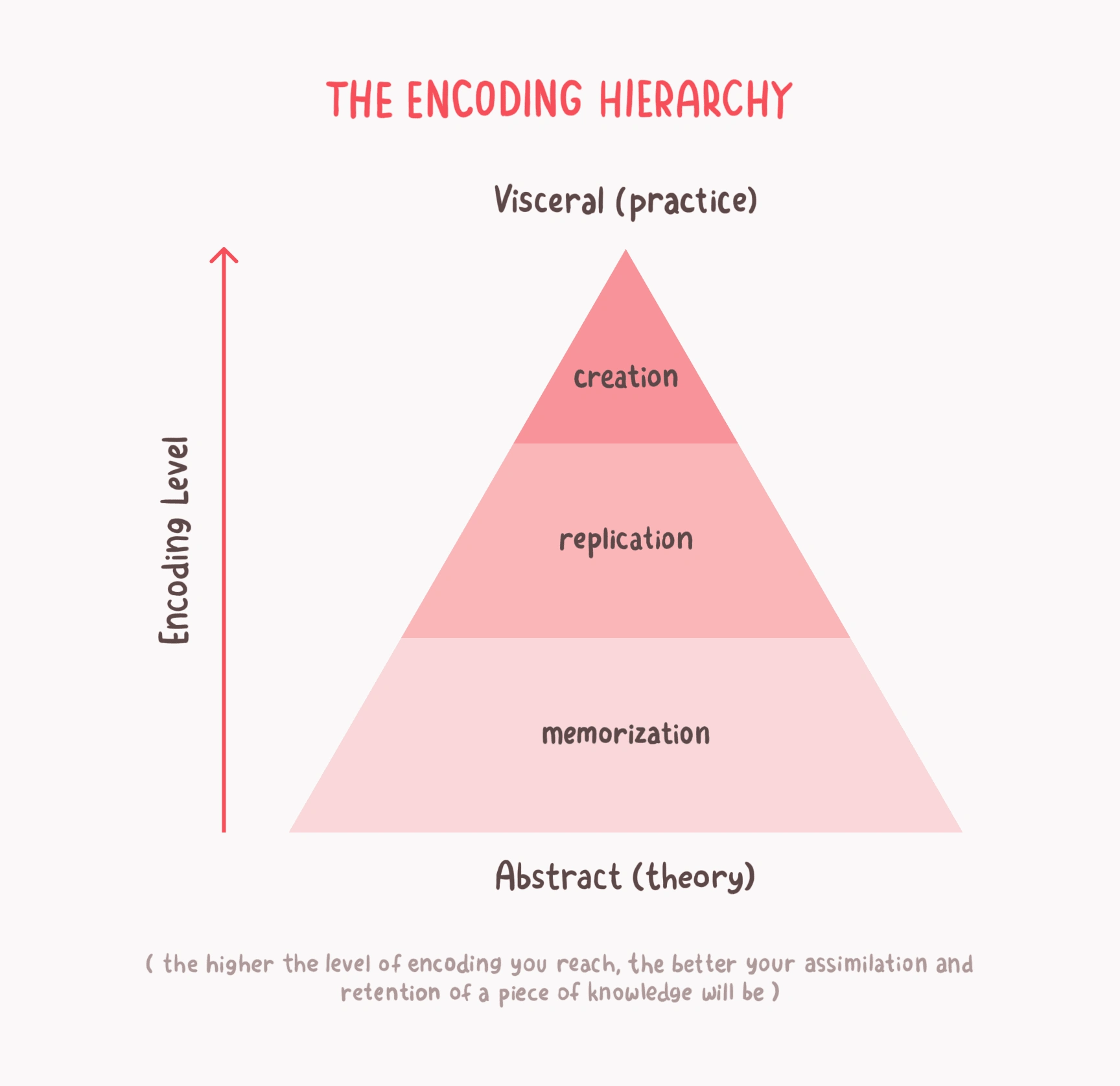
Now, the fact that applying what we learn in a new language is hard remains, especially when we are beginners.
The average native speaker has an active vocabulary of about 20,000 words. If you have a vocabulary of 400 words in the language you're learning, speaking or writing may feel like trying to score a basketball through a hoop that's 50x smaller than the ball.
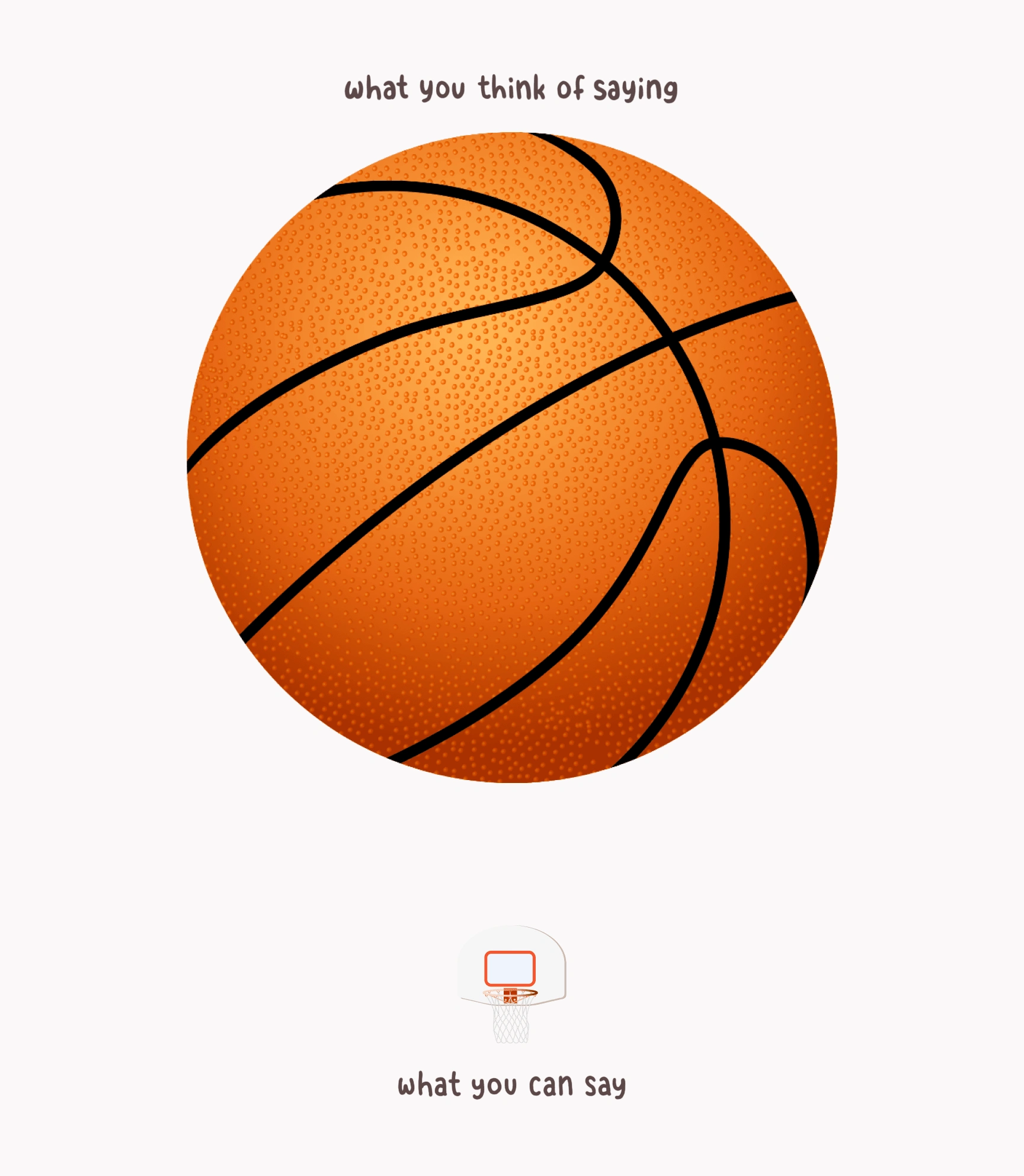
That's why Verse combines 3 approaches to help you build up your skill and confidence:
Context, lots of it. In Verse, you're always learning words in real-life contexts. And, the more juicy stuff you consume, the more you familiarize yourself with their use.
Limited, challenging reviews. Verse caps reviews at 50/day max to not overwhelm you. But, it keeps them as a regular aide to gradually boost up your recall. Also, reviews in Verse are more challenging than typical reviews, once again pushing your recall abilities higher faster.
Personalized output practice. Verse shows you how to make the most out of the vocabulary you learn and guides you through output challenges tailored to your level, so you're always using what you learn in ways you are ready to work with.
Let's see it in action!
Imagine a student added this sentence to their study list:

To test their understanding, we could cover 1 word in the sentence,

give them the sentence's meaning,

and then ask them to fill out the blank with the help of the captions and surrounding context.

This is a good start. Notice the following advantages over popular translation exercises in other apps:
There is no multiple-choice. Students must be able to recall the correct word on their own.
No word ever appears alone. Even if students only have to translate a single word, they still see the context where the word appeared. Over time, this familiarizes them with concrete usage examples.
Students must type out their answers. This forces them to practice the correct spelling and gets them used to writing with the keyboard of the language they're learning. There are no word or character pools here.
Now, in the current design, the width of the blank matches the width of the word it covers. That can give students a clue about the correct response, strengthening their recognition instead of their recall skills, which is not what we want. But, we can easily fix that:

In Verse, blanks have a fixed width, and automatically expand to wrap the text students type.
Not only that, but blanks in review exercises don't necessarily cover just one word. They could conceal more than one, and it's on students to realize that.
Exercises start easy, though, and only gradually become harder as students get more and more correct answers.
To graduate difficulty, Verse adjusts the number of blanks and the number of words they conceal.
Like that, students gradually answer more complex challenges,

until they can translate the full sentence on their own.

This exercise type is beautiful because it's easy to graduate the difficulty of every challenge until it's exactly right for every student.
But, much of its merit lies also in that it can offer a wholistic approach to reviewing seen structures:
From challenging students to write in the language they're learning,

to translating something back into a language they know.

This format can also be used to help them practice their ability to catch words in audio,

(the audio is in the language they're learning. in this example, Italian)
as well as whether they can translate what they hear.

(the audio is in the language they're learning. in this example, Italian)
All in all, this exercise type, which comes as a game in Verse, offers up to 4 challenge variants, each highly adjustable to the proficiency of each student.
And it all fits in nicely within the same layout architecture we've been working with.

(this is what an ongoing reviewing activity may look like)
While students are writing their answers to a challenge, the modules pane is disabled.
But once they submit their answer, modules come alive again, bringing back any notes a student may have saved, and all the rich info from sections in case students want to revisit them.
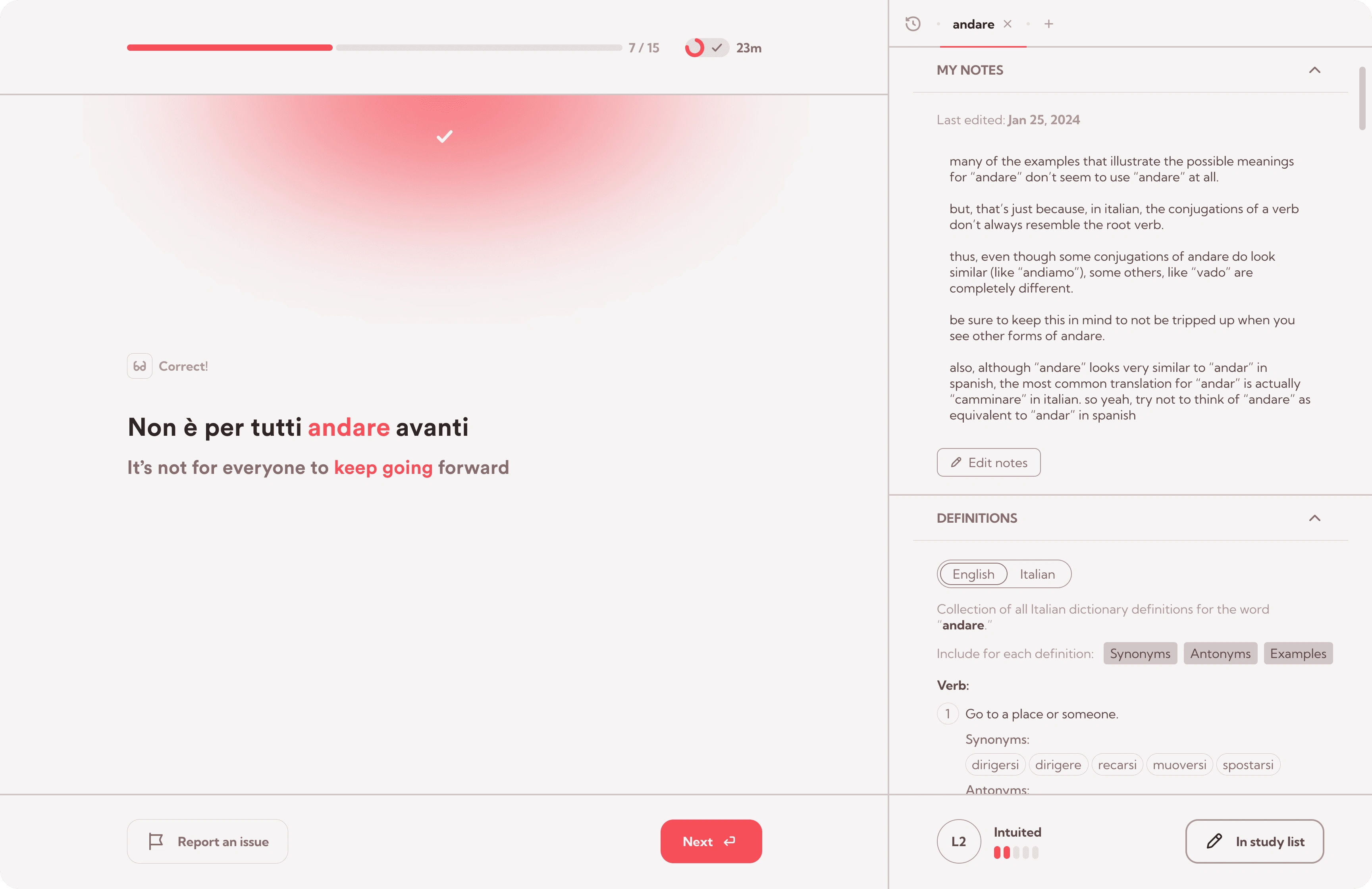
(in this capture, the modules navigation is set to hide automatically, but all modules, like 'Ask AI', remain available)
And, of course, if there's any mistake, students get immediate feedback as well.
Whenever students get a challenge wrong, it's just added to the review queue again. So, by the time students finish a review session, they will have gotten all the challenges correct.
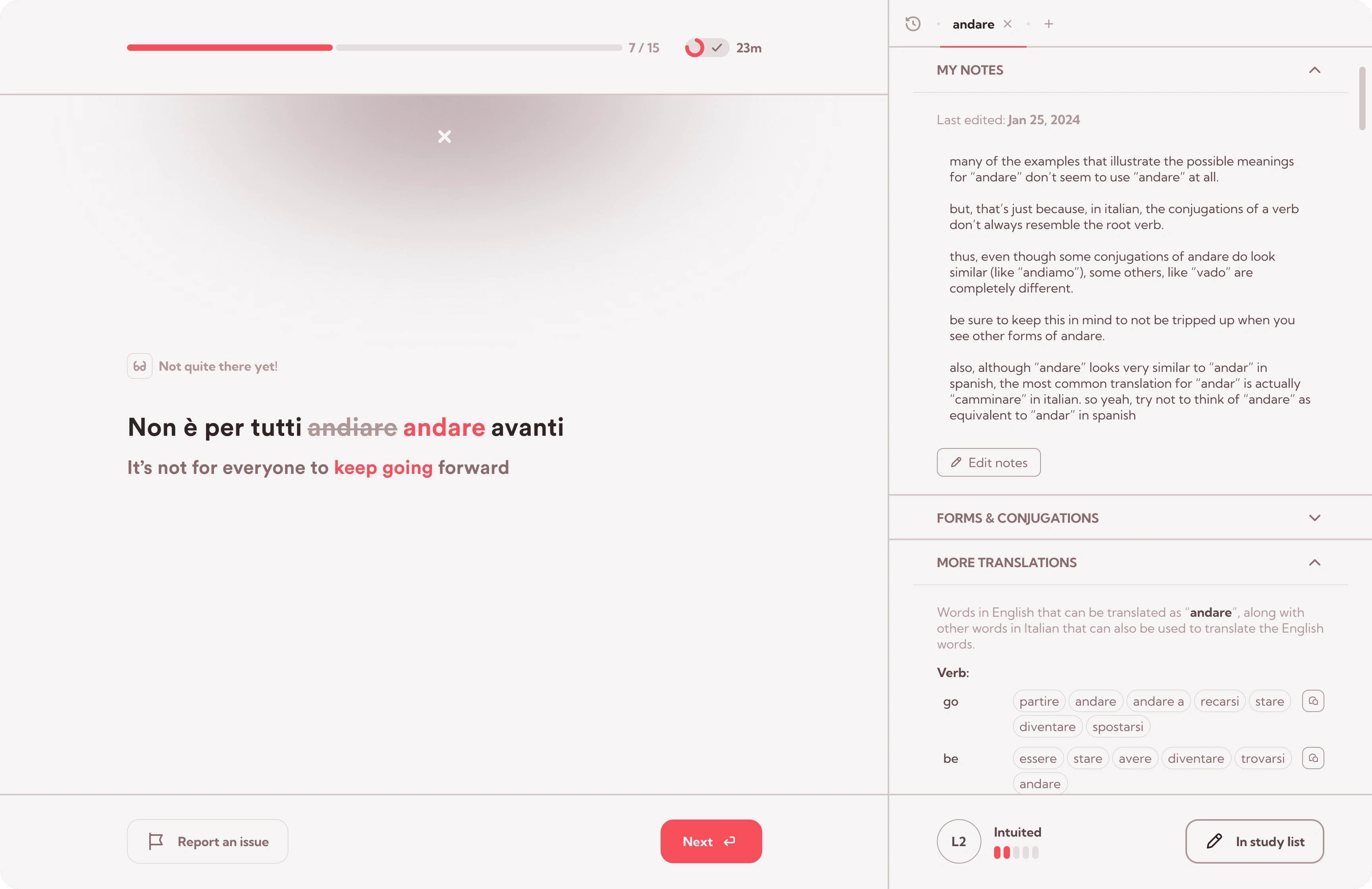
(by default, Verse is very strict about spelling, though this sensitivity can be adjusted in Preferences)
The game we've just explored, which I've temporarily named 'Blanks Restorer', is the first of 3 'reviewing' games in Verse.
The next reviewing game is one I call 'Word Bricks', and the idea behind it is very simple: Challenge students to recall as many words as they can without any clues to help!
Take a look:
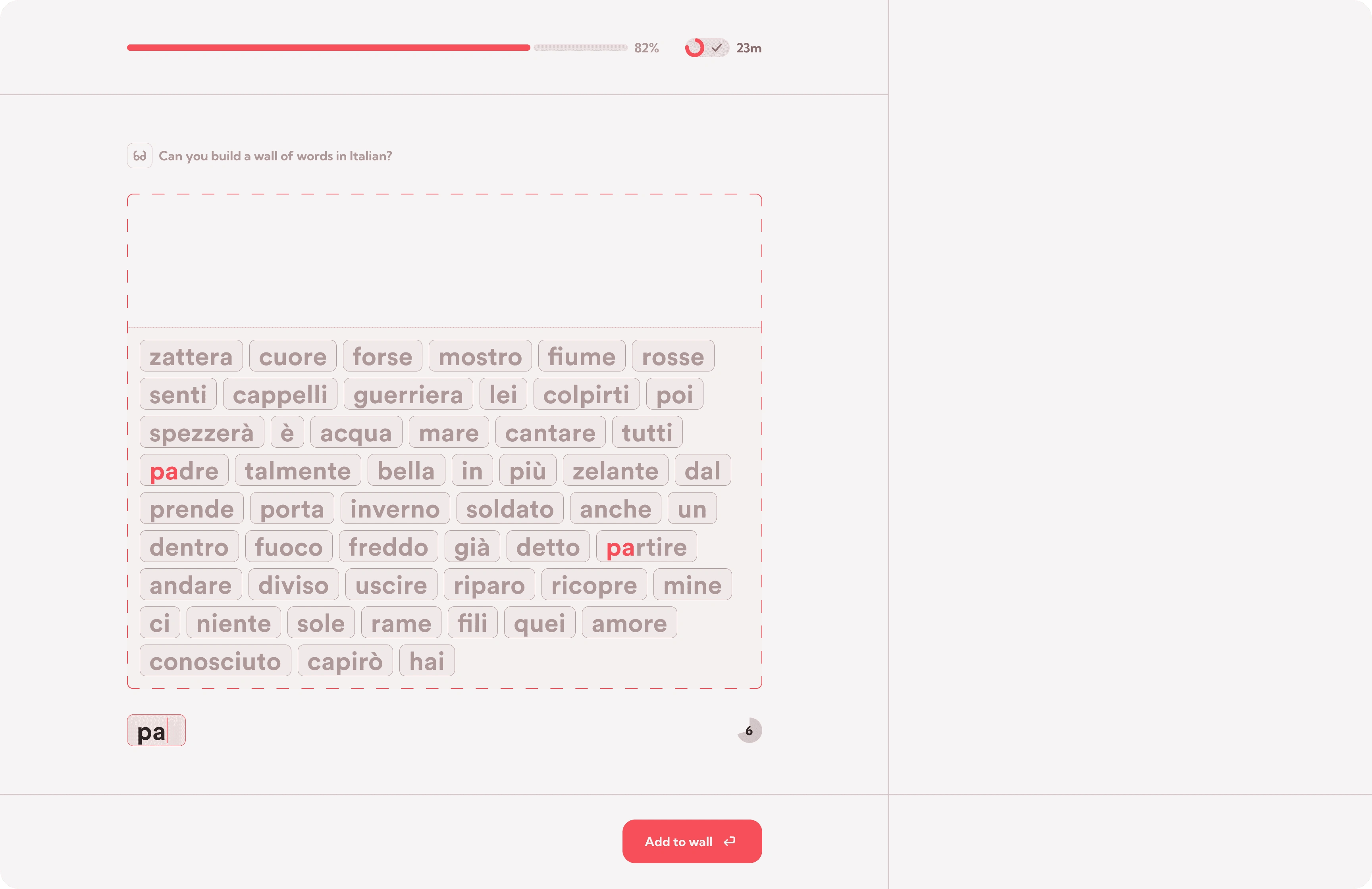
Here's how it works:
The instructions set a theme that constrains which words are valid. In the example above, there is no restriction, so students can list any words in Italian that they can remember.
Whenever students enter a valid word, it is stacked along with all the other words they listed. The goal is to build a wall of words that fills the entire dotted area.
As students type a word, the matching characters in already added words are highlighted. This reduces the chances of accidentally entering a duplicate word. In any case, this is just to save students time; every word is always validated before being added anyway.
There's a countdown timer across the word students are typing. The initial time allowance is smartly determined based on the student's level and the difficulty of the challenge. The countdown is reset every time a valid word is added.
When students complete the wall of word bricks, or if their time runs out, the game ends!
For this exercise type, it's also easy to graduate the difficulty for each learner.
More specifically, narrower themes and taller wall areas make things harder while more general themes and shorter wall areas make the challenge easier!
Adjusting those two variables, it's possible to make all sorts of challenges.
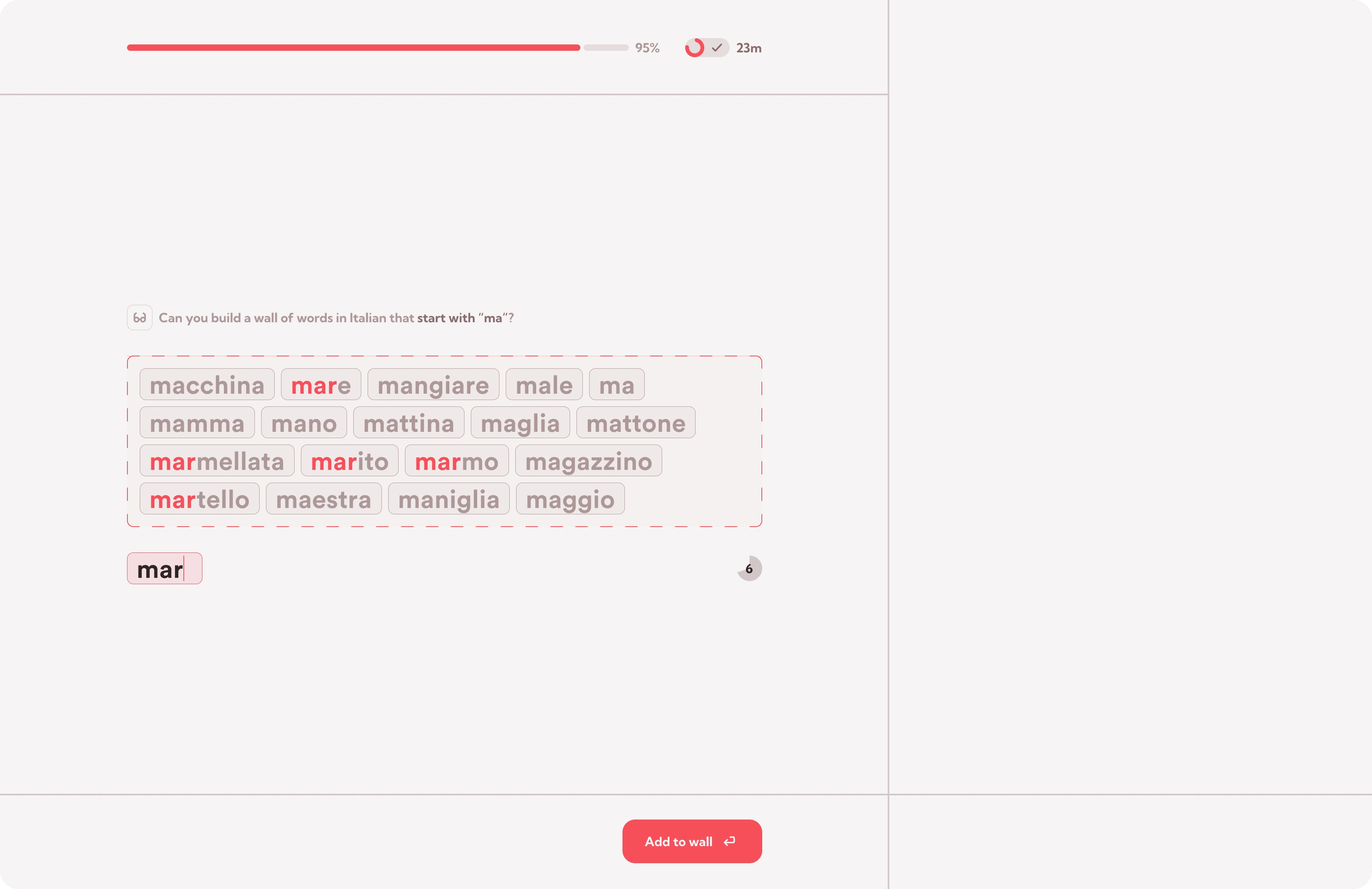
(for example, students could be challenged to list as many words that start with "ma" as they can)
This game is perfect for helping students practice their recall of topic-specific vocabulary, like words that are animals, verbs, or even those often used to order coffee.
Since Verse leverages powerful Large Language Models behind the scenes, it's also possible for students to set custom themes for this game, or to challenge them to build walls not just of words, but also of phrases, like idioms and other expressions. Everything works!
And, of course, when the game ends, students get rich module-powered feedback too.
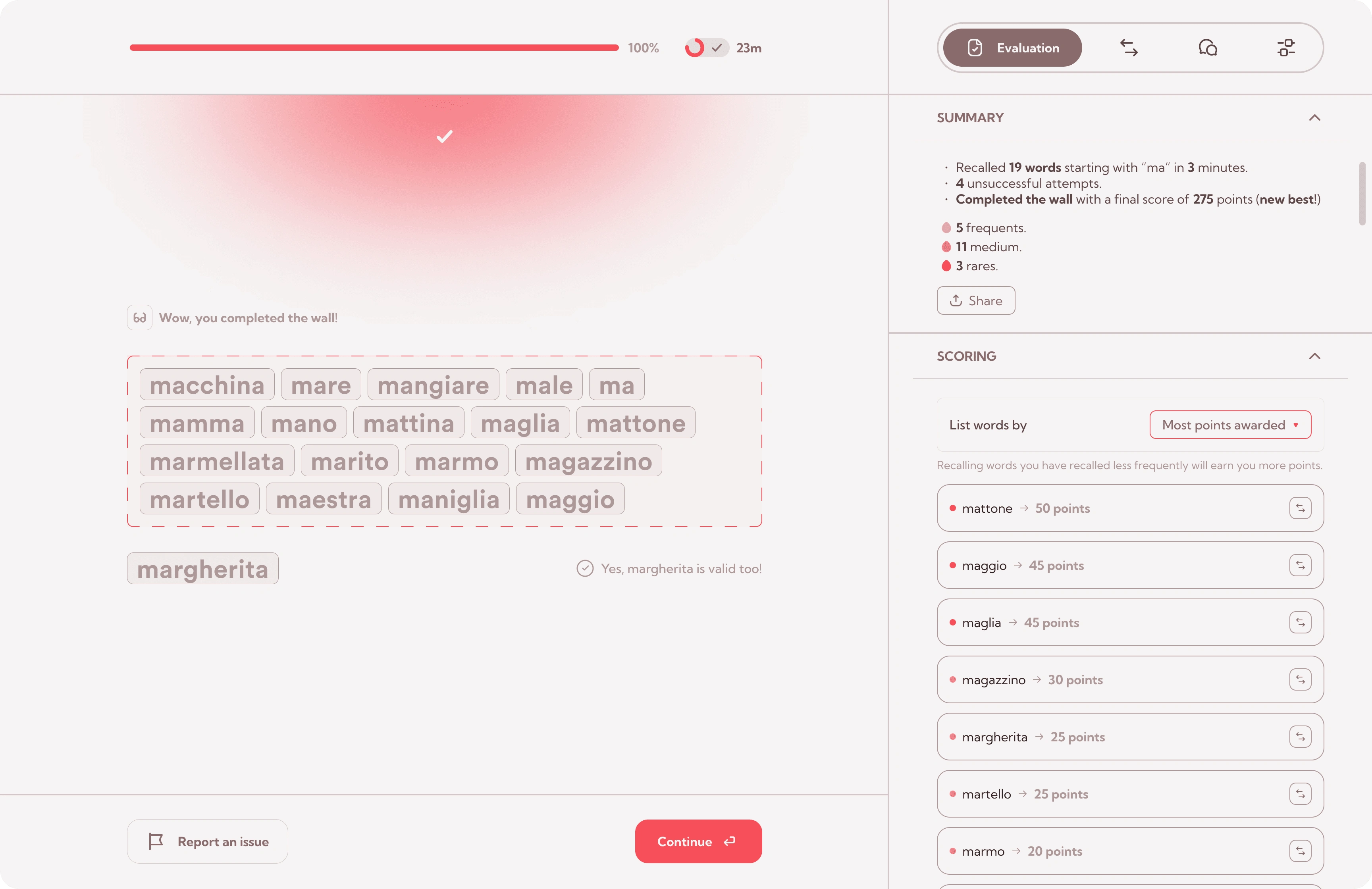
To help students reinforce their recall of not just some of the words they've seen, but of as many of them as possible, Verse awards points for every word listed. And, recalling words they recall less frequently gives them more points!
If students are happy with a particular result, they can also share it with their friends.
On the other hand, if a student runs out of time before completing the wall, not to worry! Verse will help them do better next time by surfacing words they have already seen and which they could've listed to complete the challenge.
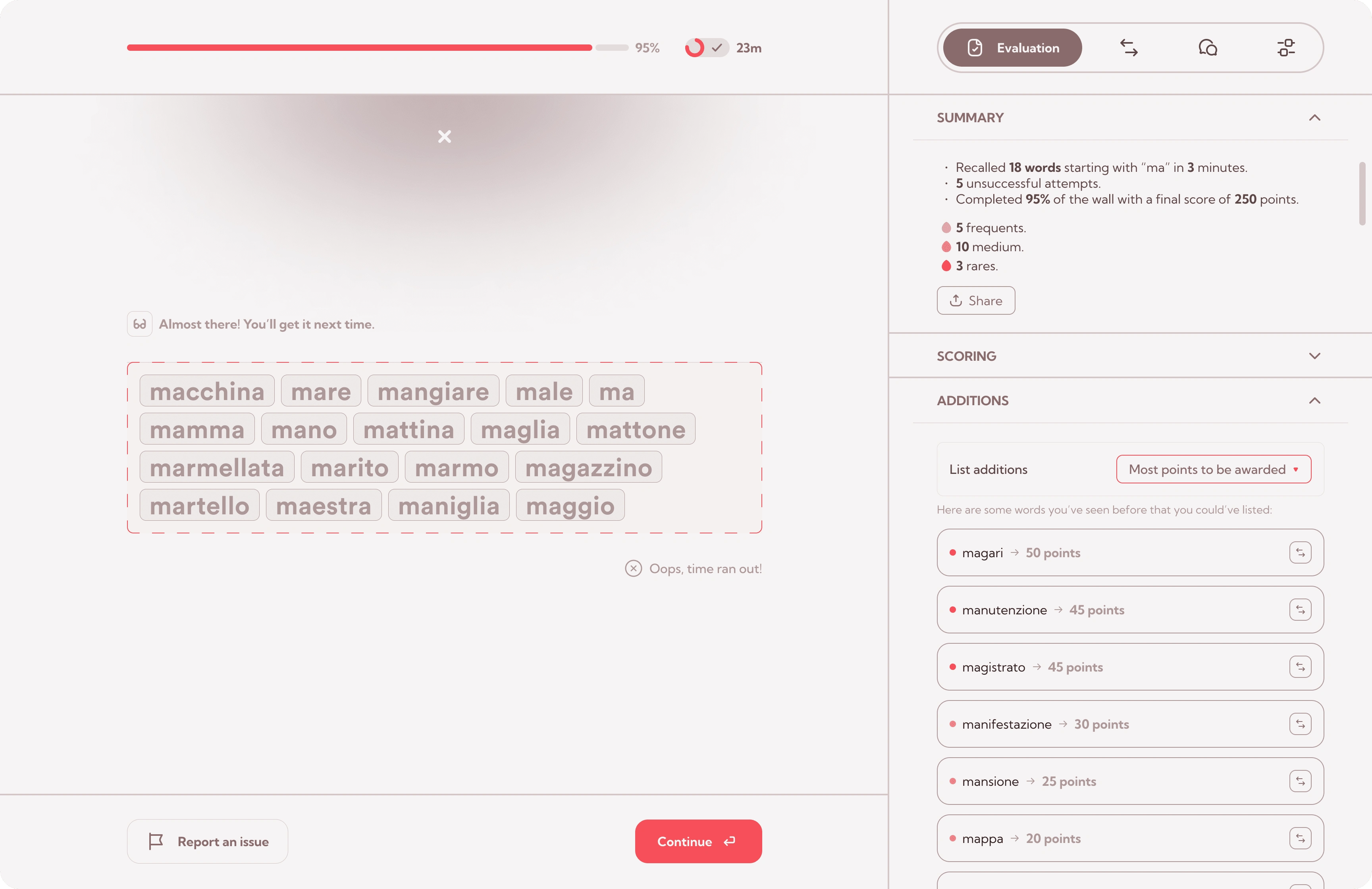
(the additions section is automatically expanded when time runs out, but it's also available for students who succeeded)
Finally, there's 'Language Shuttle', the last game students can play to review the juicy stuff they consumed.
The idea is simple: Students are challenged to translate, in their own words, a longer piece of text.
In the current version of Verse, that'd be the lyrics of a song, but as Verse supports more juice types, it could be a clip from a movie or some paragraphs from a book.
Here's how it works:
At the center of the screen, students see two lines. In the first, they type their translation of the captions in the second.
Whenever students are done translating a line, they press enter to move on to the next.
Translated lines pile up above the center, and lines to be translated are queued below. Both are deemphasized in the UI to help students focus on the translation at hand.
In this game, students can translate from the language they're learning to a language they know,
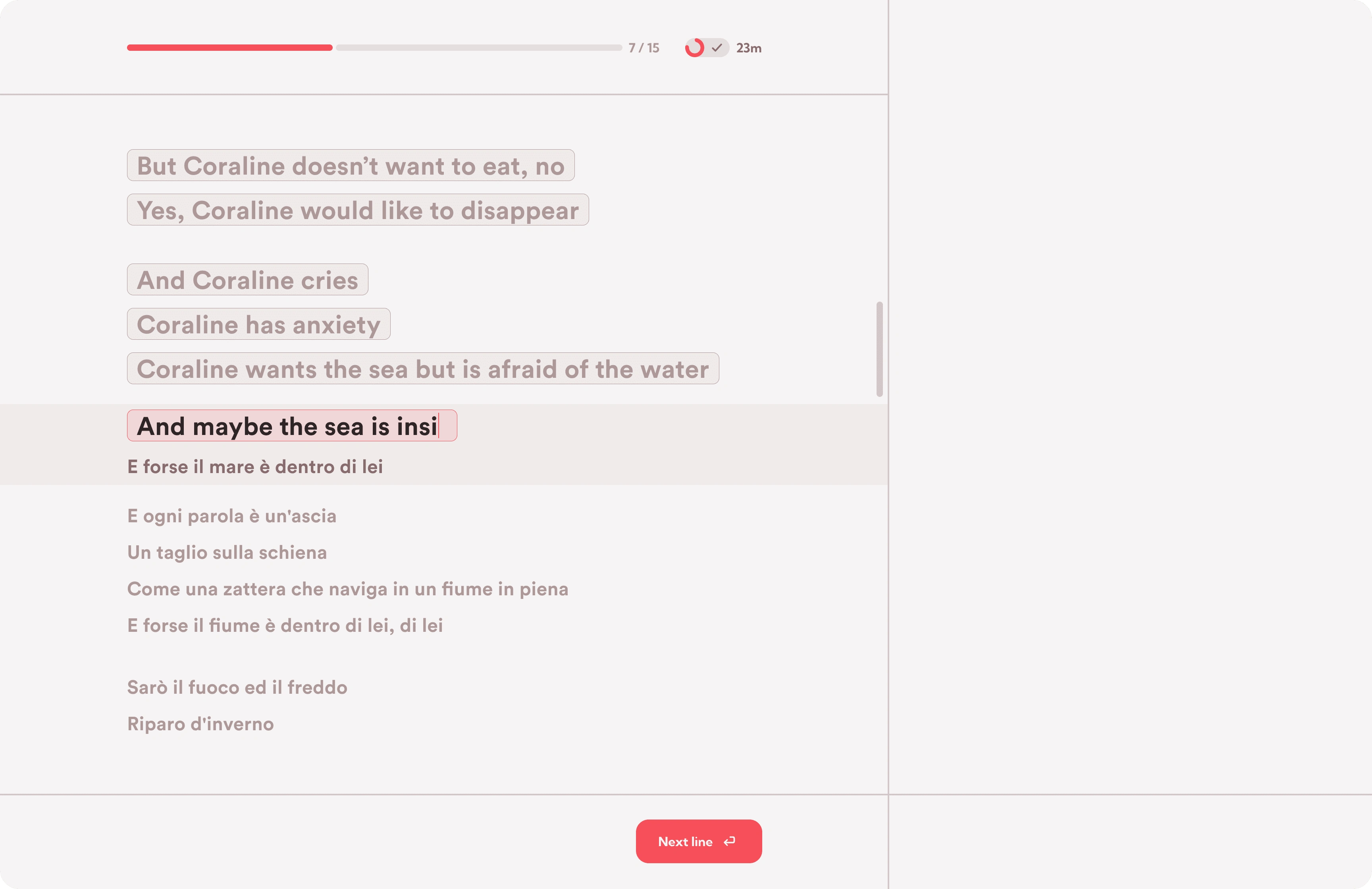
or from a language they know to the language they're learning.
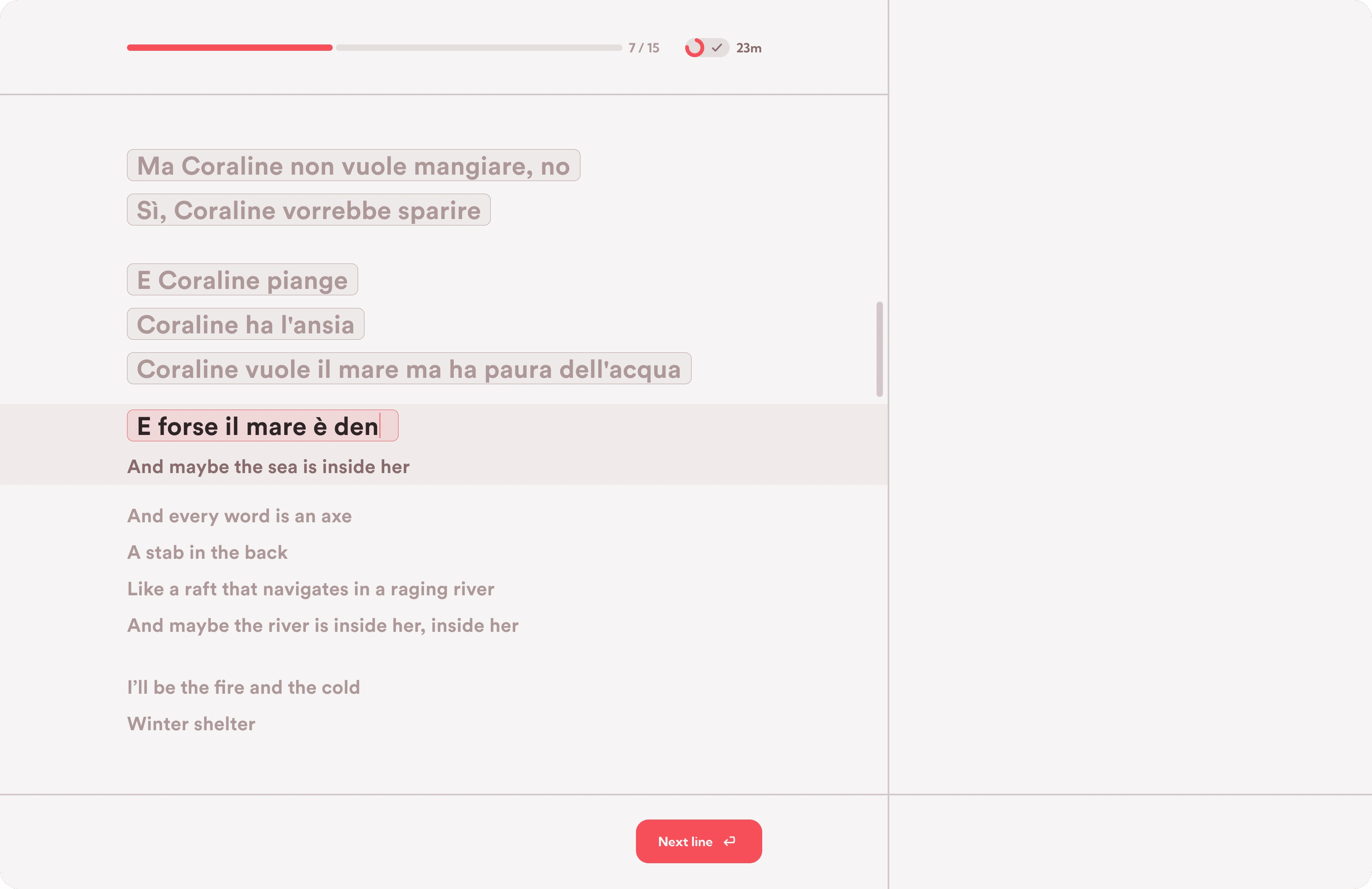
It's important to note that this is not a memorization exercise.
While remembering the lyrics can help, the translations students write for each line don't have to match the original line in the lyrics.
The AI evaluating the translations cares only that each answer is a valid translation of the corresponding captions.
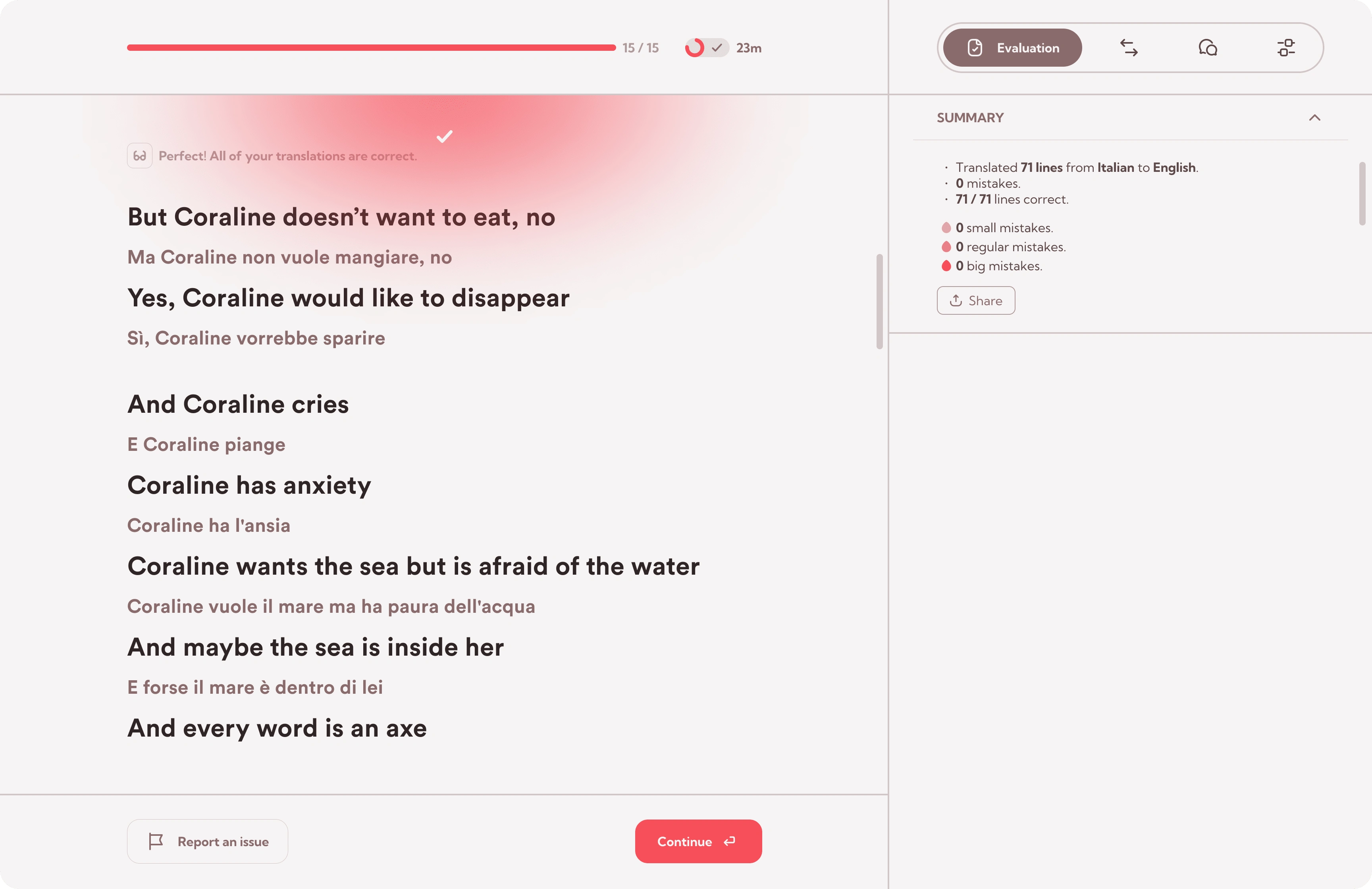
And, as always, offers a detailed breakdown of corrections, if there were any mistakes.
If students wanted, they could also tap on the handy buttons next to every correction to jump straight into an explanation of the correction inside the Ask AI module, where they can also ask any questions they may have.
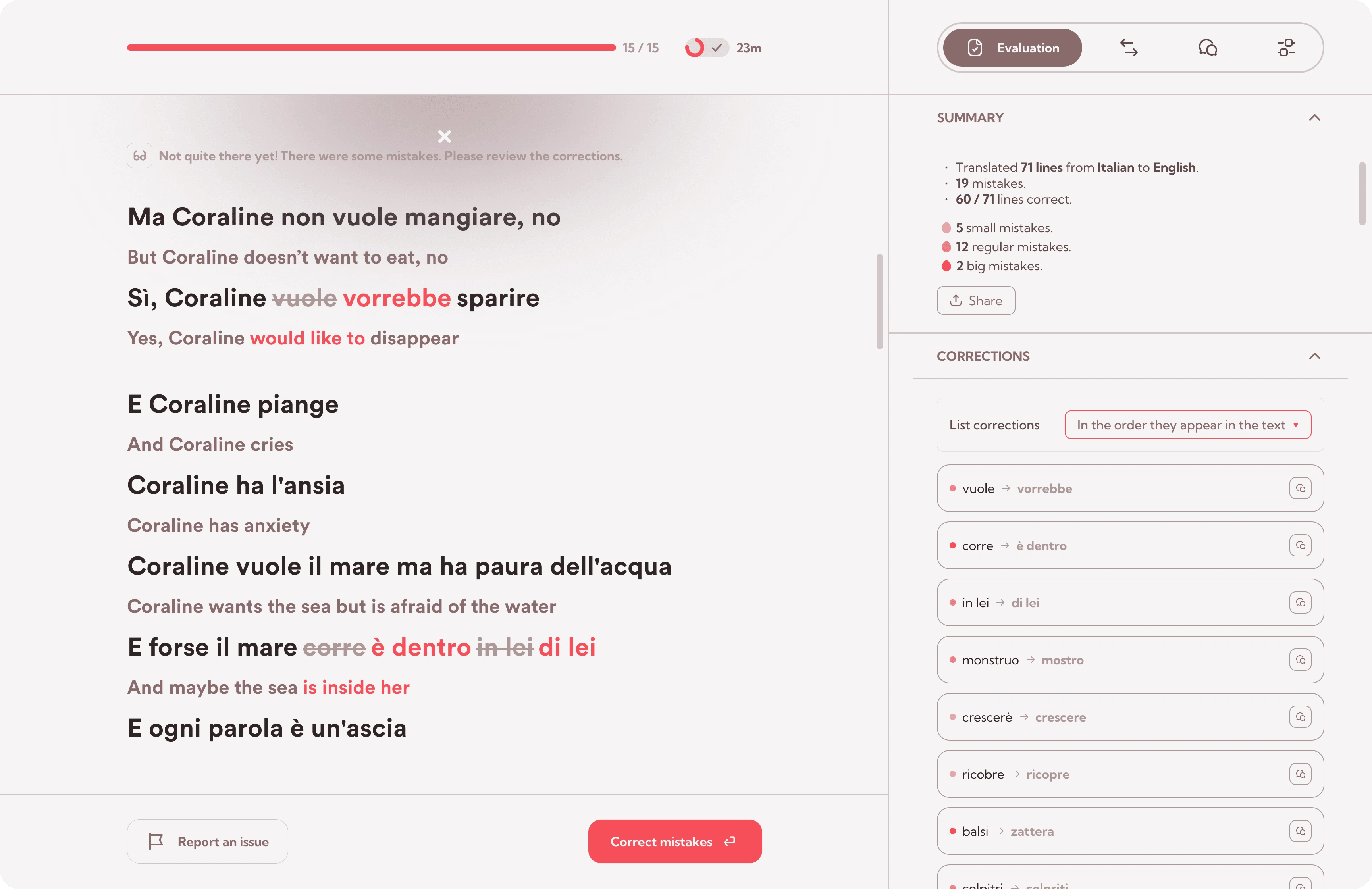
After pressing the "Correct mistakes" button, every line that had errors is turned into an exercise in the Blank Restorer game, where students are given another chance to correctly translate the full line.
And that's it!
After every activity, Verse rewards students with a gratifying overview of what they accomplished.
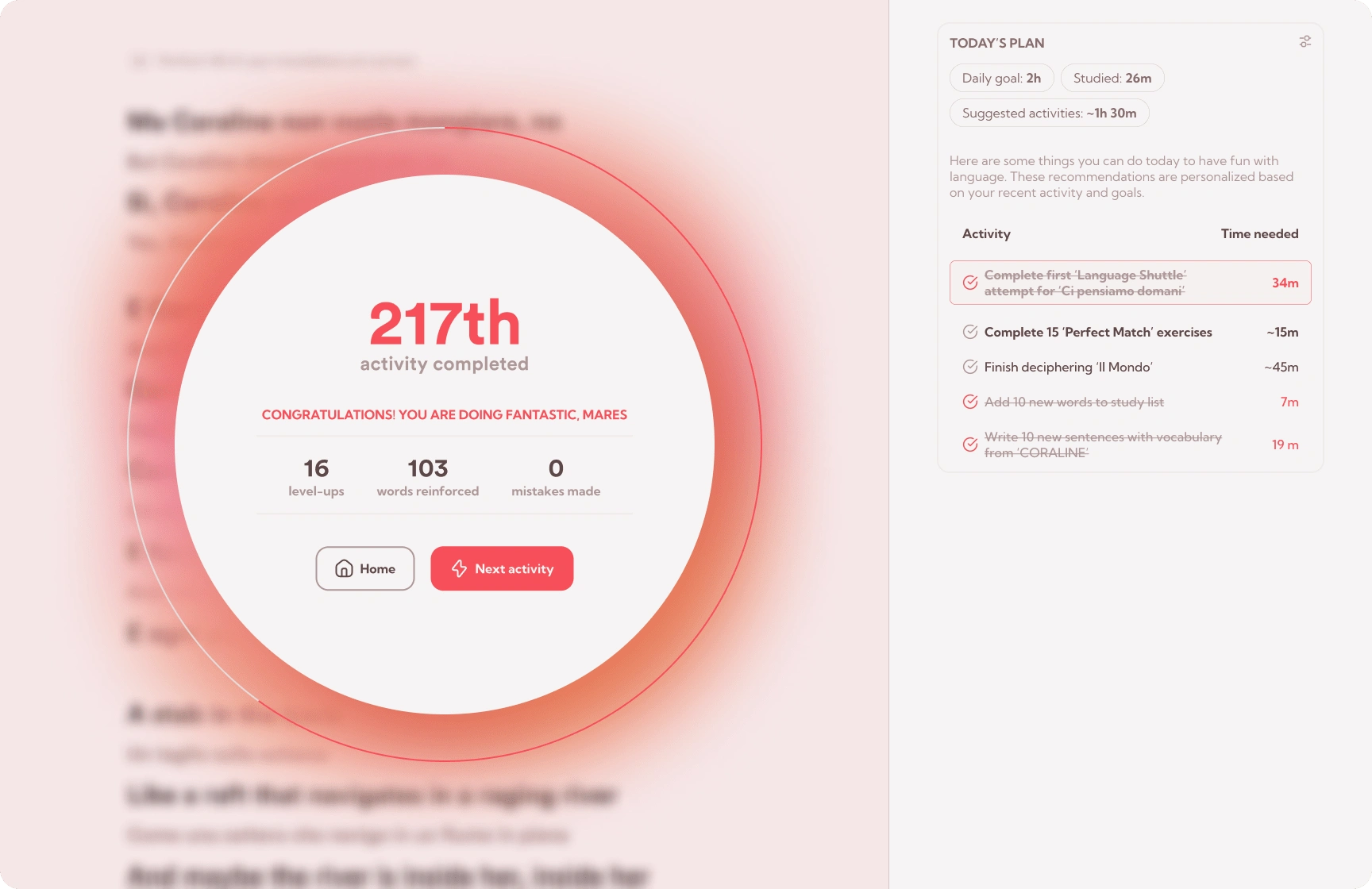
You might have noticed a glimpse of some activity-planning functionality in the capture above, and that may already be giving you an idea of how powerful Verse can be in helping students make the most of every session.
But we'll come back to that later.
So far, we've seen how Verse takes care of the 'Reviewing' component of learning with 3 dedicated games.
And, just like that, there are also 3 games designed to help students with the 'Applying' phase.
Both 'Reviewing' and 'Applying' games challenge students to interpret and output stuff in the language they're learning.
But while 'Reviewing' games make students practice with sentences or lines they've seen, 'Applying' games push them to compose new sentences across all sorts of new contexts.
Let's look at an example through the first 'Applying' game: Combination Explorer.
Remember this analogy?

Well, what Combination Explorer does is shrink the metaphorical ball until it can fit through the basket.
The idea is this: After you learn 5 songs or so, you have enough vocabulary to compose unique sentences that aren't mere copies of sentences you've seen.
So, Verse AI digs through all the words you know and comes up with some new sentences that can be composed using just those words.
It then asks you to translate a line you've never seen, but which you are theoretically able to translate with words you encountered.

(the captions to be translated are AI-generated. they're not something students saw in any lyrics)
To ease students into writing new, unique sentences, Combination Explorer can also create audio-based exercises.
Then, students simply learn of a new line they can write by listening and typing out a sentence made up of vocabulary they know.
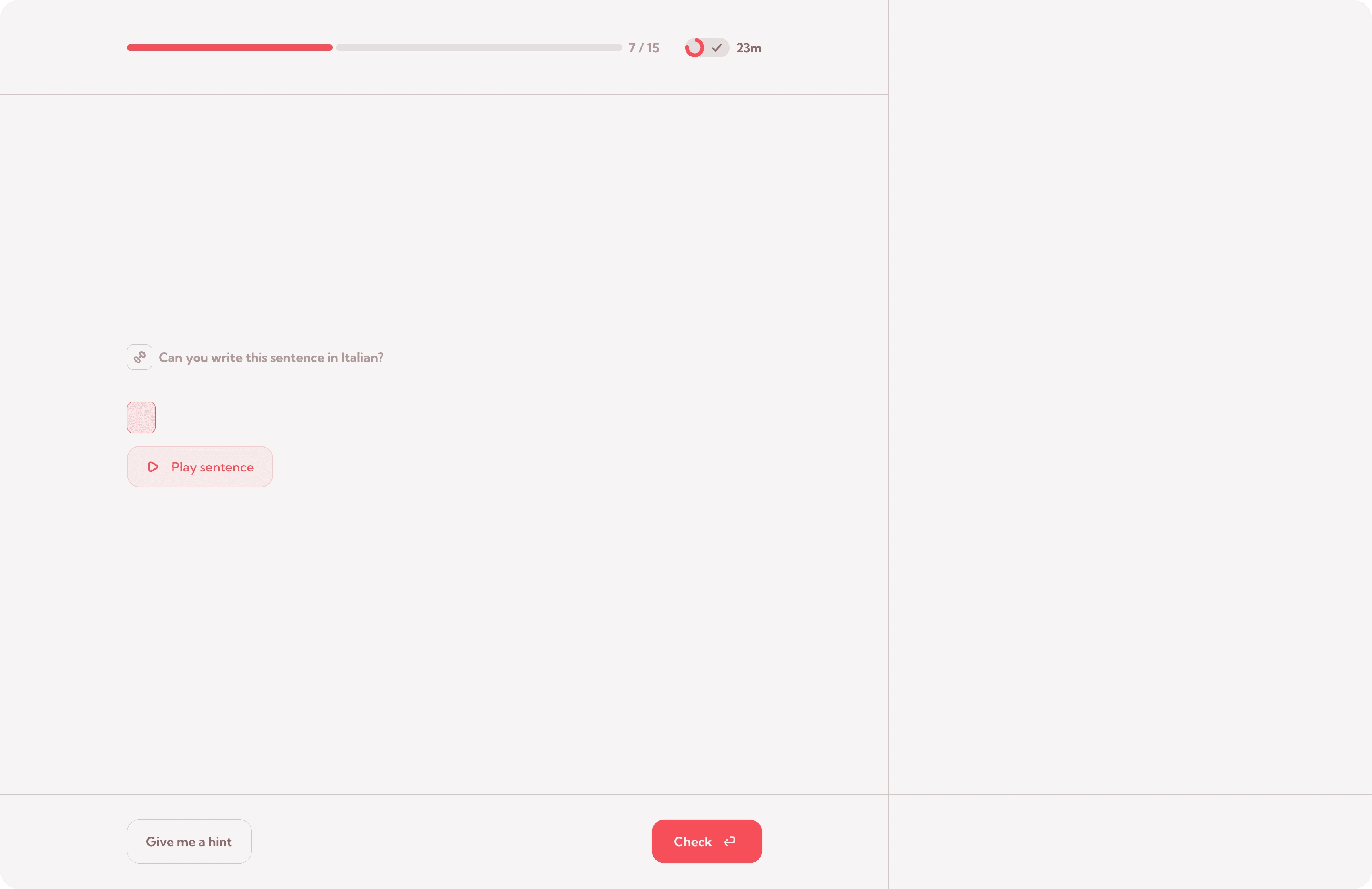
(the audio is in the language they're learning)
Sometimes, however, the sentences Combination Explorer generates will contain one or a couple of words students have not yet seen.
That's useful because learning just a few important words one hasn't yet encountered can significantly increase the things one can express.
The introduction of new relevant words also means that students are not entirely dependent on liking songs that happen to have rich vocabulary.
Through Verse, they can encounter other valuable words through 'Applying' games.
In any case, if students are struggling to translate a sentence, they can press the 'Give me a hint' button to reveal one of the new words, conjugations, or even just a forgotten word they were missing.
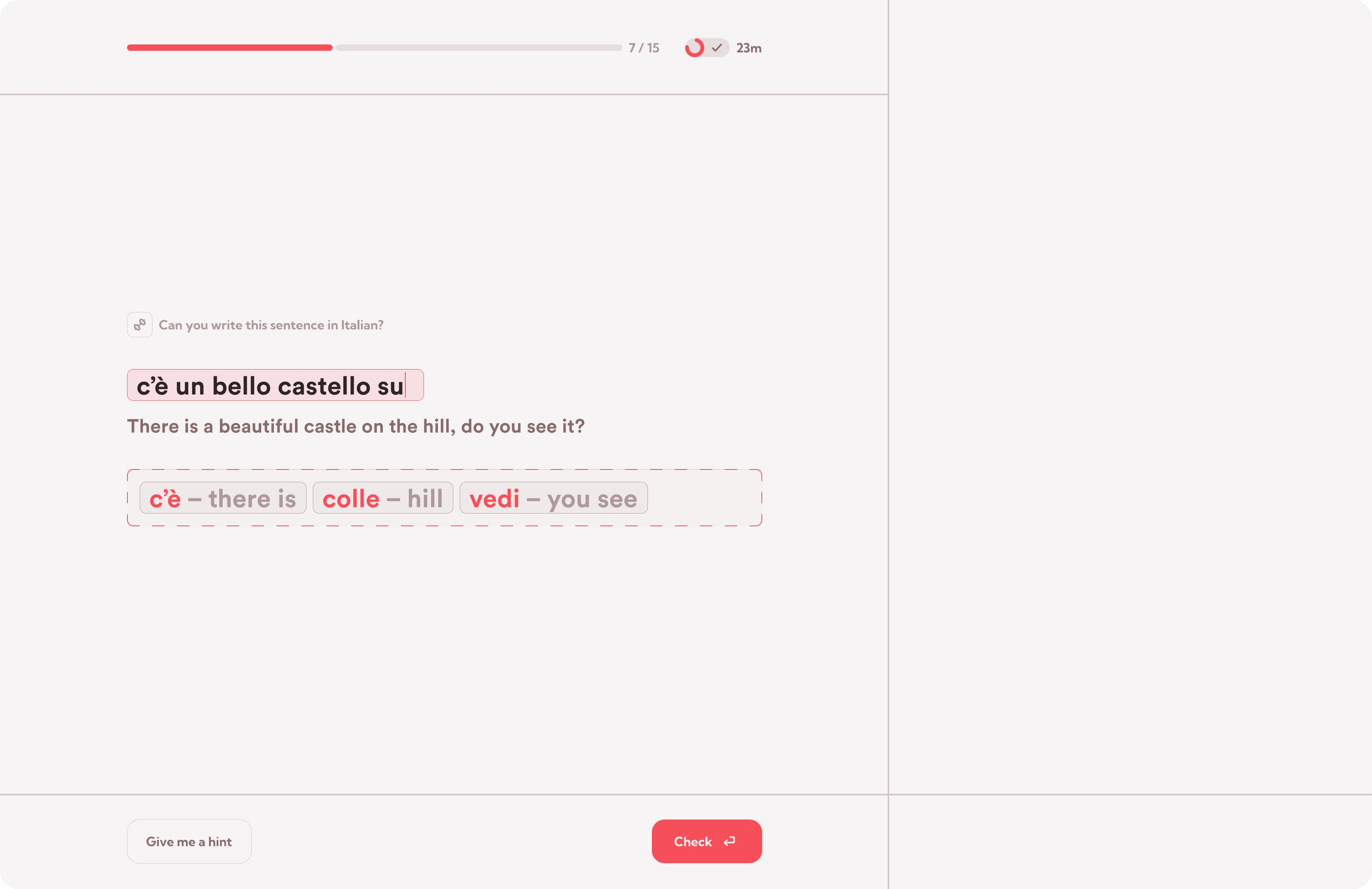
(in this example, the student pressed the 'Give me a hint' button three times)
As usual, this game comes with exercises that challenge students to translate from the language they're learning to a language they know, and vice versa.
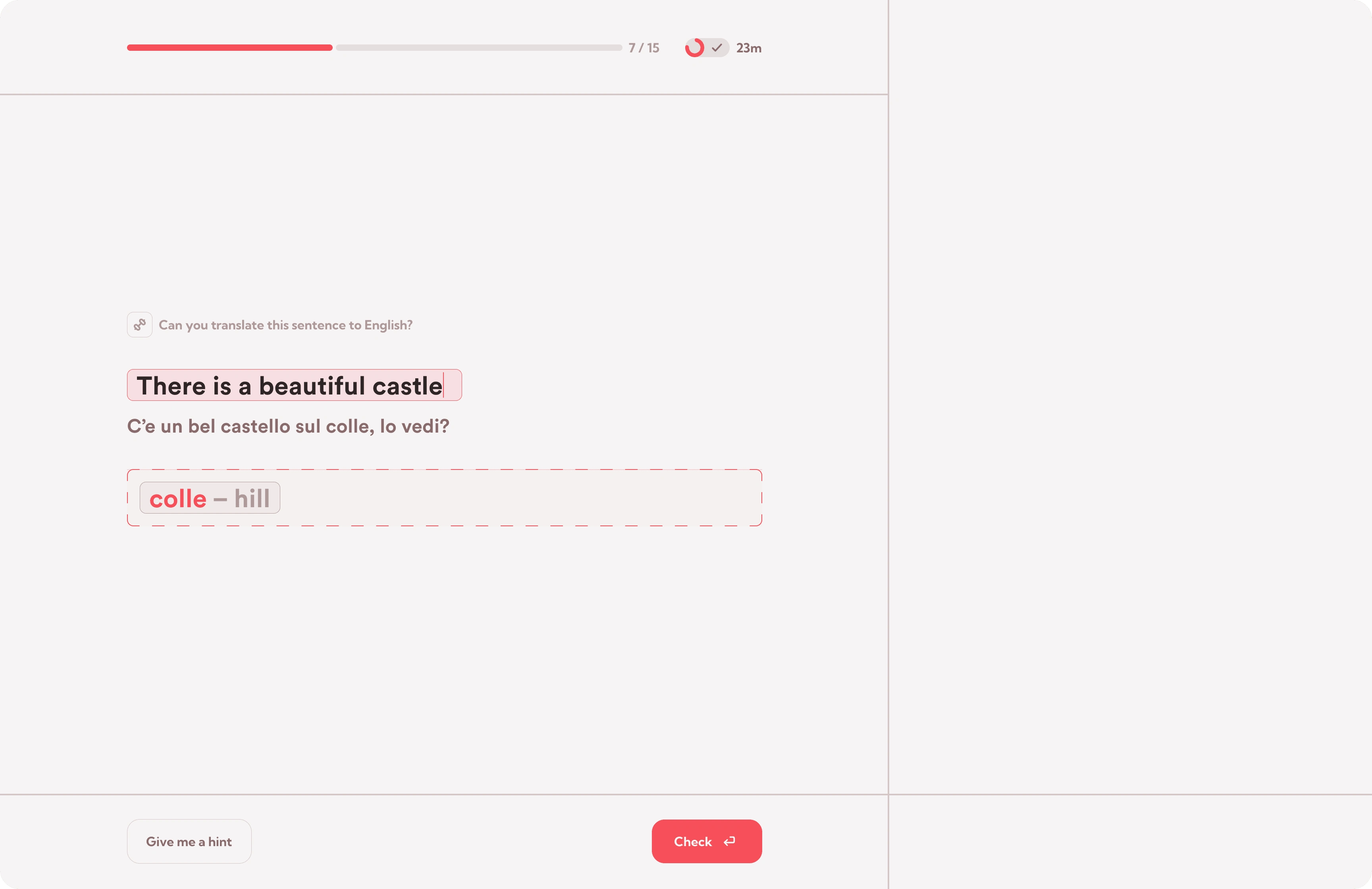
And hints work with audio-based challenges too.
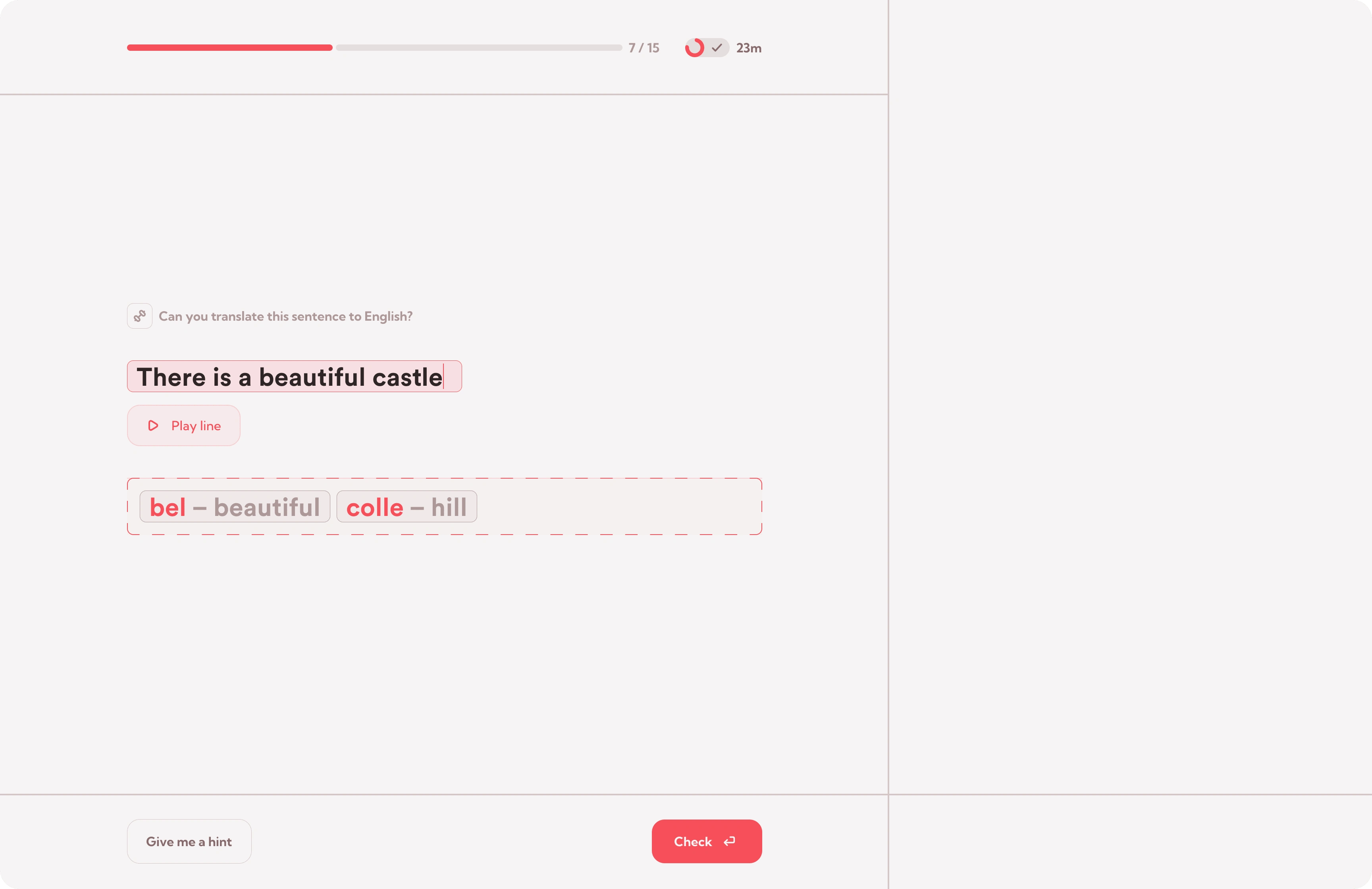
Of course, the fewer hints you use, the higher your score will be at the end of the game in the 'Evaluation' module.
But when you're first getting used to writing new sentences, using hints is expected and fine!
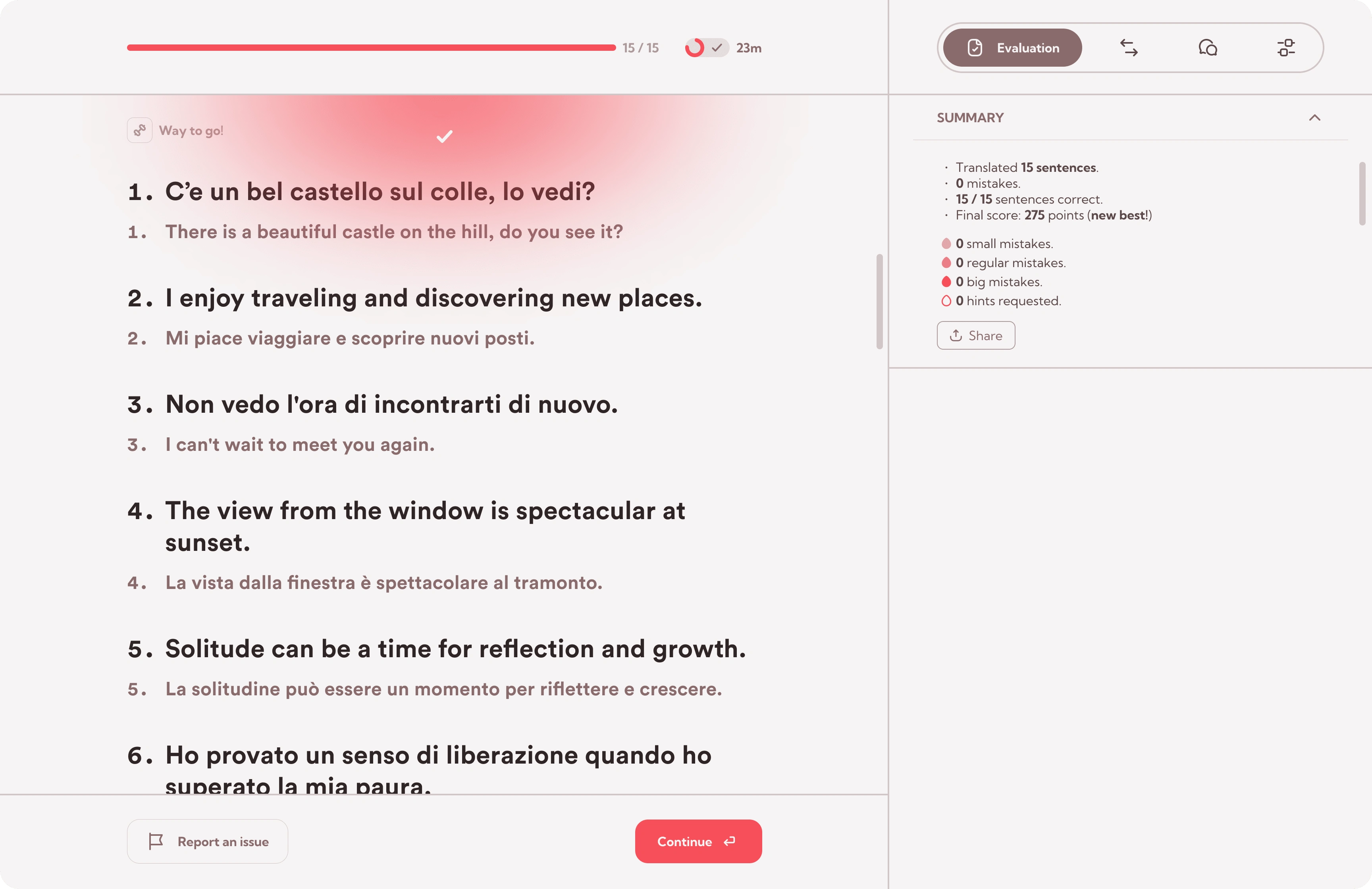
(like in other games, besides this evaluation summary at the end, there's also the immediate feedback after every answer)
As always, students get corrections if they made any mistakes, and an opportunity to do those challenges again before the activity ends.
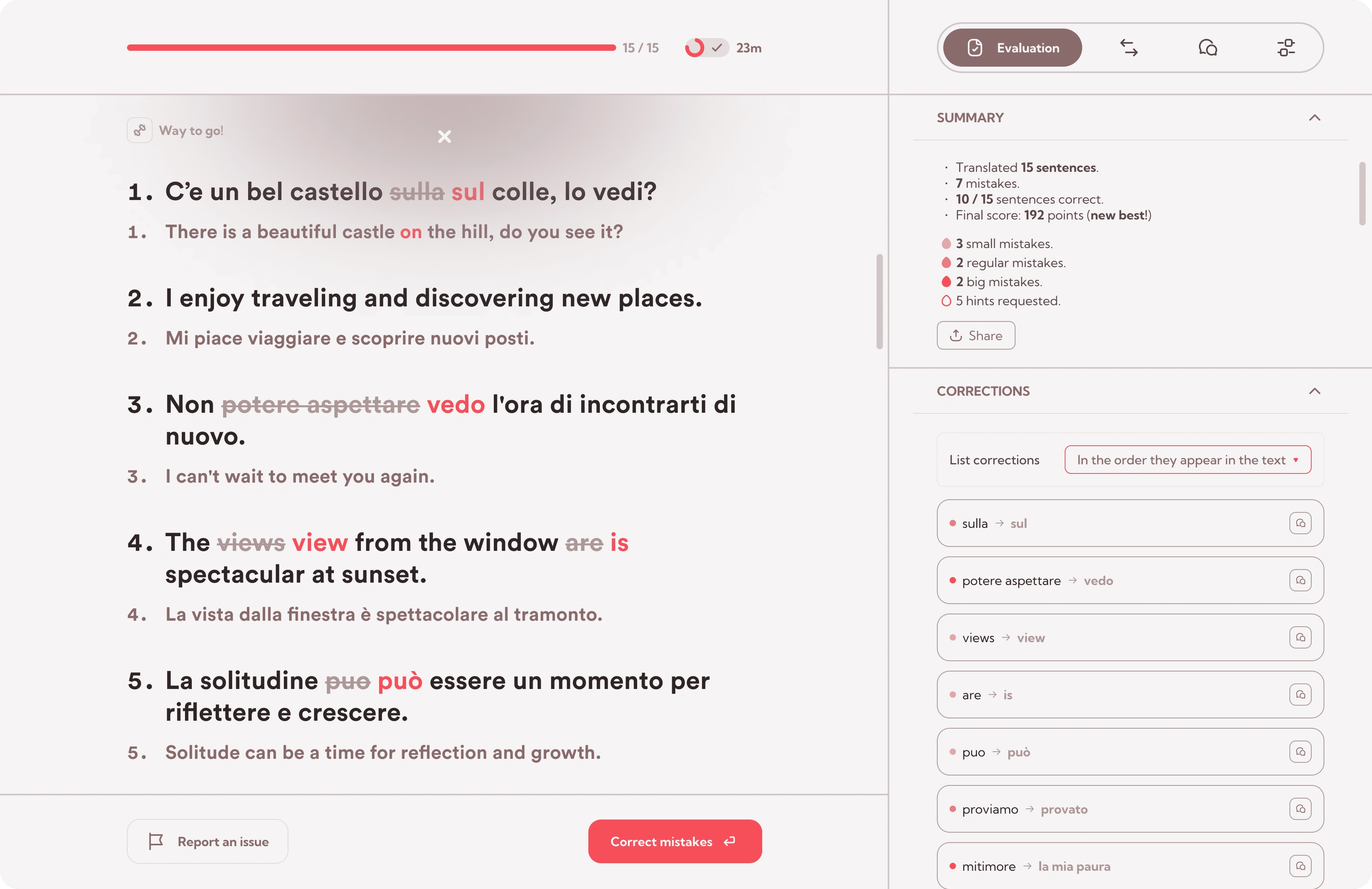
Eventually, students will want to write things of their own. To do that, they will need to write not just isolated sentences, but combine several that work together.
This step can be challenging.
Without enough practice writing longer pieces, articulating and linking many ideas coherently is difficult.
That's where the next game, 'Perfect Match', comes in.
First, students choose a topic they care about.
Verse suggests topics inspired by the lyrics of songs they've recently studied, but users can also define a custom theme.
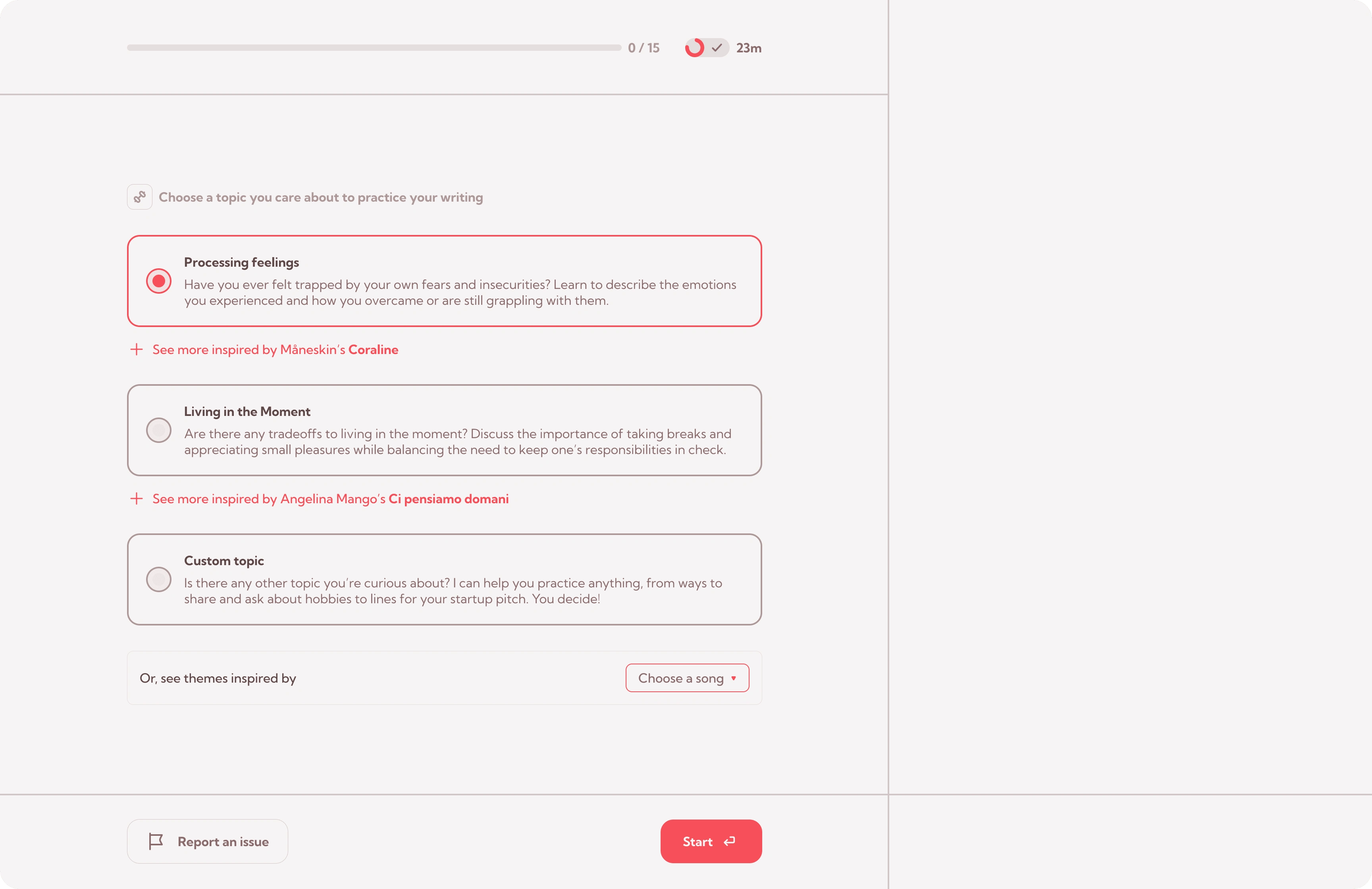
Then, Verse generates several topic-related sentences.
The idea here is to help students pick up useful vocabulary and patterns for talking about a topic they find interesting or relevant now.
To get students comfortable with these new sentences, Verse follows a gradual approach.
When students first see a sentence, the modules pane is enabled, so they can use the Translations or Ask AI modules to make sure they understand it well before continuing.
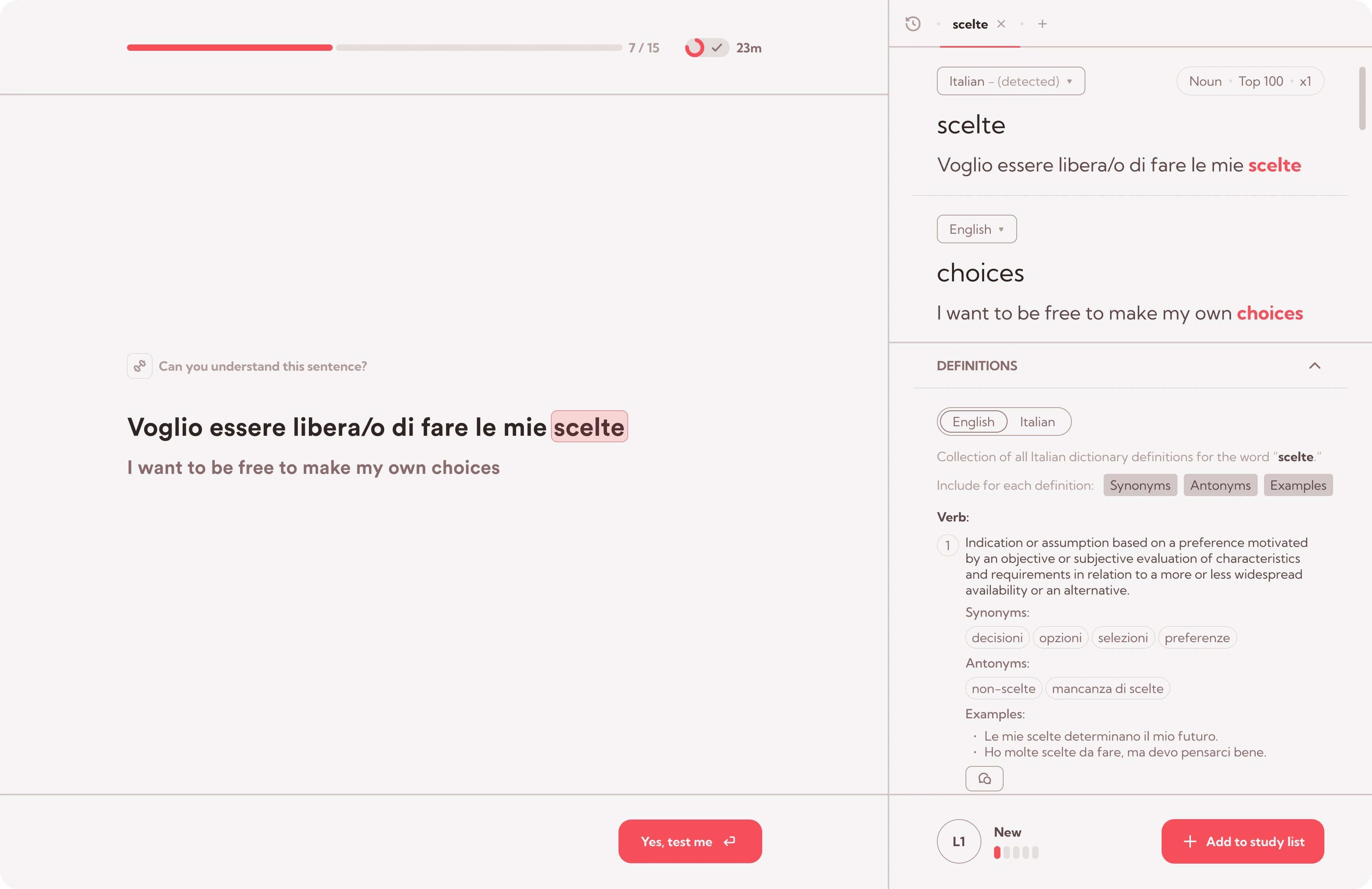
It's important to note that the sentences Verse generates here are not automatically added to the spaced repetition system.
In other words, students don't have to memorize them or review them over time.
If there's a sentence they like, they can highlight it and save it to their study list just like any other content excerpt.
But the main goal here is simply to expose students to new, topic-relevant sentences, so they get a better idea of how to write about the topic on their own later.
To that end, Verse first guides students to pay careful attention to spelling as they type out the sentences.
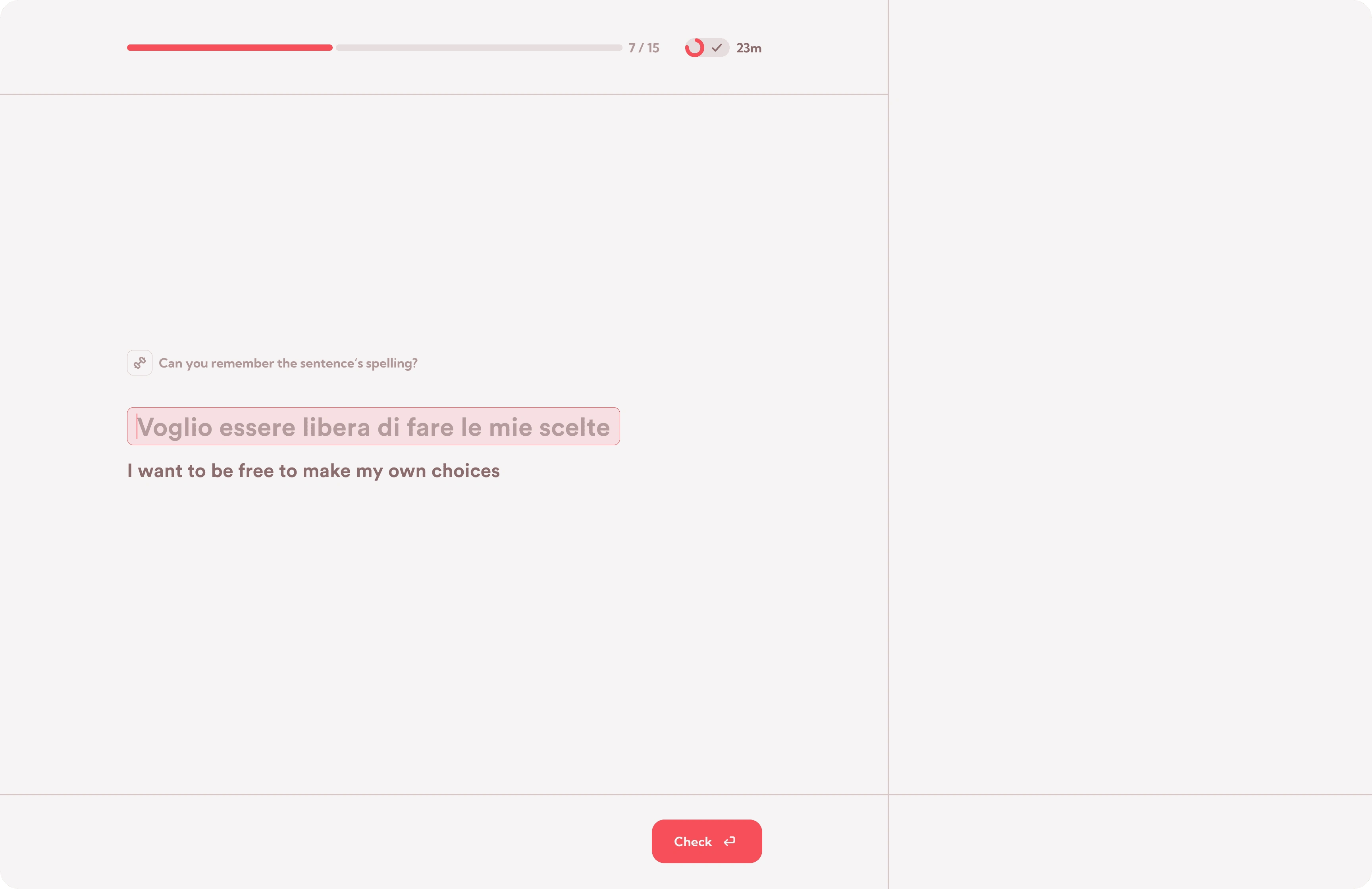
Then, Verse puts students' writing and interpretation skills to the test in its characteristic gradual fashion.
Starting with challenges with just one blank,
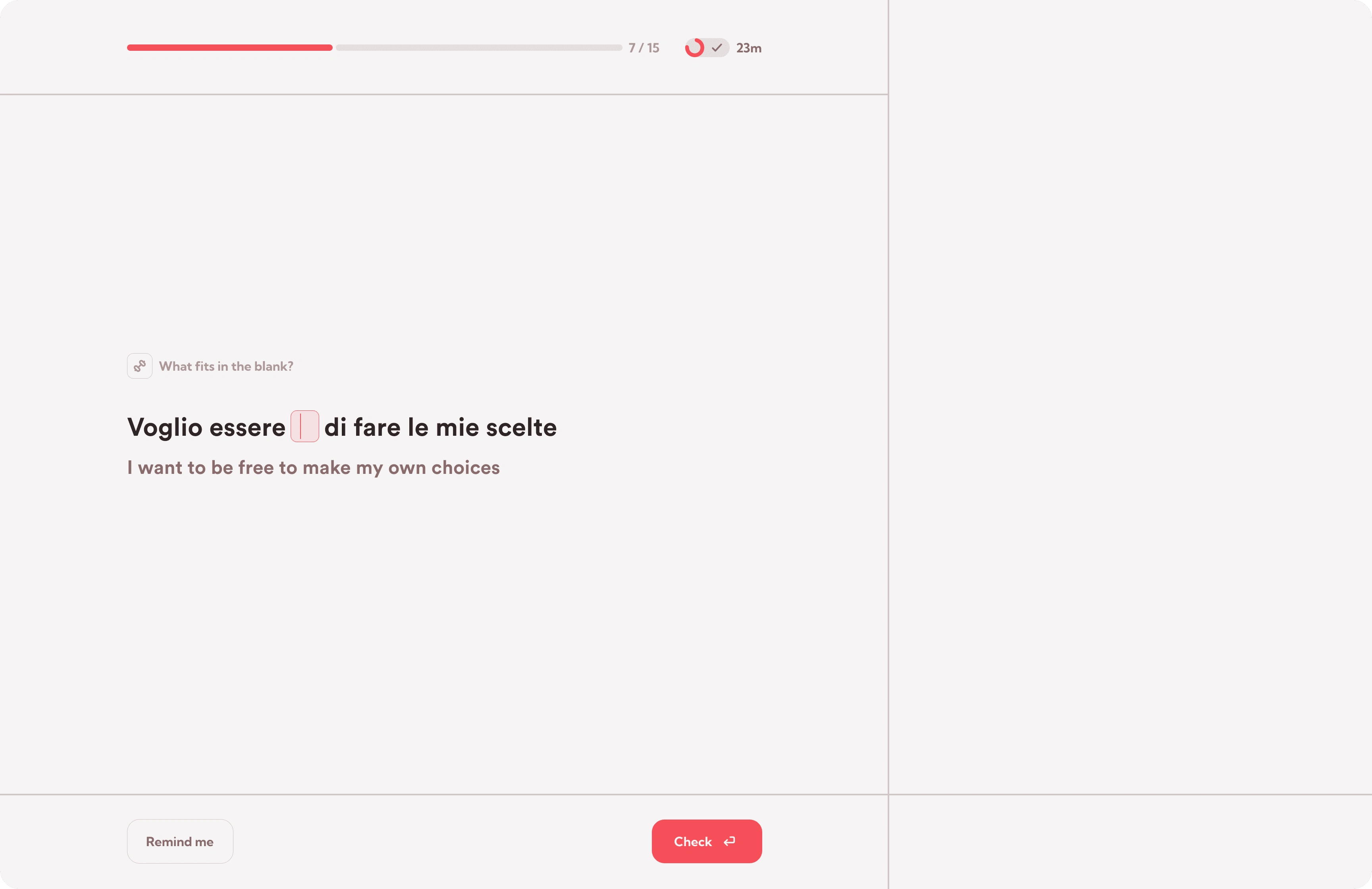
or several,
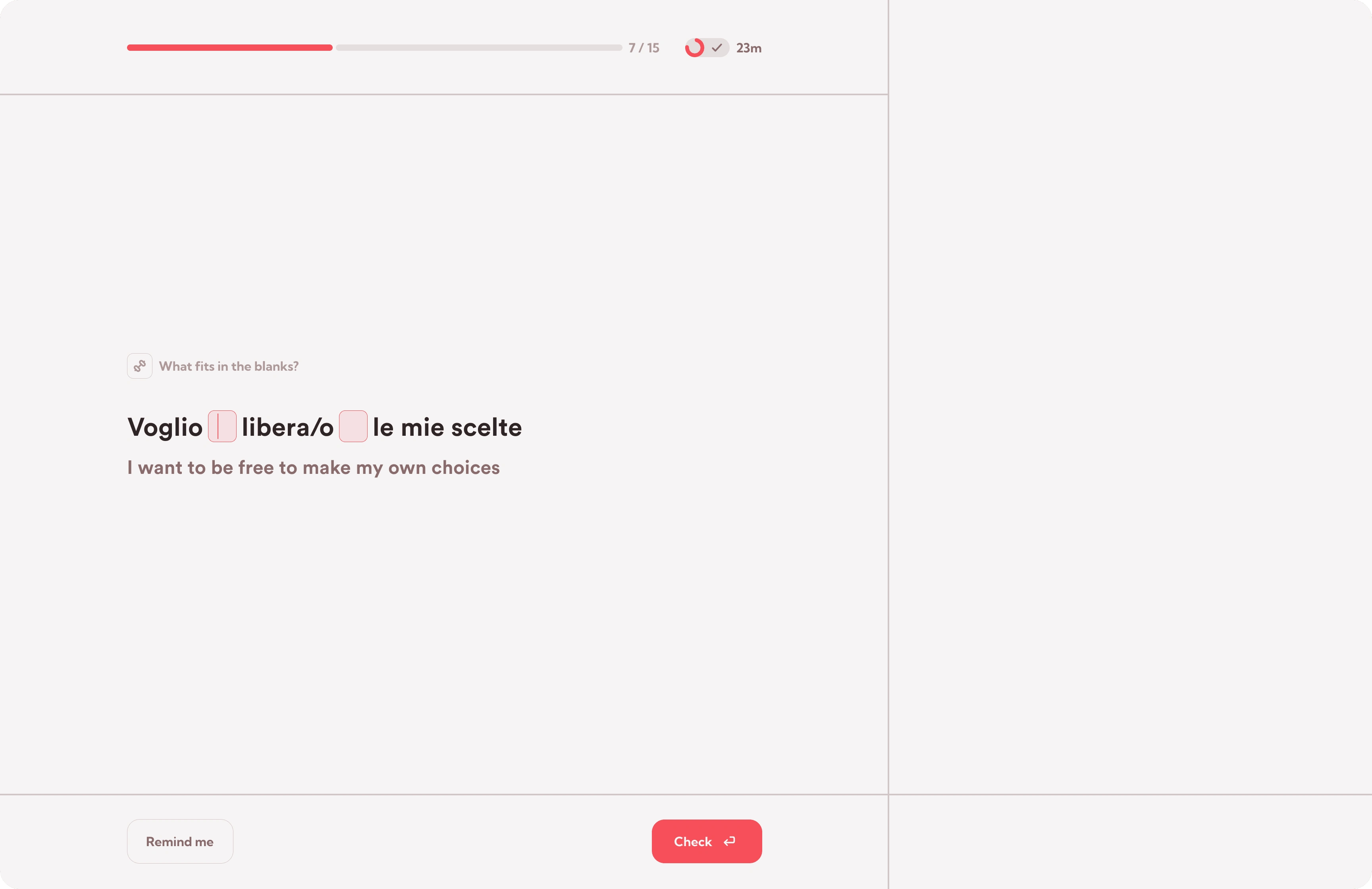
Until students can write the full sentences on their own, without any clues.
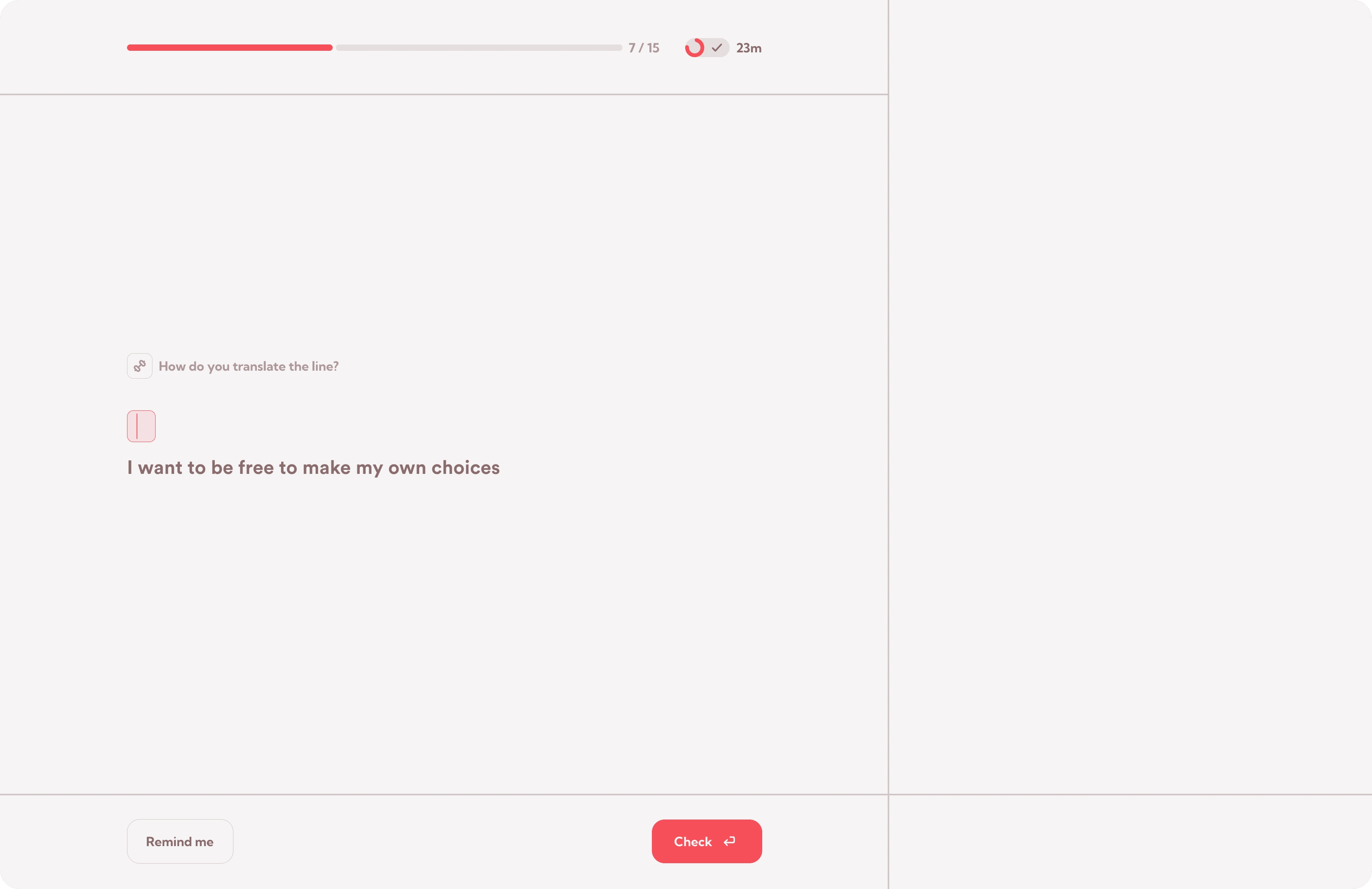
Once students complete the all-blank variation of the challenge for all sentences, Verse generates a new series of challenges.
But, this time, they all range from 1 to 3 paragraphs in length.
The idea here is that students see how to combine sentences and connect ideas to communicate longer more complex things.
The paragraphs generated are not necessarily made of the sentences students saw.
But since they're also related to the topic users selected to practice, they will share much of the same vocabulary and structures.
Beyond merely seeing these useful longer examples, the challenge students face at this stage is to do their best with what they know to try to complete the missing parts in the examples.
In this variation, there are no single correct answers. There could be many words that perfectly match the context of the surrounding text. So, as long as students manage to write something that fits in, Verse AI will accept their solution.
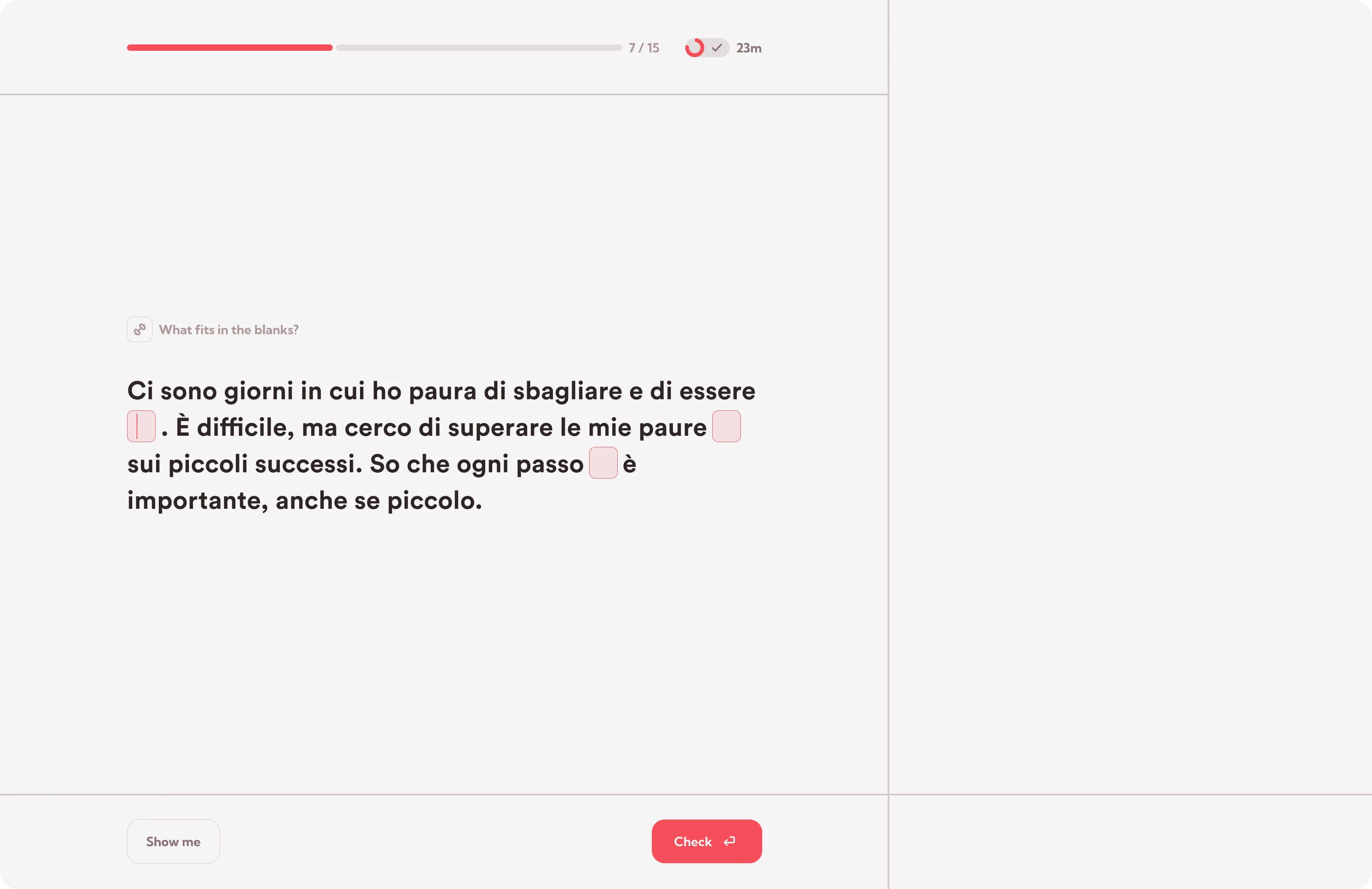
This variation can be difficult, and it's normal if students don't always know how to complete the gaps in a way that makes sense.
But, not to worry. As always, Verse will offer timely feedback to help users improve, showing them what they did right, where they missed, and even other ways in which they could have solved the challenge.
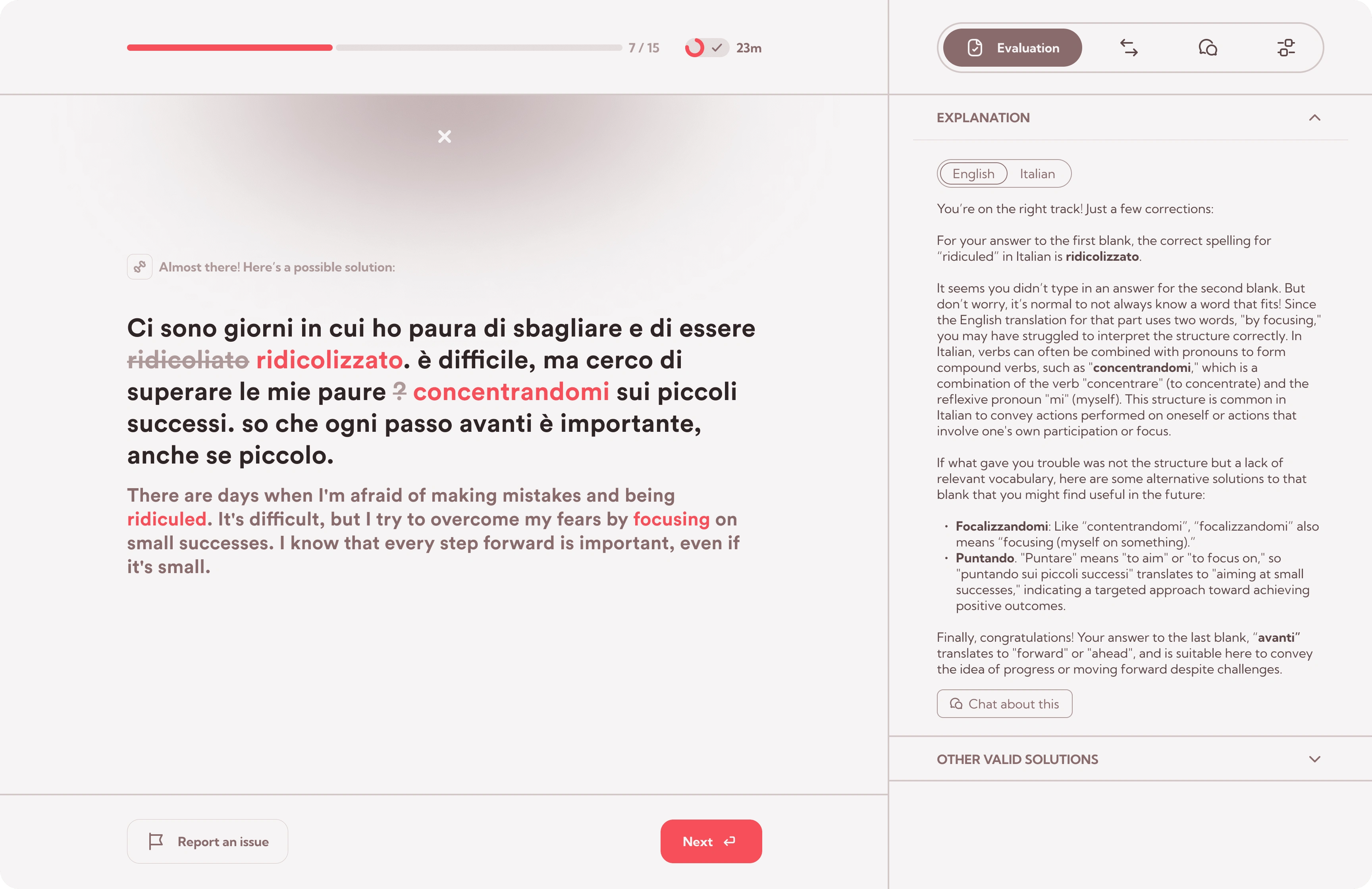
Finally, all this practice prepares students for the last and hardest of all 3 'Applying' games: "Weave Together".
In this game, students write longer pieces of text entirely on their own.
To add a twist that can make the game easier or harder depending on the level of the student, Verse challenges them to write their piece making sure to somehow integrate all of the words in a list.
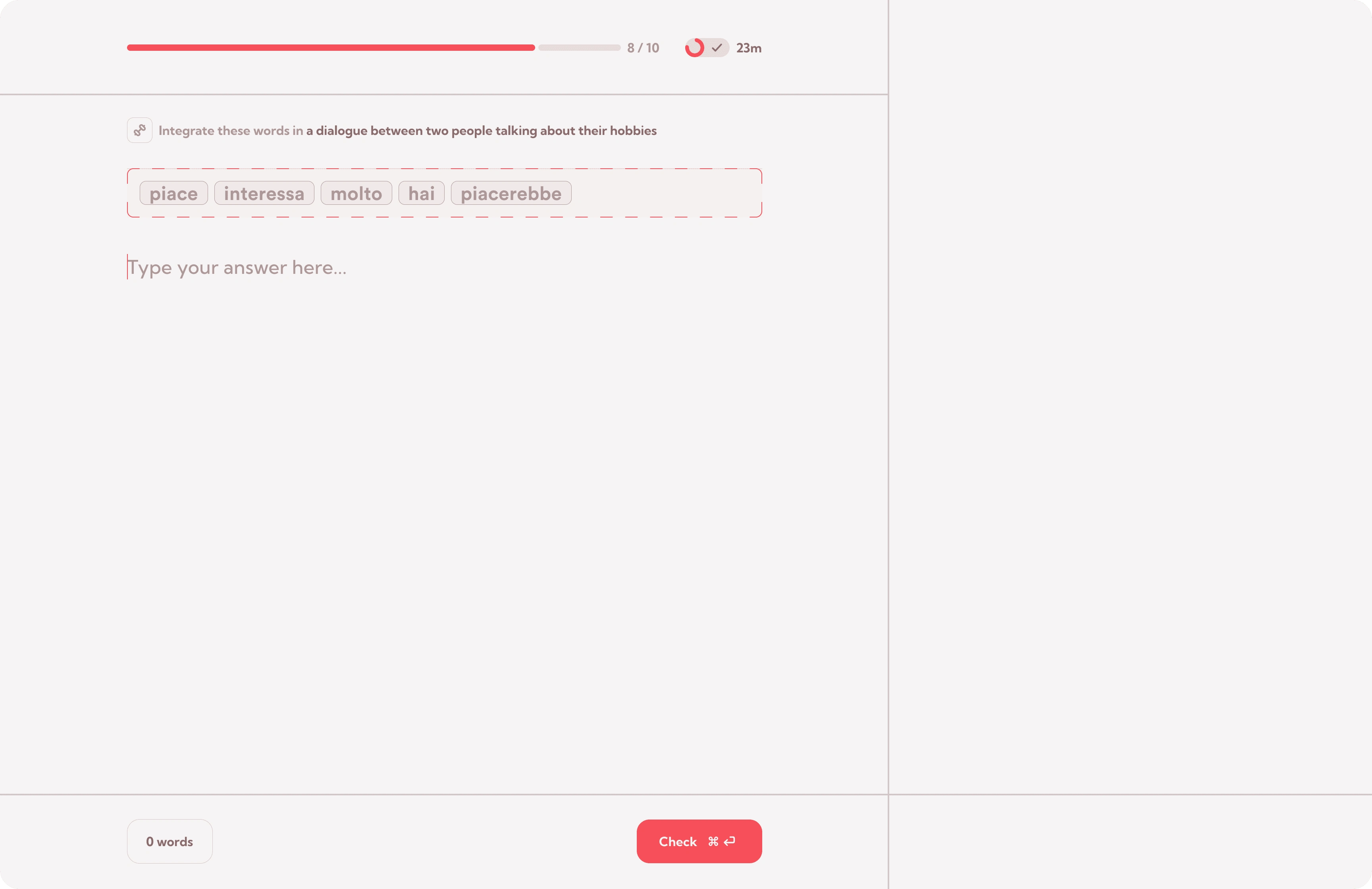
(all required words are words students already know)
Although inherently difficult, it's also possible to adjust the level of this challenge with 4 variables:
Required words: The fewer words that have to be integrated, the easier.
Word relatedness: The more related the required words are to each other, the easier.
Word relevance: The more relevant the required words are to the theme, the easier.
Prompt theme: The more general the theme, the easier.
The example in the screenshot above, for example, is somewhat easy. It has a narrowly defined theme, but it has few required words that are all relevant to the theme and reasonably related to each other.
For more advanced students looking to push their skills further, Verse could challenge them, for example, to write a short story integrating a bunch of completely unrelated words, or even set the theme not just based on a topic, like "hobbies", but a quality, like "write a persuasive essay about X", where Verse AI would also grade students on how persuasive they managed to be.
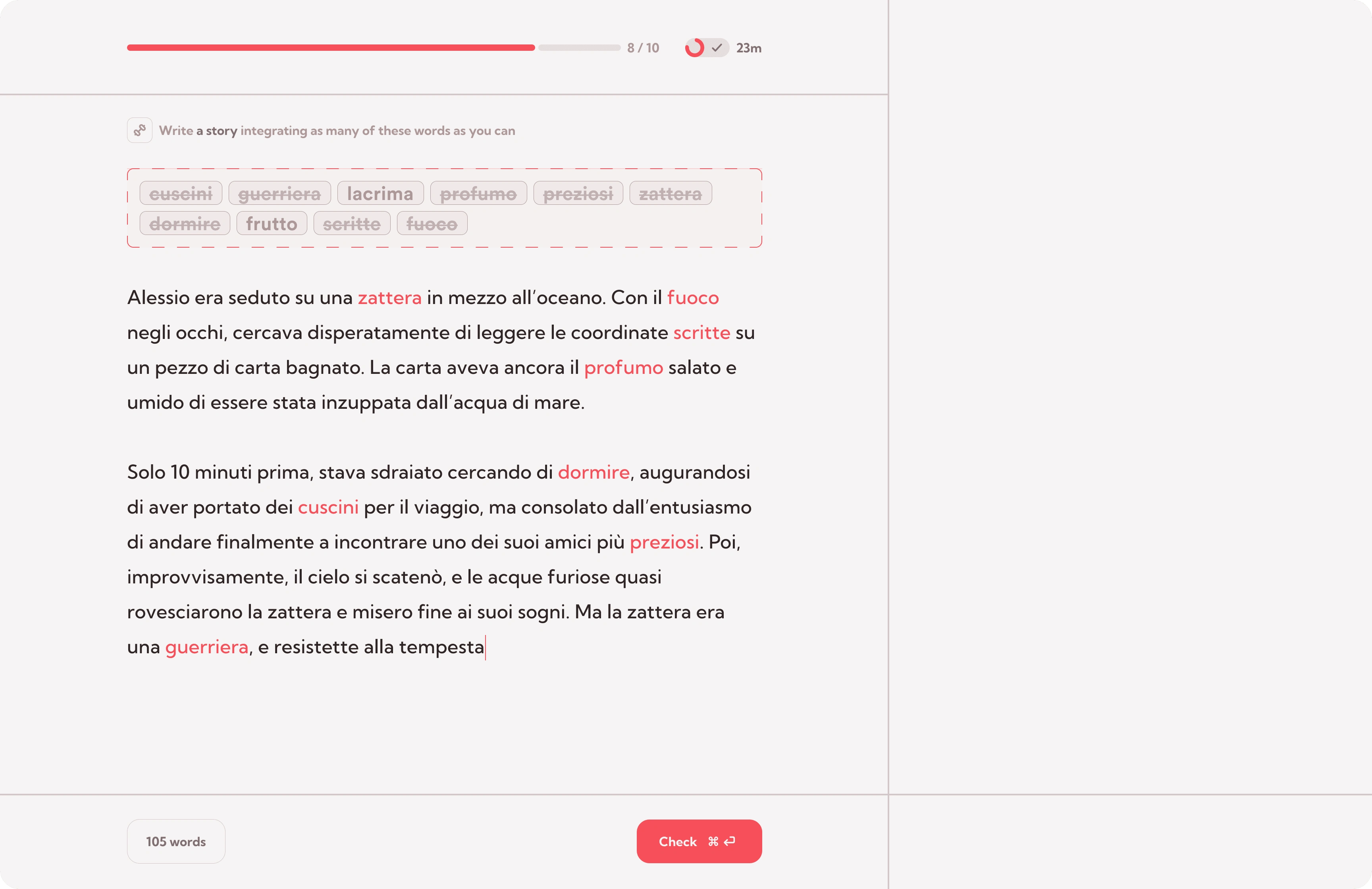
(Verse crosses out and highlights the words in the list of required words that have already been integrated)
In any case, as always, students are also free to set a custom theme to practice writing about something interesting and relevant to them now.
Just like in Perfect Match, by default, Verse suggests topics based on the lyrics they've been studying and, more importantly, based on the themes they have been practicing through Perfect Match.
And, of course, after the game ends, students can see how they did,

Getting both feedback and a chance to correct their mistakes, if they had any.
Since an LLM is doing the grading behind the scenes, students can also write portions of their response in their native language if they get stuck, and Verse will pick up on what they wanted to say when it makes its corrections.
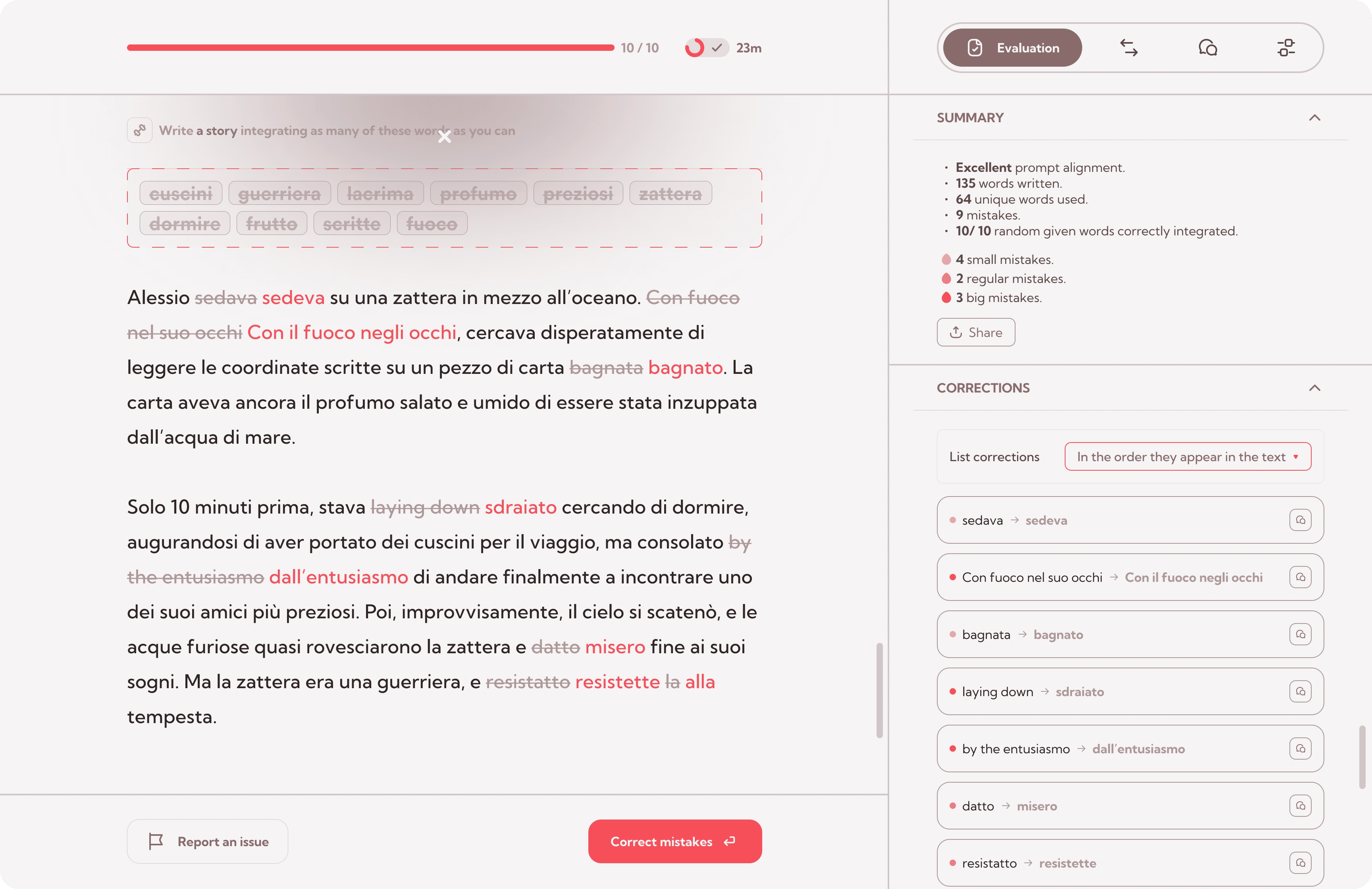
(corrections for what you wrote in your native tongue show you how to speak the way you do but in a new language)
And that's it!
To summarize what we've seen, Verse comes with 3 Reviewing-oriented games, each with a unique purpose:
🧩 Blank Restorer: Internalize the vocabulary and structures found in the songs studied.
🧱 Word Bricks: Recall topic-specific vocabulary and reinforce waning words.
🚃 Language Shuttle: Translate entire studied lyrics back and forth in one's own words.
And 3 applying-oriented games:
🧪 Combination Explorer: Discover new things you can say with known vocabulary.
💞 Perfect Match: Get exposed to useful structures and vocabulary to write about a topic.
🧵 Weave Together: Find your voice and practice writing new things entirely on your own.
Combining these games with its robust set of modules and features for understanding real-life content, Verse offers a complete solution that takes elegant care of the full learning cycle.
8. Connect the dots
The learning experience is at the heart of Verse, but a heart can't stand without a body to support it.
A great immersion-based language solution needs to also make it easy for students to:
🧃 Discover juicy content.
🗺️ Track their progress.
📥 And manage the vocabulary they learn.
In Verse, 3 dedicated pages do just that.
Let's start with Discovery.
Through YouTube embeds and, optionally, the linking of a premium Spotify account, Verse offers its users a vast catalog of music to learn from.
Students can then discover songs by difficulty, genre, or even the topic of their lyrics.
Or, if they know exactly what song they want to learn, they can also search for it by its title or artist.
And, if for any reason the song they want isn't on Spotify or YouTube, they can also upload a local audio file and paste in its lyrics to learn it with Verse.

(if there are no matches for a search term, Verse offers to import a local file. alternatively, the "+" button also does that)
Now, when students look at the songs from a search or the ones Verse recommends, each comes with 2 indicators to help students evaluate them at a glance: Difficulty and overlap.
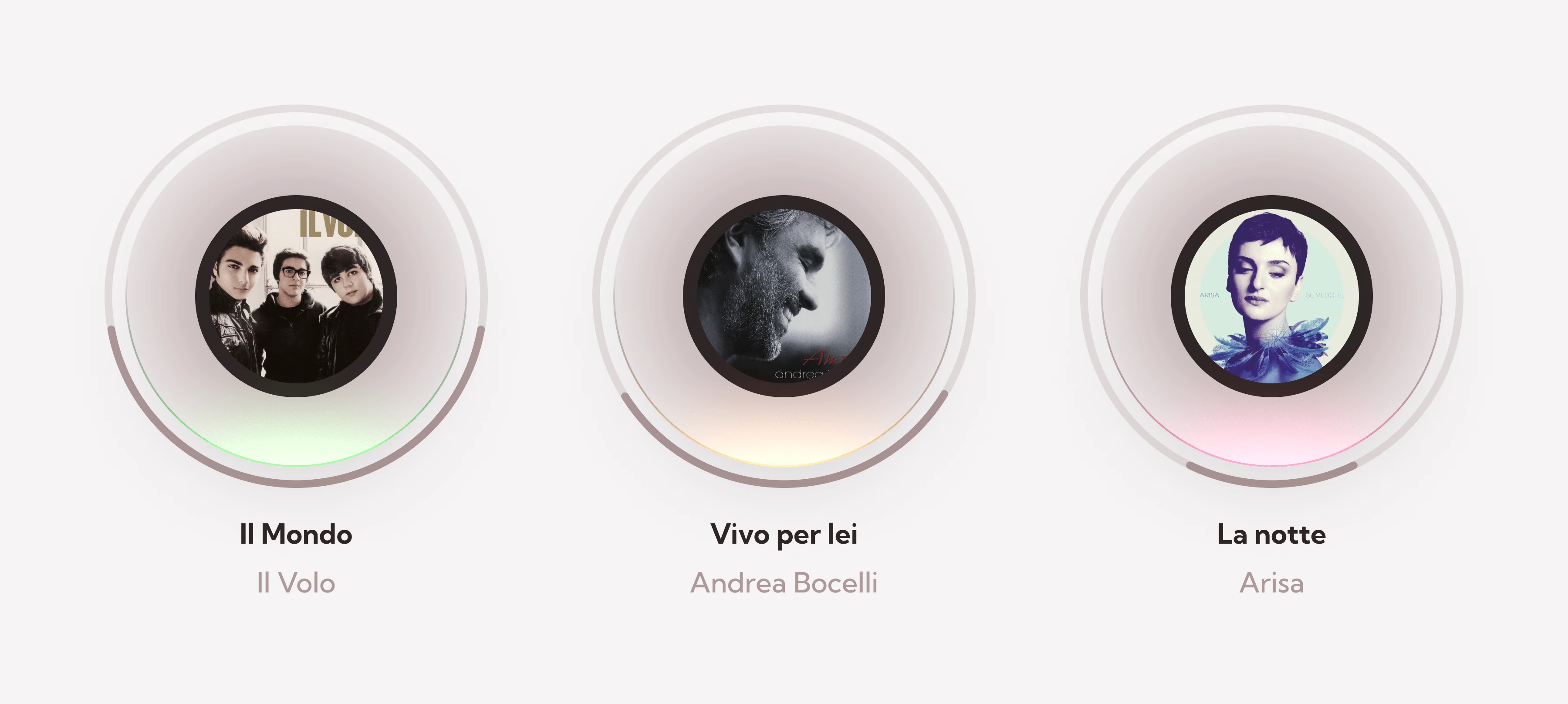
The color of the light at the bottom of the vinyl signals whether, based on the vocabulary and structures in the lyrics, the song is easy, intermediate, or hard.
The ring around the vinyl shows how many of the unique words in the song the student already knows. Fuller rings mean students will likely not need to check word meanings as often.
Combining what we've seen so far with personalized and curated recommendation lists, Verse makes it easy for students to find songs that are at the right level of difficulty, and that suit their tastes or interests.

And, before students decide to study a song, they can also have a look at other cool details about it, like how many new words it will add to their vocabulary, the themes covered by its lyrics, or even listen to it first to make sure they like it.
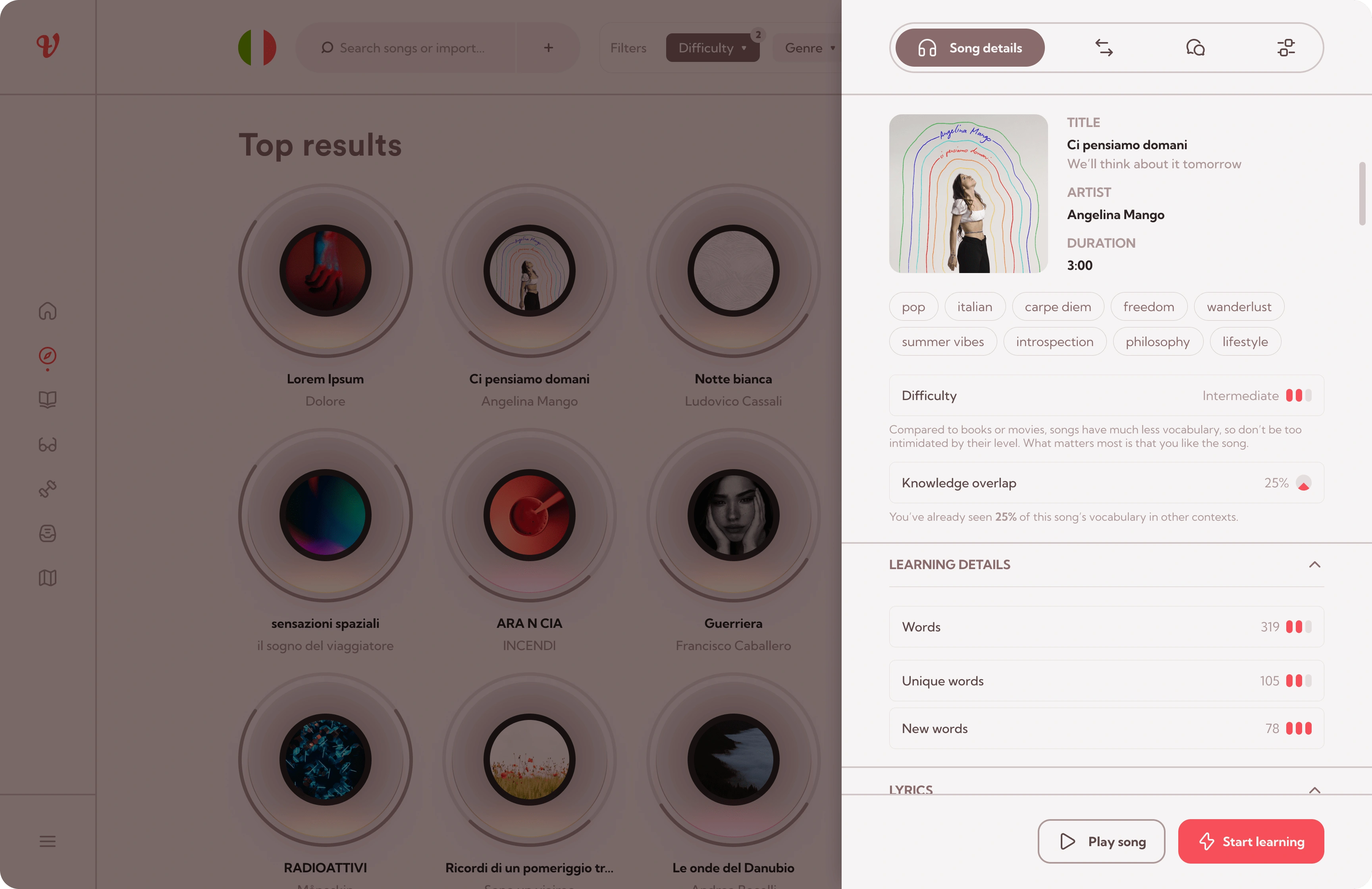
(to maintain a higher results density, tapping on a vinyl in the Discover page brings up the modules pane as an overlay)
Next, we have the stats page, where users can get an overview of their learning journey.
Other apps typically have leaderboards, streak counts, and XP graphs, but I believe that motivation is something very personal, and can vary widely across individuals.
While some may be motivated by competition and social ranks, others might be more motivated by collaboration or prefer to focus on their steps, without looking at anybody else's.
For that reason, I designed the stats page to be made up of widgets that users can add or remove as they please to create a dashboard that motivates them the way they like.
For example, here's a simple heatmap widget that helps students see, at a glance, the days in which they studied over the last year, and for how much time.
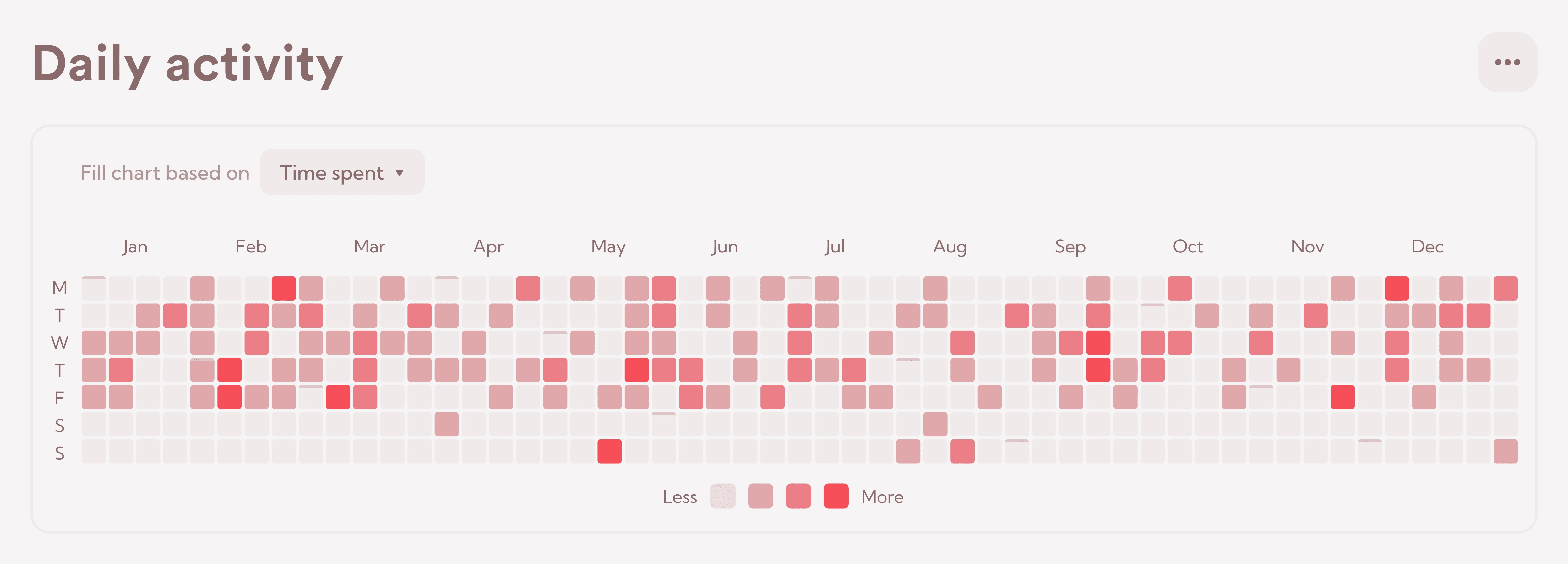
(heatmaps are very insightful; the same chart could be used to show the days when they learned the most words, etc.)
Or check out this other widget, which shows the progress of assimilating the vocabulary encountered.
Early on, most words were new. But as time passes, there are increasingly more deciphered, familiar, and understood ones, until, eventually, one fluently commands most of the words in one's vocabulary.
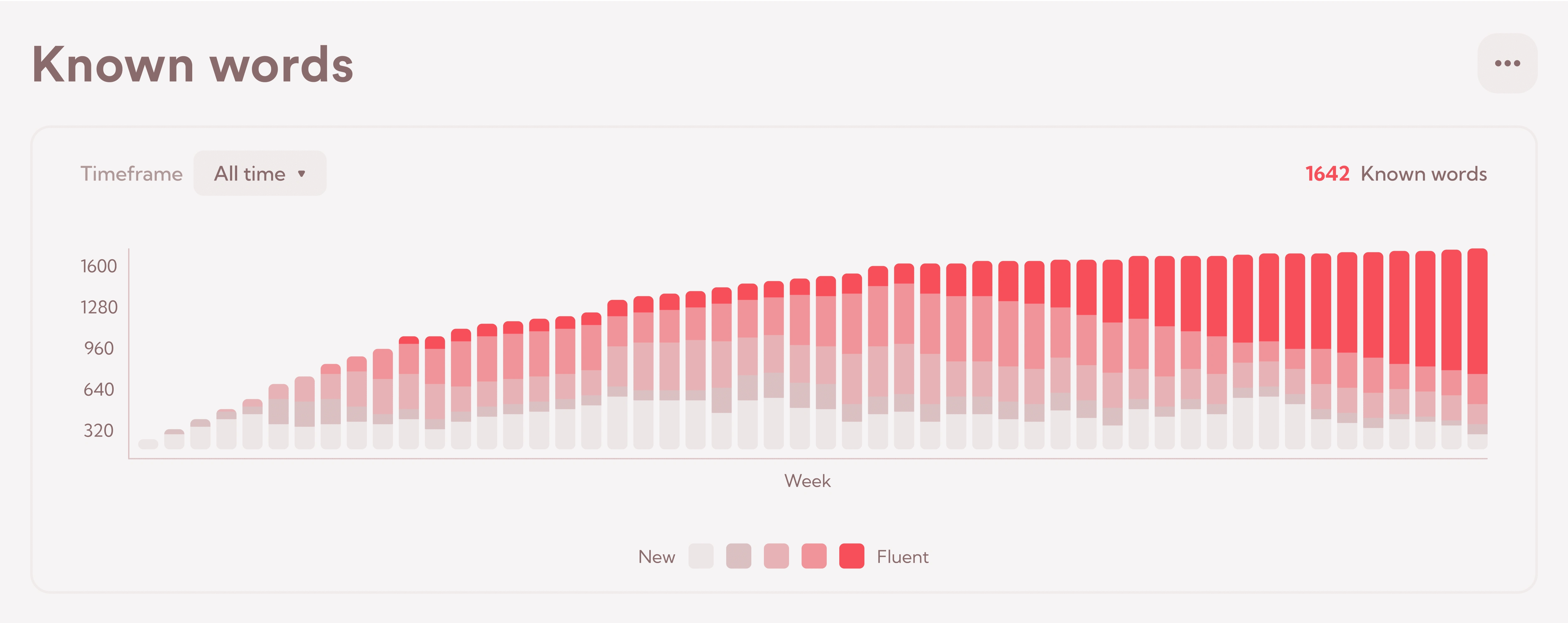
And my personal favorite, 'Milestone projections'.
With this widget, you can set a goal (like, "I want to learn 50 songs"), and see exactly when, at the current pace you're learning, you will reach it.
Optionally, students could also set a hypothetical pace (typically a faster one than the current one) to see how much sooner they'd reach their goal if they could keep that pace.
Alternatively, the widget even supports setting a deadline for the goal by yourself (like "by the end of this year"), and then it figures out the pace you'd need to maintain and the dates at which you should be hitting specific milestones.
With this widget, you can easily see whether you're on track to reaching your goals, and exactly how much you need to accelerate in case you need to catch up!
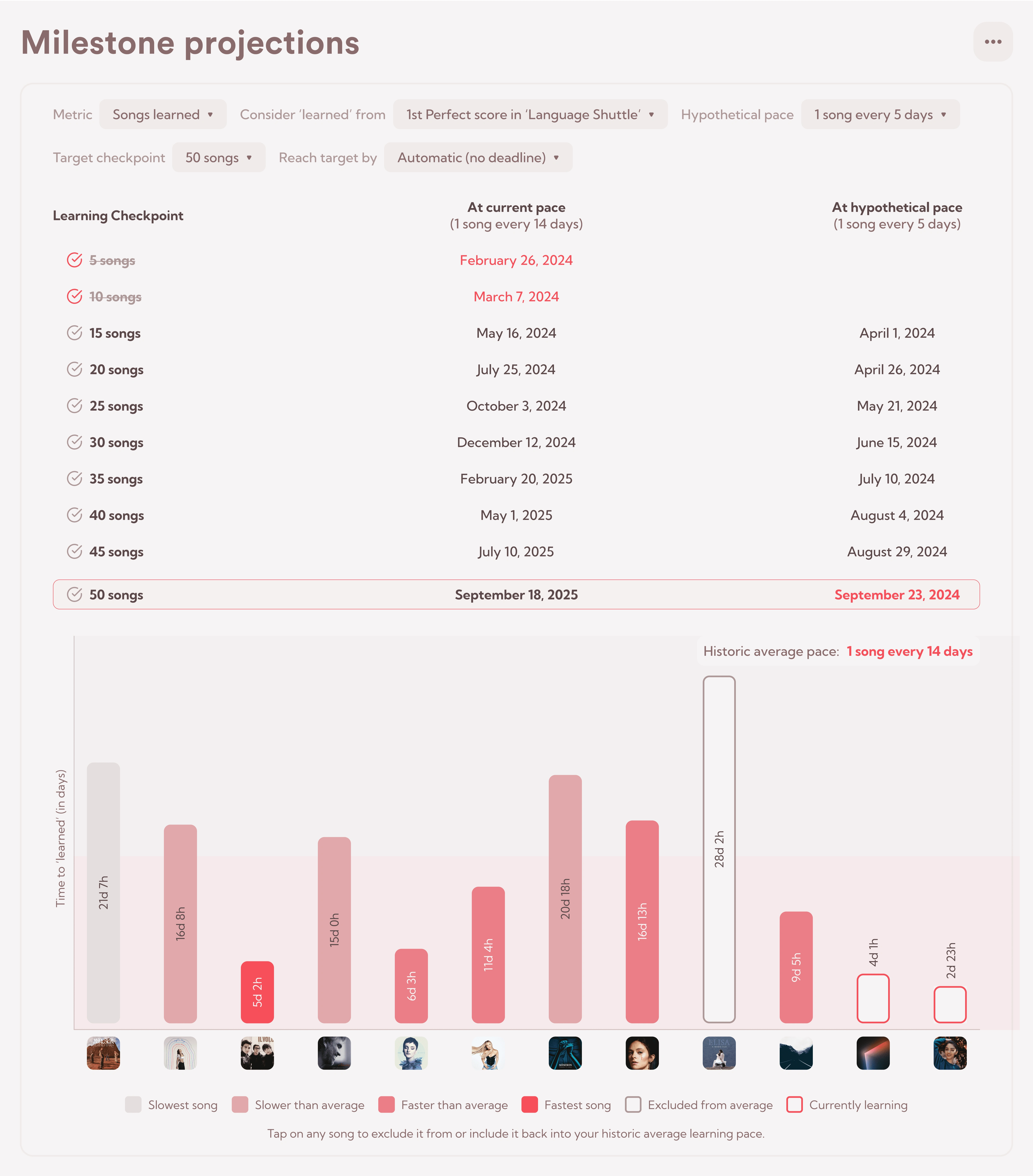
These are the widgets I've designed so far. In the future, there could be a leaderboard widget, or a guild's widget where people can combine their progress to hit milestones together, etc.
Again, the idea is that people can add or remove widgets until they get a motivating dashboard that fits their learning style, and not one combination is imposed on everyone.
A more mature version of Verse could even expose an API for the community to build and share widgets of their own for everyone to use.
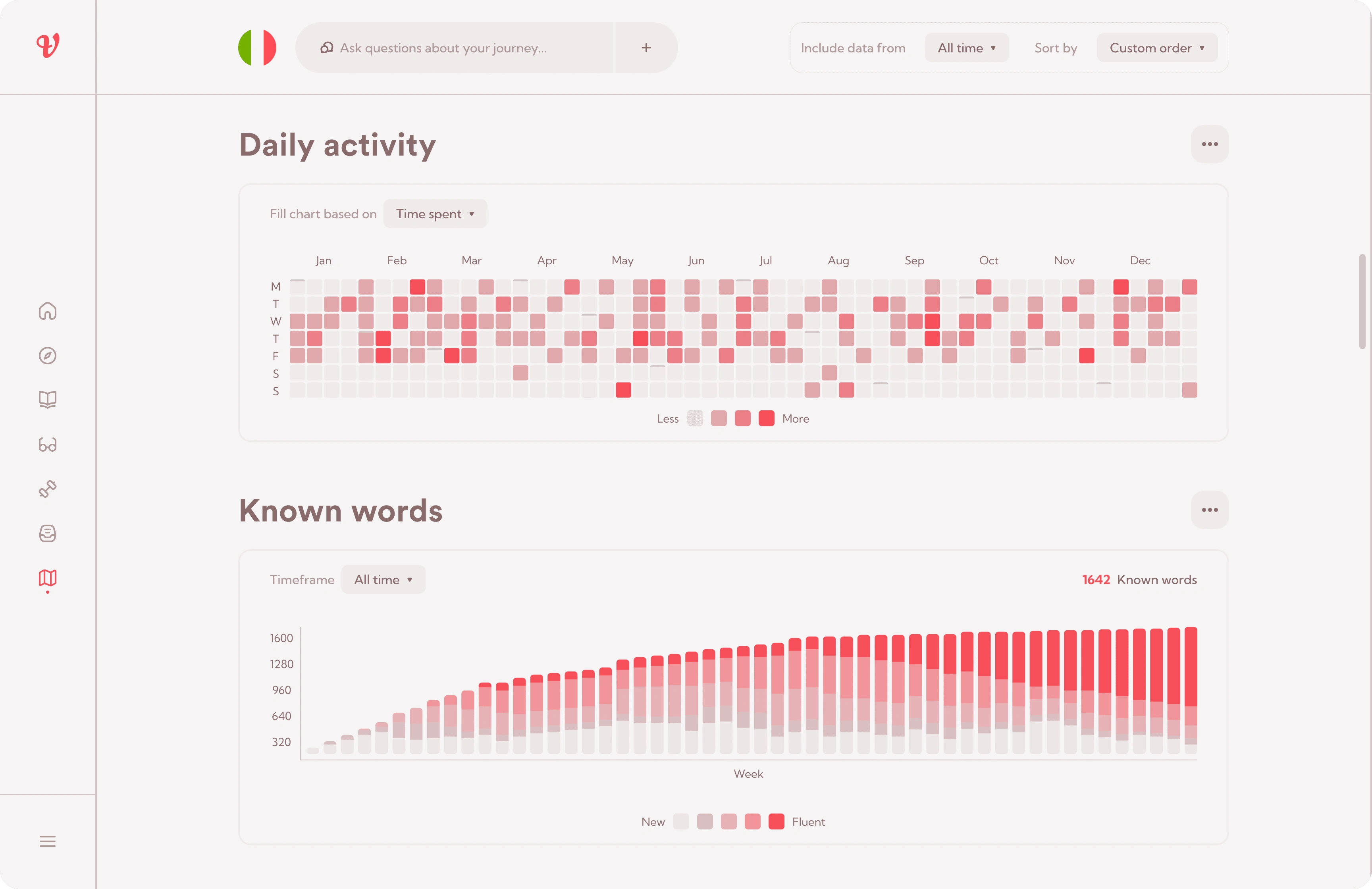
(similar to Code Interpreter in ChatGPT, students can also ask Verse to find patterns in their journey and share advice)
At last, the famous study list where all saved words and text selections go reveals itself.
As the control panel of the spaced repetition system in Verse, it provides a clear overview of the current fluency stage of all the words studied.
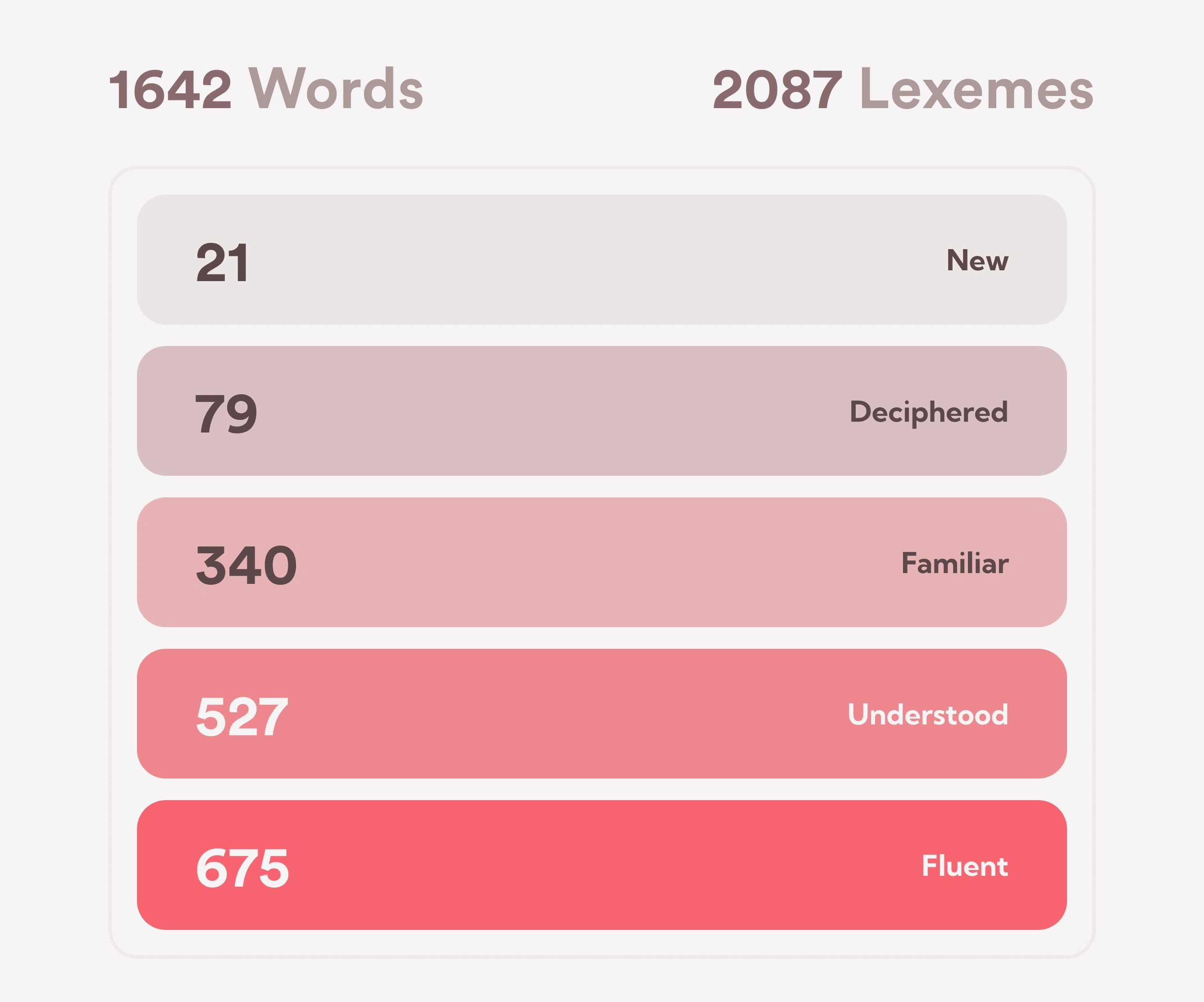
(lexemes are made up of one or more unique words, so only unique words are considered in the breakdown)
There's even a section, "Frequency Maps", where students can see how many of the most frequent words in the language they're studying they have already learned, and which they're still missing.
That can be very useful to get a rough sense of how much of most literary works in that language they'll be able to understand.
Students can even create a frequency map for their own writing.
They simply upload a representative sample of texts they wrote in their native language, and Verse will rank all words by how frequently they appear, then match them to their closest equivalents in the language they're learning to generate the map.
With a frequency map like that, students could get an overview of how much of the vocabulary they most rely on for expressing themselves in their native language they now also know in the language they're learning.
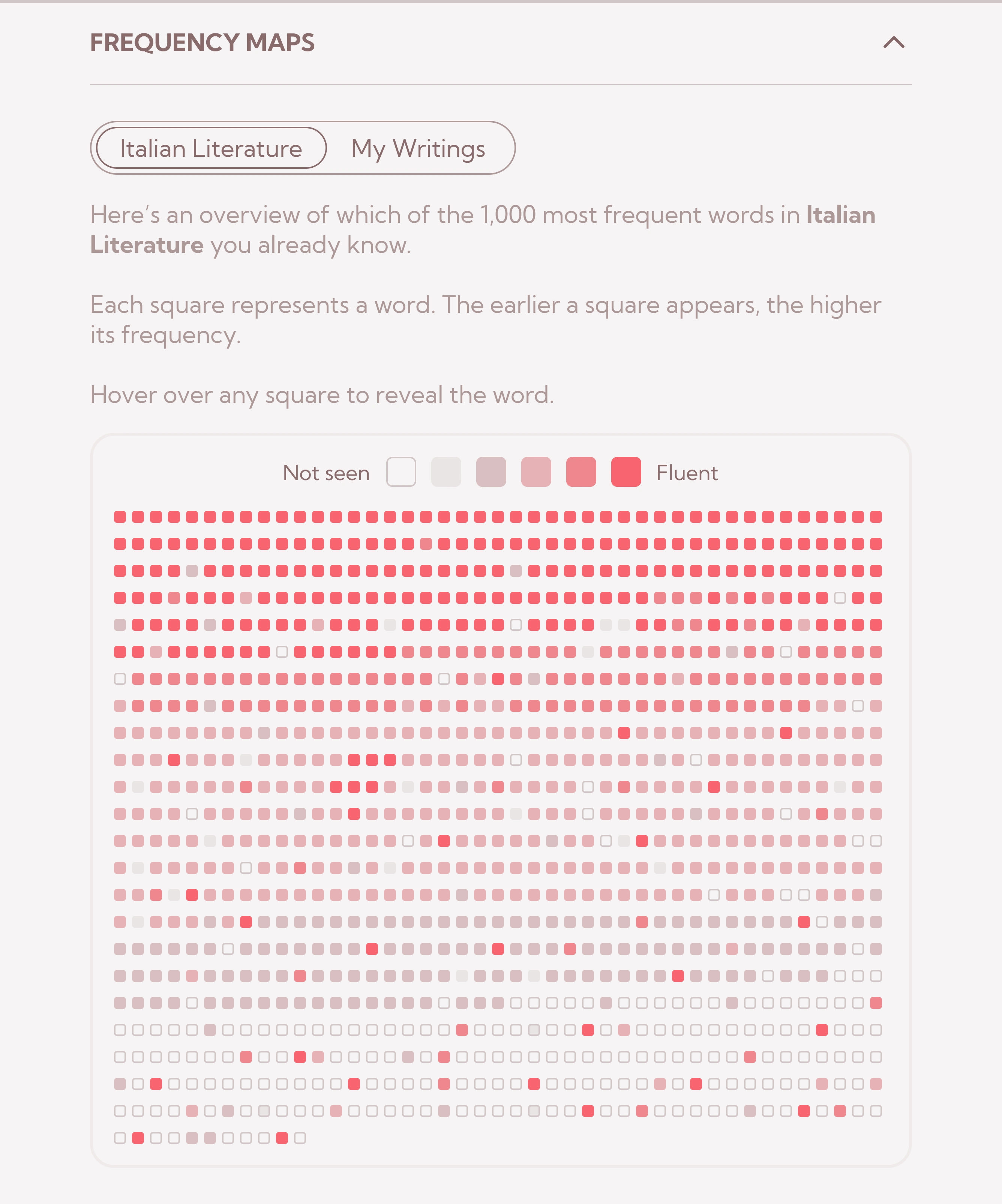
(for this example, I made a frequency map with the 1,000 most common words, but one for the top 3,000 would be better)
In any case, from this page, students could conveniently expand their vocabulary to cover the next 10 most frequent words they don't yet know.
Doing this early on can significantly reduce the time it takes students to be able to write things of their own. They can now learn some of the most useful words directly, without having to wait to run into them in the songs they study.
Learning just a few of the most important words can quickly enrich their knowledge without taking focus away from a juice-based learning experience.
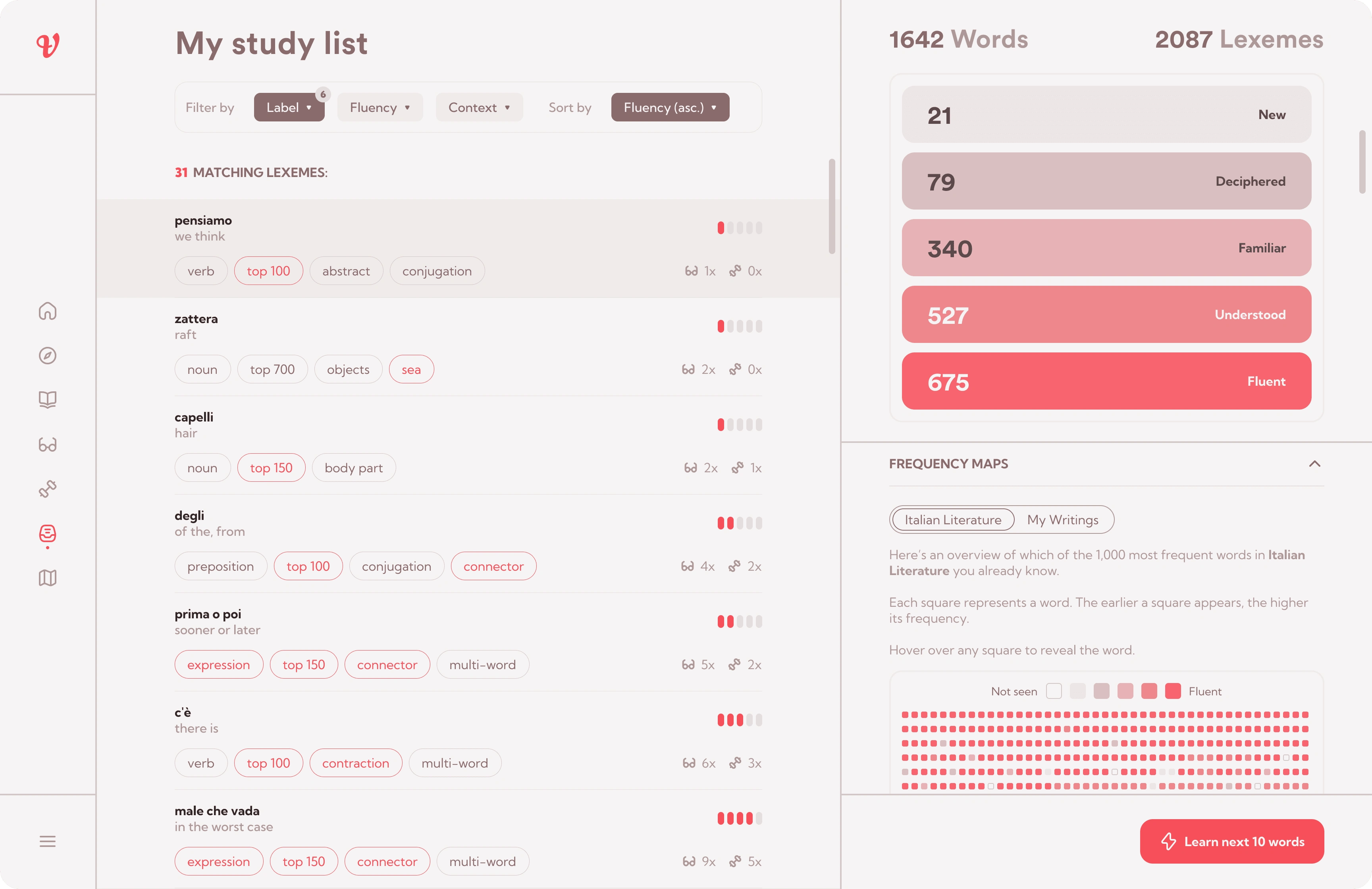
Students can also browse through all the lexemes they're studying, or use filters to narrow down the results.
Verse automatically tags every lexeme with relevant labels, and keeps track of where it appeared in the content students consumed. That way, they always have a handy list of real-life usage examples.
As always, the details module (lexeme details, in this case), contains a wealth of relevant information neatly organized in collapsible sections so users can conveniently find the details they want.

And, of course, as a vocabulary management page, here students can also edit and remove lexemes, or even start a custom review or application session with the ones they selected.
Since Verse automatically adds smart labels to every lexeme, this is also a great place to start a review of topic-specific vocabularies, like "verbs", "animals", "office", "hobbies", or others.
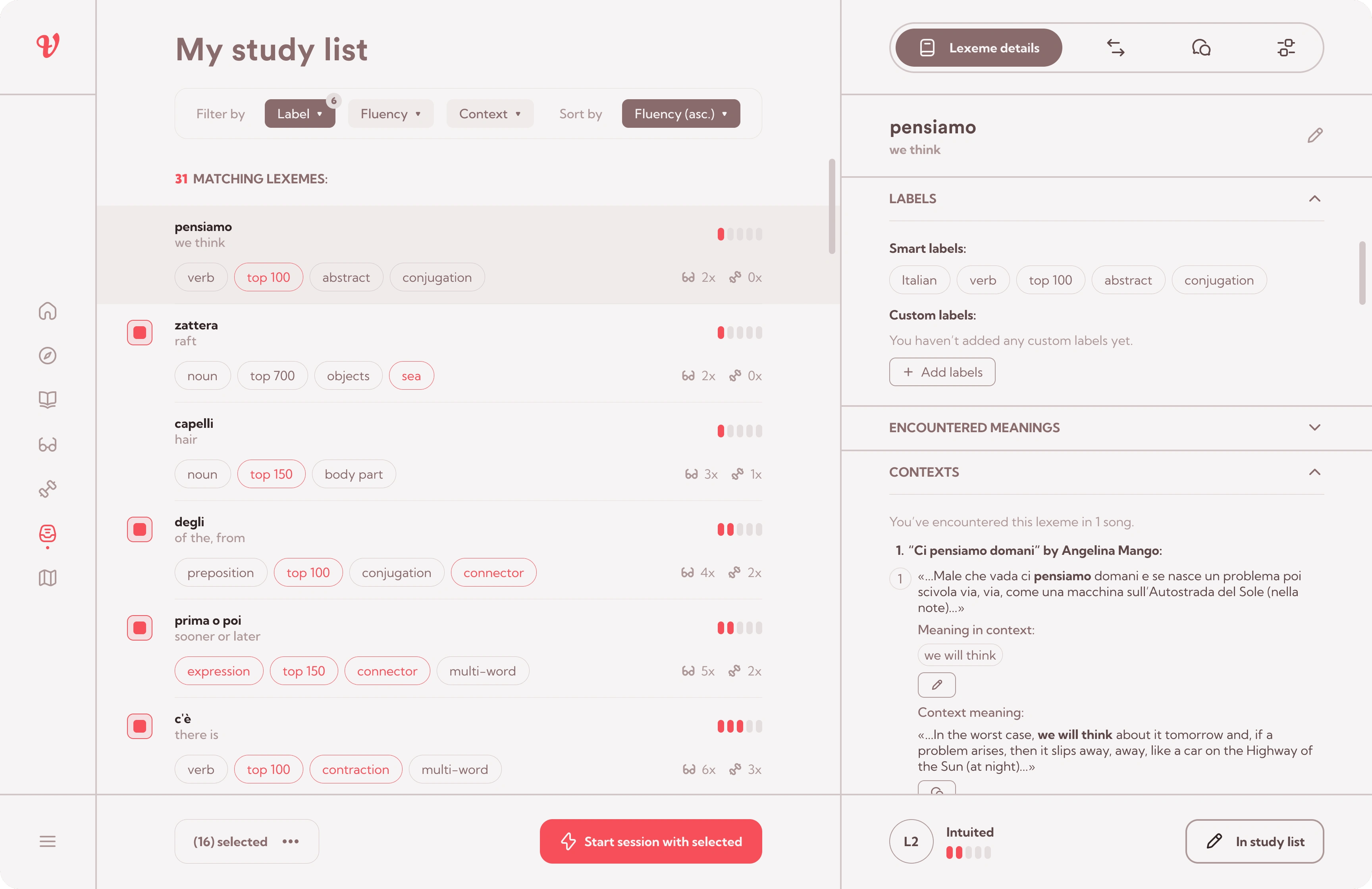
But, although students are always free to decide how they spend their time on Verse (whether that means studying a song, playing any of the 6 games, chatting with Verse AI, or something else), they don't need to come up with activities themselves.
The final link that ties everything we've seen so far together is the Home page.
There, users have a shortcut to do pretty much anything (from picking up their study of the last songs they were learning, to reading the day's recommended article from Verse's blog, or simply seeing where they stand relative to their goals at a glance.)
And, since all users set a daily study-time goal when they sign up, every day Verse creates a personalized action plan with tasks that fit within that time and address whatever they most need to do at that particular point in their learning journey.
No distractions, no getting lost.
Verse doesn't leave students on their own and it doesn't force all of them on the same path either.
Students can choose to do any activity they want, or they can jump straight onto Verse's tailored daily plan.
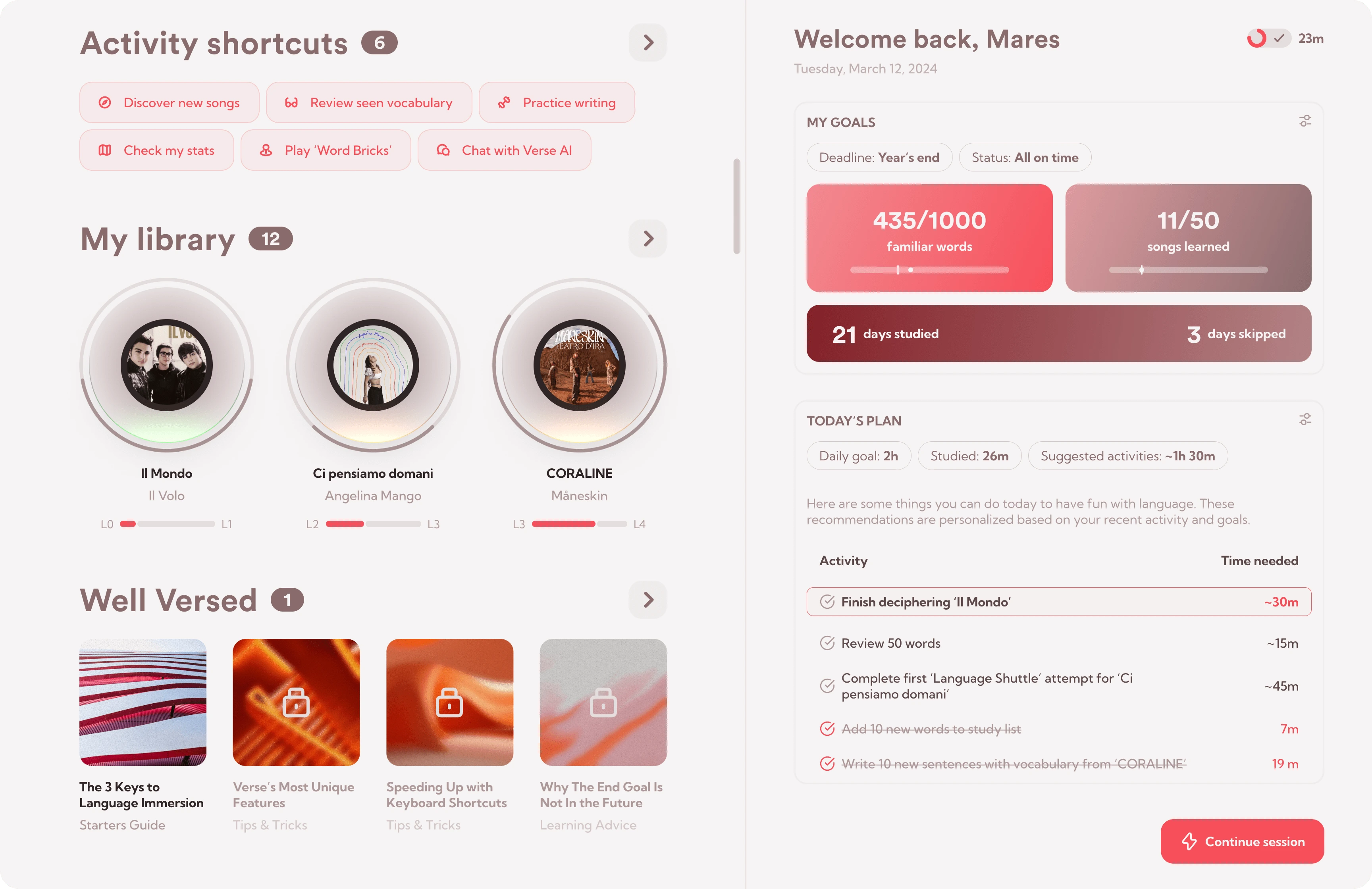
(students can configure which stats to show on the home page, and add details to tailor Verse's daily plan to their goals)
9. The journey is the destination
This concludes my presentation of Verse.
A year after finishing Duolingo and WaniKani, I felt deep regret.
It only took one year to forget almost everything I had learned.
All the countless hours. All the grueling effort. They all feel wasted. Lost to nothing.
But, looking back, it's not the forgotten vocabulary I lament most; it's the lack of songs, books, conversations, and stories that, even when I had it, I never indulged in.
Absorbed by vocabulary decks, review queues, and lessons detached from reality, I missed the juice around me and never took a sip.

Verse is a departure from that philosophy.
Counterintuitively, more than teaching students a language, I wanted Verse to help them get more joy from it.
I did not want to create yet another app that made students work towards "thens":
"After you learn Japanese, then you'll be able to read that book, then you'll sing along to that song, then you'll make friends from Japan, etc."
I wanted to give students the value and satisfaction in language from the start, and throughout, not at some distant, indefinite future.
I wanted the fact that "the more you understand about a language, the more you can enjoy it" to be the fuel that motivated them to improve, not some grade in a traditional exam nor the reaching of some arbitrary proficiency threshold.
Far more than experiences, we regret experiences not had.
Verse is then a love letter to language, and to all the richness of experiences it contains. My biggest hope with it is that it may help its users experience more of that richness.
And, though this first version only covers songs, its versatile architecture constitutes a strong foundation to gradually and seamlessly integrate more modules, sections, games, and, most certainly, more types of juice.
I hope I succeeded at designing a convenient juice-based solution that takes elegant care of all 3 phases of learning.
I hope I managed to make a delightful product the people it serves would love.
And finally, I hope I could redeem myself by creating a tool where people can learn a language without regrets.

10. Before you go...
I want to thank @mato_moscos for his excellent work drawing the illustrations that accompanied this case study.
I couldn't have asked for a better transformation of the barebone versions I gave him.
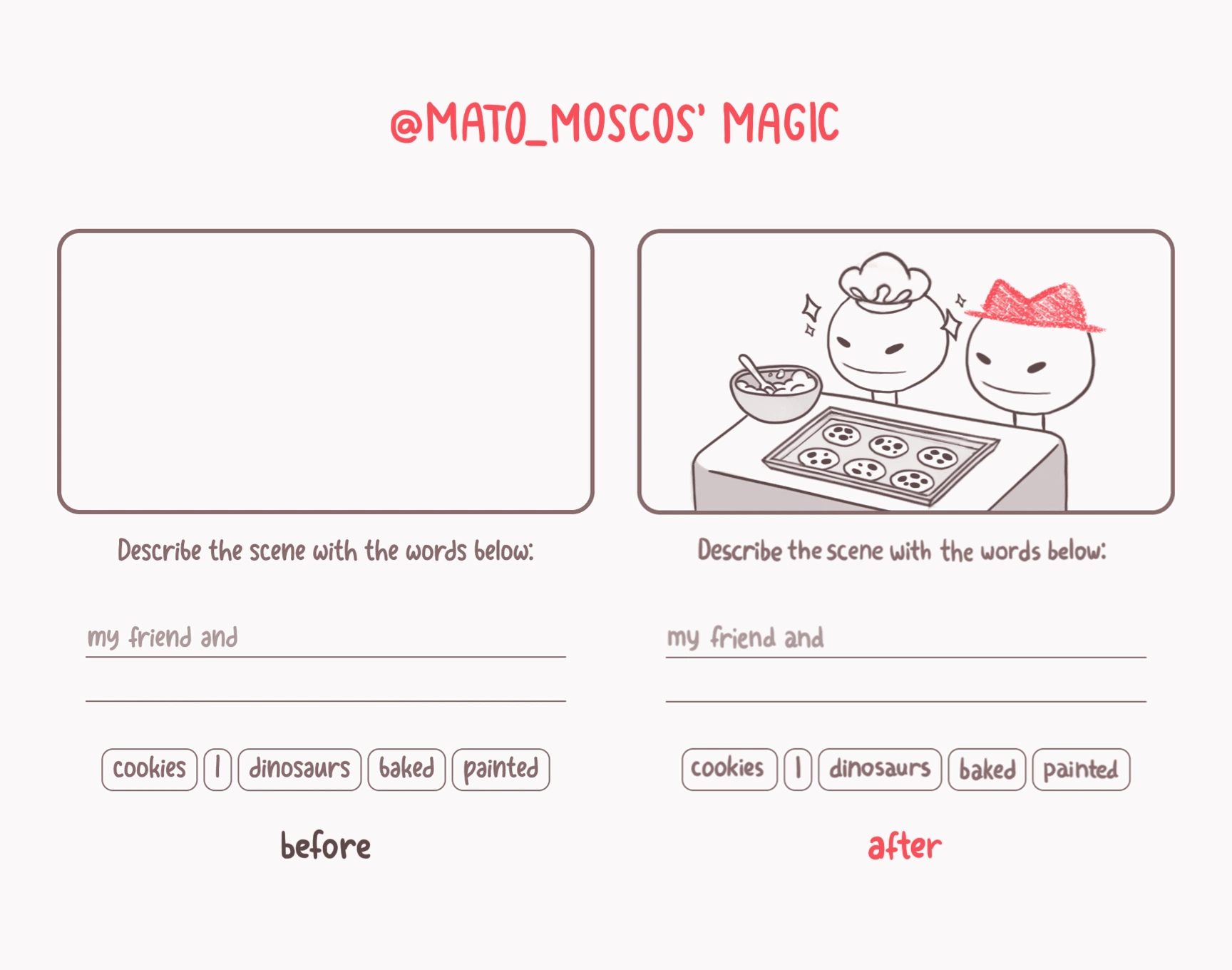
If you'd like him to illustrate your next blog article, don't hesitate to reach out to him.
And, if you have any feedback on this project or want me to help you design something great, I'd love to hear from you. You can reach me here on Contra.
I am always eager to create beautiful, high-quality products that strike the right balance of powerfulness, and simplicity.
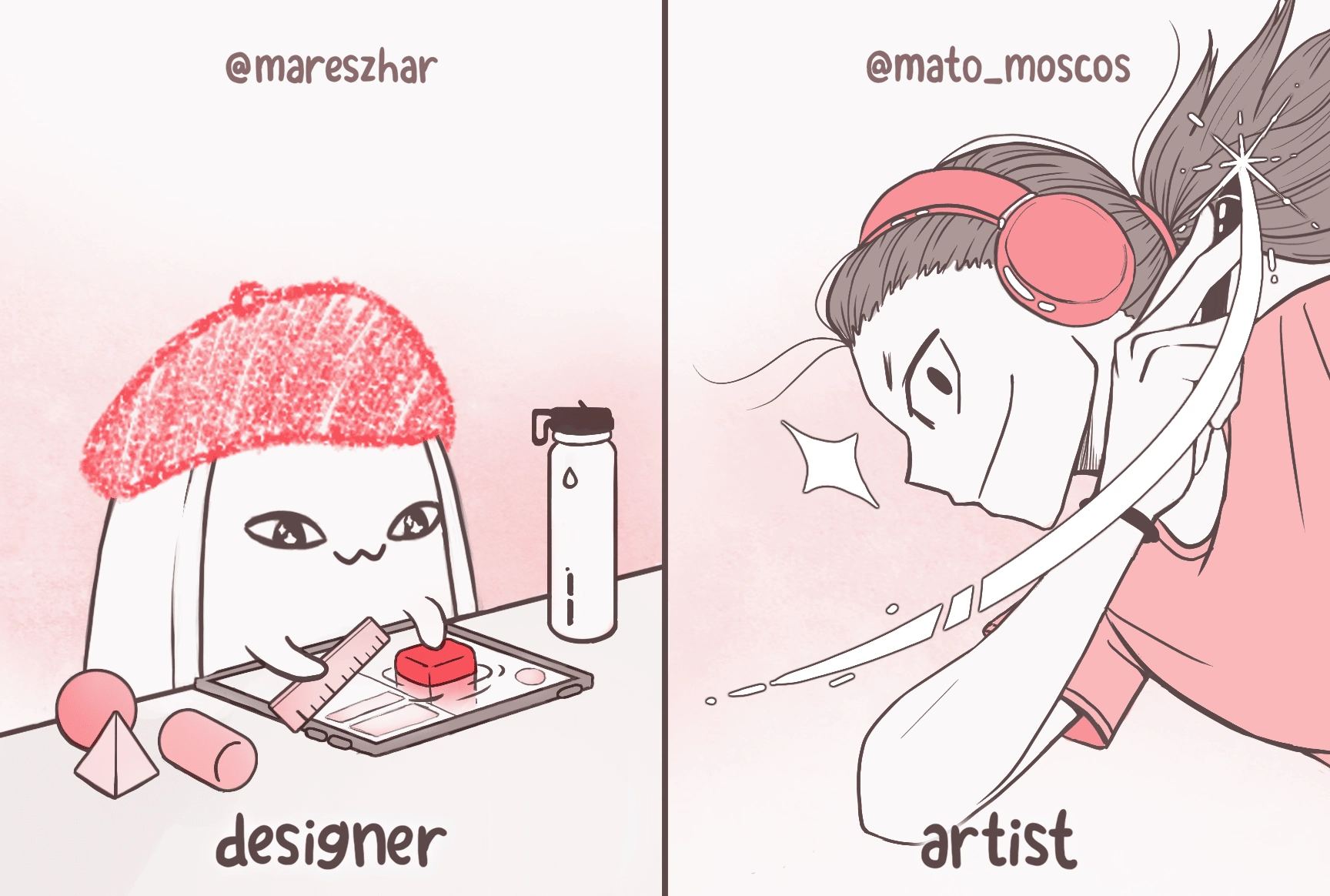
Thank you for reading ❤️!
PS: To be clear, today Verse is just a design concept. I have the skills to build a functional version, but at the moment lack the support and resources needed to make it on my own.
If you'd like Verse to exist or can support its development (whether financially, with code contributions, or in some other way), please reach out. I'll be elated you liked Verse and want to help make its vision a reality. Thank you again!! ^-^
Like this project
Posted Apr 30, 2024
Design of a powerful minimalist app to learn languages with songs.





